Paul van Yperen's Blog, page 102
December 18, 2022
The Eagle (1925)
This is the last of our three films specials about the work of Rudolph Valentino. The Eagle (Clarence Brown, 1924) is an American adventure film set in Imperial Russia under the reign of Catherine II. The screenplay is based on the novel 'Dubrovsky' by Russian author Alexander Pushkin. It was Valentino's penultimate film before his early death at 31 the next year and it was one of his best films.
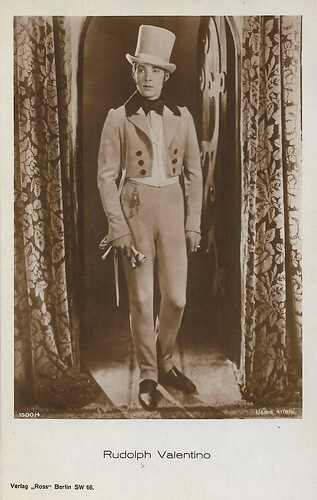
German postcard by Verlag Ross, Berlin, no. 1500/4, 1927-1928. Photo: United Artists. Rudolph Valentino in The Eagle (Clarence Brown, 1925).
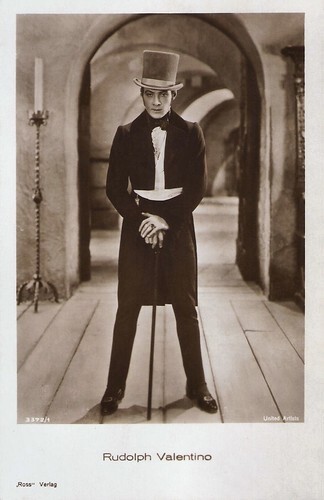
German postcard by Ross Verlag, no. 3372/1, 1928-1929. Photo: United Artists. Rudolph Valentino in The Eagle (Clarence Brown, 1925).
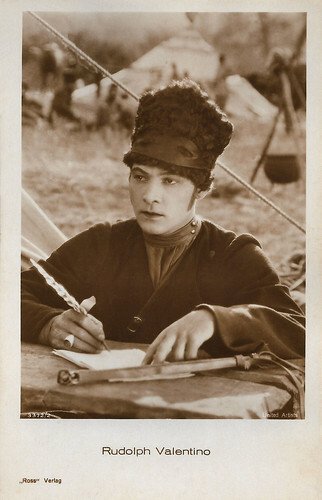
German postcard by Ross Verlag, 3372/2, 1928-1929. Photo: United Artists. Rudolph Valentino in The Eagle (Clarence Brown, 1925).
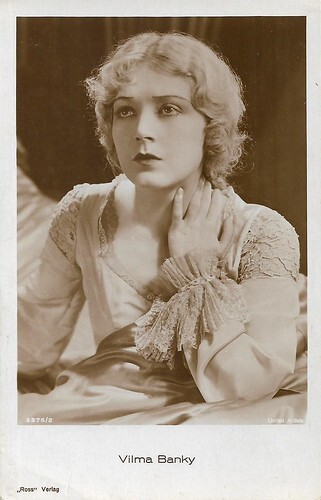
German postcard by Ross Verlag, no. 3376/2. Photo: United Artists. Vilma Bánky in The Eagle (Clarence Brown, 1925).
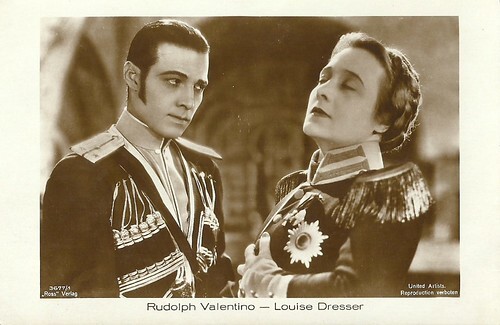
German postcard by Ross Verlag, no. 3677/1, 1928-1929. Photo: United Artists. Rudolph Valentino and Louise Dresser in The Eagle (Clarence Brown, 1925).
Dubrovsky is horrified, rejects her advances and flees
The screenplay for The Eagle (Clarence Brown, 1925) was written by George Marion jr. and Hanns Kräly based on the unfinished and posthumously published novel 'Dubrovsky' (Russian: «Дубровский») by Russian author Aleksandr Pushkin (Alexander Pushkin), written in 1832 and published in 1841. The 'Black Eagle' does not exist in the novel and was inspired by the recent success of Douglas Fairbanks as Zorro in The Mark of Zorro (Fred Niblo, 1920) and Robin Hood (Allan Dwan, 1922).
The Russian lieutenant Vladimir Dubrovsky ( Rudolph Valentino ), in the service of Her Majesty Czarina Catherine II (Louise Dresser), is a proud and brave Cossack. In his splendid uniform, he attracts the attention of many young ladies in love. But he has also attracted the attention of the Czarina - at the latest since Vladimir saved Mascha Troekouroff, a beautiful young lady, and her maiden Aunt Aurelia (Carrie Clark Ward) trapped in a runaway stagecoach.
Catherine the Great then wants to appoint Dubrovsky as a general, to which he is delighted. But when his ruler demands that he also becomes her lover, Dubrovsky is horrified, rejects her advances and flees. The Russian empress is furious, she is not used to such humiliation. Catherine then puts a death sentence on the unwilling Cossack's head and 5,000 rubles reward for the capture of Vladimir Dubrovsky for desertion.
Soon after, Vladimir receives terrible news from his father (Spottiswoode Aiken). The villainous nobleman Kyrilla Troekouroff (James A. Marcus) has unceremoniously seized the Dubrovskys' land and has been oppressing the local peasantry and terrorising the entire region ever since. Vladimir rushes home to find that his father has died. Vowing to avenge his father and help the victimised peasantry, he adopts a black mask and becomes the Black Eagle, a Robin Hood figure.
Posing as Monsieur LeBlanc, a French tutor, who has been sent for from France, but has not previously seen by anyone in the household, he enters the villain's home to gain his trust. To make matters worse, however, the 'black eagle' discovers that the Masha he once rescued is the daughter of the land robber and oppressor Troekouroff, Maja Troekouroff ( Vilma Bánky ), and he falls in love with her.
Between Vladimir, the rebel, and Masha, the daughter of the hated enemy, love grows, and Vladimir becomes more and more reluctant to continue seeking revenge against her father. Finally, the young lovers decide to flee. In the process, the Black Eagle falls into the clutches of Catherine's henchmen. The Czarina is still full of wrath towards her unruly Cossack lieutenant and initially plans to have him executed. But in the face of young fortune, she lets him go, on the condition that he leaves Russia with a new (French) name. Both young people then go to Paris and find happiness there.
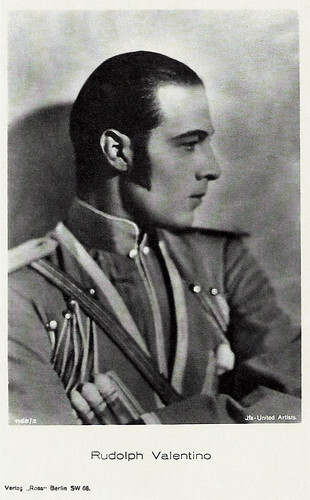
Dutch-German postcard by Ross Verlag, no. 1168/2, 1927-1928. Photo: Ifa / United Artists. Rudolph Valentino in The Eagle (Clarence Brown, 1925). This vintage postcard contains Dutch text on the backside.
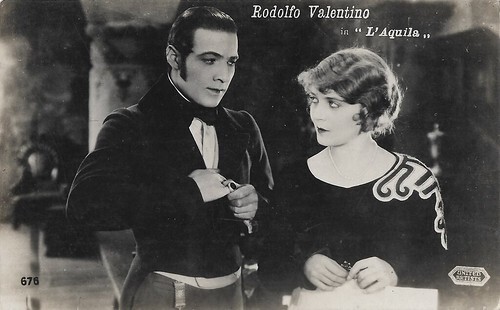
Italian postcard by Casa Ed. Ballerini & Fratini, Firenze, no. 676. Photo: United Artists. Rudolph Valentino and Vilma Bánky in The Eagle (Clarence Brown, 1925).
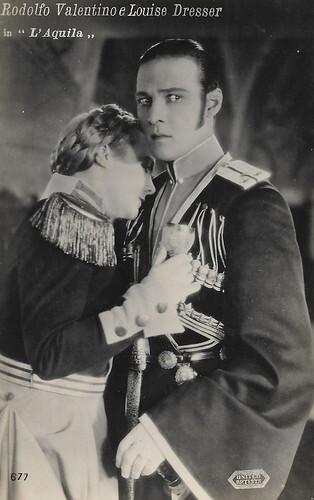
Italian postcard by Ed. Ballerini & Fratini, Firenze, no. 677. Photo: United Artists. Rudolph Valentino and Louise Dresser in The Eagle (Clarence Brown, 1925).
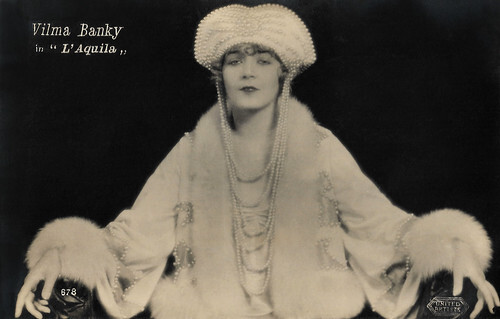
Italian postcard by Casa Ed. Ballerini & Fratini, Firenze, no. 678. Photo: United Artists. Vilma Bánky in The Eagle (Clarence Brown, 1925).
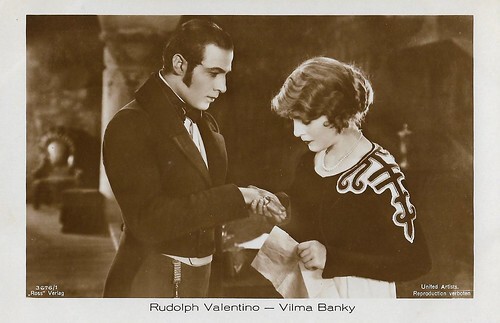
German postcard by Ross Verlag, no. 3676/1, 1928-1929. Photo: United Artists. Rudolph Valentino and Vilma Bánky in The Eagle (Clarence Brown, 1925).
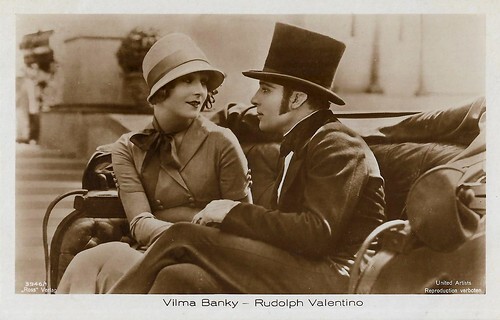
German postcard by Ross Verlag, no. 3946/1, 1928-1929. Photo: United Artists. Rudolph Valentino and Vilma Bánky in The Eagle (Clarence Brown, 1925).
Valentino at his most natural and appealing
Rudolph Valentino 's last few films had not been particularly well received, but The Eagle (Clarence Brown, 1925), produced by John W. Considine, Jr., proved a strong comeback for him. The Eagle(1925) also marked Vilma Bánky 's breakthrough in Hollywood. And in a tiny, unnamed role as a masked cossack, the then-unknown Gary Cooper can be seen.
The film sets for The Eagle (Clarence Brown, 1925) were made by William Cameron Menzies, and the costumes were designed by Adrian. The film was a success at the box office and The Eagle gained good reviews from the critics.
In The New York Times, Mordaunt Hall wrote at the time: "Mr. Valentino is indeed fortunate to have obtained the services of Vilma Bánky , thanks to Samuel Goldwyn, as Miss Banky is so lovely to look at that her beauty makes the hero's gallantry all the more convincing. In this production, which would have fitted well with some film celebrities such as the agile Douglas Fairbanks, Mr Valentino holds his own with flying colours. His appearance draws benefits from Clarence Brown's direction and a grateful addition from Miss Banky, a valuable asset in this film. It was also a brilliant idea to enlist Hanns Kräly, Mr. Lubitsch's clever writer, who penned the screenplay for The Eagle".
Some 90 years later, Janiss Garza at AllMovie is also positive about the film and its star: " Rudolph Valentino is at his most natural and appealing in this swashbuckler. He wears the period costumes, from the Cossack uniforms to the formal French jacket and trousers, as if they were his second skin, moving in them with a dancer's grace and casual sexuality. His Vladimir Dubrovsky is played with wit, humour, and humanity -- a revelation when compared to the stiff posturing of much of his earlier work. In addition, the star is helped at every angle: The story is action-packed and entertaining, the direction intelligent, and the cinematography (courtesy of George Barnes) is some of the most poetic of the silent era (in addition, the banquet scene contains one of the most impressive tracking shots of the 1920s)."
The Eagle (Clarence Brown, 1925) was Valentino's penultimate film, made a year before his death in 1926. Because Valentino and the Hungarian-born Vilma Bánky worked so well together in The Eagle, they were reunited again in Valentino's final film, Son of the Sheik (1926). It would become an even bigger smash. Sadly, after the release of their second pairing, Valentino stunned the world when he died at the age of 31.
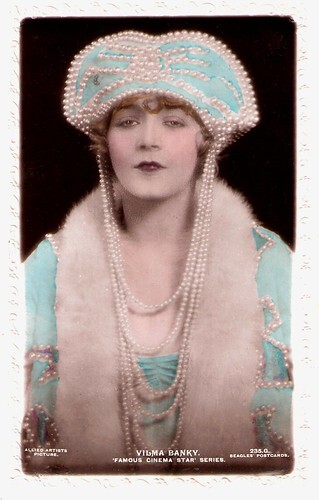
British postcard by J. Beagles & Co, LTD., London, no. 235 G. 'Famous Cinema Star' series. Photo: Allied Artists Pictures.
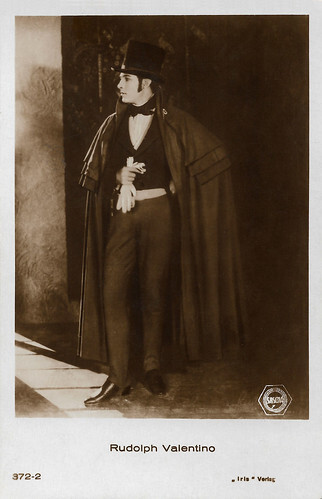
Austrian postcard by Iris Verlag, no. 372/2. Photo: Sascha Film. Rudolph Valentino in The Eagle (Clarence Brown, 1925).
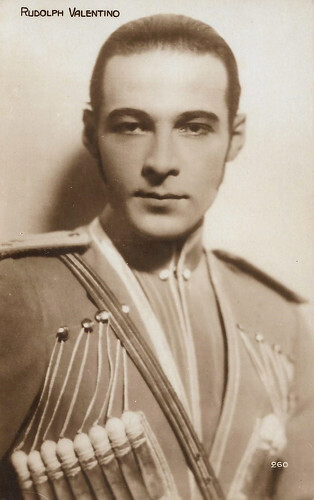
French postcard by Editions Cinémagazine, no. 260. Rudolph Valentino in The Eagle (Clarence Brown, 1925).
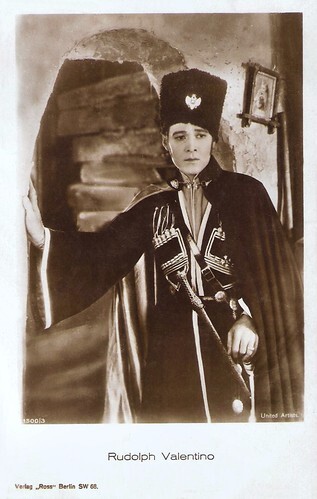
German postcard by Ross Verlag, no. 1500/3, 1927-1928. Photo: United Artists. Rudolph Valentino in The Eagle (Clarence Brown, 1925).
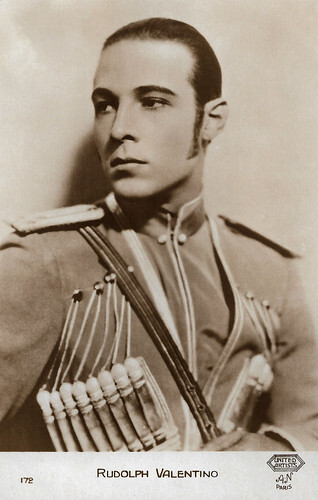
French postcard by A.N., Paris, no. 172. Photo: United Artists. Rudolph Valentino in The Eagle (Clarence Brown, 1925).
Sources: Hal Erickson (AllMovie), Wikipedia (German, Dutch and English), and IMDb.

German postcard by Verlag Ross, Berlin, no. 1500/4, 1927-1928. Photo: United Artists. Rudolph Valentino in The Eagle (Clarence Brown, 1925).

German postcard by Ross Verlag, no. 3372/1, 1928-1929. Photo: United Artists. Rudolph Valentino in The Eagle (Clarence Brown, 1925).

German postcard by Ross Verlag, 3372/2, 1928-1929. Photo: United Artists. Rudolph Valentino in The Eagle (Clarence Brown, 1925).

German postcard by Ross Verlag, no. 3376/2. Photo: United Artists. Vilma Bánky in The Eagle (Clarence Brown, 1925).

German postcard by Ross Verlag, no. 3677/1, 1928-1929. Photo: United Artists. Rudolph Valentino and Louise Dresser in The Eagle (Clarence Brown, 1925).
Dubrovsky is horrified, rejects her advances and flees
The screenplay for The Eagle (Clarence Brown, 1925) was written by George Marion jr. and Hanns Kräly based on the unfinished and posthumously published novel 'Dubrovsky' (Russian: «Дубровский») by Russian author Aleksandr Pushkin (Alexander Pushkin), written in 1832 and published in 1841. The 'Black Eagle' does not exist in the novel and was inspired by the recent success of Douglas Fairbanks as Zorro in The Mark of Zorro (Fred Niblo, 1920) and Robin Hood (Allan Dwan, 1922).
The Russian lieutenant Vladimir Dubrovsky ( Rudolph Valentino ), in the service of Her Majesty Czarina Catherine II (Louise Dresser), is a proud and brave Cossack. In his splendid uniform, he attracts the attention of many young ladies in love. But he has also attracted the attention of the Czarina - at the latest since Vladimir saved Mascha Troekouroff, a beautiful young lady, and her maiden Aunt Aurelia (Carrie Clark Ward) trapped in a runaway stagecoach.
Catherine the Great then wants to appoint Dubrovsky as a general, to which he is delighted. But when his ruler demands that he also becomes her lover, Dubrovsky is horrified, rejects her advances and flees. The Russian empress is furious, she is not used to such humiliation. Catherine then puts a death sentence on the unwilling Cossack's head and 5,000 rubles reward for the capture of Vladimir Dubrovsky for desertion.
Soon after, Vladimir receives terrible news from his father (Spottiswoode Aiken). The villainous nobleman Kyrilla Troekouroff (James A. Marcus) has unceremoniously seized the Dubrovskys' land and has been oppressing the local peasantry and terrorising the entire region ever since. Vladimir rushes home to find that his father has died. Vowing to avenge his father and help the victimised peasantry, he adopts a black mask and becomes the Black Eagle, a Robin Hood figure.
Posing as Monsieur LeBlanc, a French tutor, who has been sent for from France, but has not previously seen by anyone in the household, he enters the villain's home to gain his trust. To make matters worse, however, the 'black eagle' discovers that the Masha he once rescued is the daughter of the land robber and oppressor Troekouroff, Maja Troekouroff ( Vilma Bánky ), and he falls in love with her.
Between Vladimir, the rebel, and Masha, the daughter of the hated enemy, love grows, and Vladimir becomes more and more reluctant to continue seeking revenge against her father. Finally, the young lovers decide to flee. In the process, the Black Eagle falls into the clutches of Catherine's henchmen. The Czarina is still full of wrath towards her unruly Cossack lieutenant and initially plans to have him executed. But in the face of young fortune, she lets him go, on the condition that he leaves Russia with a new (French) name. Both young people then go to Paris and find happiness there.

Dutch-German postcard by Ross Verlag, no. 1168/2, 1927-1928. Photo: Ifa / United Artists. Rudolph Valentino in The Eagle (Clarence Brown, 1925). This vintage postcard contains Dutch text on the backside.

Italian postcard by Casa Ed. Ballerini & Fratini, Firenze, no. 676. Photo: United Artists. Rudolph Valentino and Vilma Bánky in The Eagle (Clarence Brown, 1925).

Italian postcard by Ed. Ballerini & Fratini, Firenze, no. 677. Photo: United Artists. Rudolph Valentino and Louise Dresser in The Eagle (Clarence Brown, 1925).

Italian postcard by Casa Ed. Ballerini & Fratini, Firenze, no. 678. Photo: United Artists. Vilma Bánky in The Eagle (Clarence Brown, 1925).

German postcard by Ross Verlag, no. 3676/1, 1928-1929. Photo: United Artists. Rudolph Valentino and Vilma Bánky in The Eagle (Clarence Brown, 1925).

German postcard by Ross Verlag, no. 3946/1, 1928-1929. Photo: United Artists. Rudolph Valentino and Vilma Bánky in The Eagle (Clarence Brown, 1925).
Valentino at his most natural and appealing
Rudolph Valentino 's last few films had not been particularly well received, but The Eagle (Clarence Brown, 1925), produced by John W. Considine, Jr., proved a strong comeback for him. The Eagle(1925) also marked Vilma Bánky 's breakthrough in Hollywood. And in a tiny, unnamed role as a masked cossack, the then-unknown Gary Cooper can be seen.
The film sets for The Eagle (Clarence Brown, 1925) were made by William Cameron Menzies, and the costumes were designed by Adrian. The film was a success at the box office and The Eagle gained good reviews from the critics.
In The New York Times, Mordaunt Hall wrote at the time: "Mr. Valentino is indeed fortunate to have obtained the services of Vilma Bánky , thanks to Samuel Goldwyn, as Miss Banky is so lovely to look at that her beauty makes the hero's gallantry all the more convincing. In this production, which would have fitted well with some film celebrities such as the agile Douglas Fairbanks, Mr Valentino holds his own with flying colours. His appearance draws benefits from Clarence Brown's direction and a grateful addition from Miss Banky, a valuable asset in this film. It was also a brilliant idea to enlist Hanns Kräly, Mr. Lubitsch's clever writer, who penned the screenplay for The Eagle".
Some 90 years later, Janiss Garza at AllMovie is also positive about the film and its star: " Rudolph Valentino is at his most natural and appealing in this swashbuckler. He wears the period costumes, from the Cossack uniforms to the formal French jacket and trousers, as if they were his second skin, moving in them with a dancer's grace and casual sexuality. His Vladimir Dubrovsky is played with wit, humour, and humanity -- a revelation when compared to the stiff posturing of much of his earlier work. In addition, the star is helped at every angle: The story is action-packed and entertaining, the direction intelligent, and the cinematography (courtesy of George Barnes) is some of the most poetic of the silent era (in addition, the banquet scene contains one of the most impressive tracking shots of the 1920s)."
The Eagle (Clarence Brown, 1925) was Valentino's penultimate film, made a year before his death in 1926. Because Valentino and the Hungarian-born Vilma Bánky worked so well together in The Eagle, they were reunited again in Valentino's final film, Son of the Sheik (1926). It would become an even bigger smash. Sadly, after the release of their second pairing, Valentino stunned the world when he died at the age of 31.

British postcard by J. Beagles & Co, LTD., London, no. 235 G. 'Famous Cinema Star' series. Photo: Allied Artists Pictures.

Austrian postcard by Iris Verlag, no. 372/2. Photo: Sascha Film. Rudolph Valentino in The Eagle (Clarence Brown, 1925).

French postcard by Editions Cinémagazine, no. 260. Rudolph Valentino in The Eagle (Clarence Brown, 1925).

German postcard by Ross Verlag, no. 1500/3, 1927-1928. Photo: United Artists. Rudolph Valentino in The Eagle (Clarence Brown, 1925).

French postcard by A.N., Paris, no. 172. Photo: United Artists. Rudolph Valentino in The Eagle (Clarence Brown, 1925).
Sources: Hal Erickson (AllMovie), Wikipedia (German, Dutch and English), and IMDb.
Published on December 18, 2022 22:00
December 17, 2022
Peter Finch
Peter Finch (1916-1977) was a British film and theatre actor who became a film star appreciated by critics and audiences alike from the 1950s onwards. Finch received the first of his two Best Actor Academy Award nominations for his role as a homosexual doctor involved in a love triangle with a bisexual man and a straight woman in John Schlesinger's Sunday Bloody Sunday (1971). He received a posthumous Oscar in 1977 for his portrayal of the mad newscaster Howard Beale in Sidney Lumet's satire Network (1976).
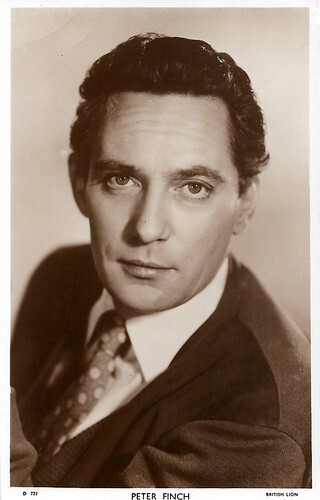
British postcard in the Picturegoer Series, London, no. D 722. Photo: British Lion.

American postcard by Fotofolio, NY, NY, no. P 348. Photo: Phil Stern. Peter Finch in The Flight of the Phoenix (Robert Aldrich, 1965).
"If I was broke anyway, I might as well become an actor"
Peter Finch was born Frederick Peter Ingle-Finch in 1916 in London, Great Britain. Finch was the illegitimate child of Alicia Gladys Fisher and Wentworth Edward Dallas "Jock" Campbell, a Scottish Military officer. His mother was married at the time to Australian-born chemist and mountaineer George Ingle Finch, who officially assumed paternity.
After his parents' early divorce, Peter Finch grew up mostly with relatives in France, India and finally in his parents' native Australia. He grew up in Sydney, New South Wales. Finch didn't meet his mother until he was 33, and his natural father until he was 45.
After leaving school, he took numerous low-paid odd jobs in Sydney, including a brief spell as a reporter on the Sydney Sun. He eventually decided to become an actor. He later commented, "If I was broke anyway, I might as well become an actor." He first found employment in sketches within vaudeville shows. By the mid-1930s, Finch began to play more serious roles in the theatre and started to work in radio.
Finch's first on-screen performance was as Prince Charming in The Magic Shoes (Claude Fleming, 1935). The Australian short film was an adaptation of the Cinderella fairy-tale, and also starred Helen Hughes, the daughter of the Australian Prime Minister Morris Hughes. In 1938 Finch made his feature film screen debut in Dad and Dave Come to Town (Ken Hall, 1938). Other roles in Australian cinema followed, though without initially attracting international attention. He did, however, become one of the most popular actors in radio dramas in Australia, thanks to his pleasant voice.
From 1941 to 1945 he served with the Australian Imperial Force in World War II, partly in troop entertainment, and was latterly in the rank of sergeant. During one of his stage appearances shortly after the end of the war, he was spotted by Laurence Olivier who was conducting a tour of Australia with his theatrical company. He brought Finch to London to the Old Vic Theatre, where Olivier was artistic director at the time. Finch later had an affair with Olivier's wife, the actress Vivien Leigh . In London, Finch was soon able to make a name for himself in stage roles, for example in 1949 with a performance in 'Daphne Laureola' alongside Edith Evans, which received a standing ovation.
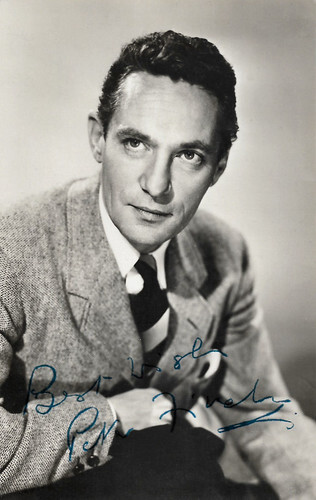
British publicity photo by J. Rank Organisation. Original signature.
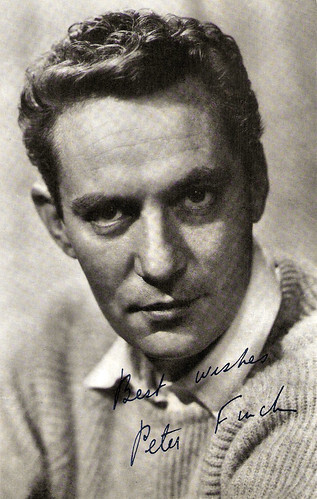
British postcard in the Celebrity Autograph Series by Celebrity Publishers LTD., London, no. 246. Photo: J. Arthur Rank Organisation. Peter Finch in Simon and Laura (Muriel Box, 1955).
Propelled to stardom in British cinema
However, as Peter Finch had severe stage fright, from the 1950s onward he concentrated primarily on his film career, which had been sluggish until then. His first British production was Eureka Stockade (Harry Watt, 1949), although here he was still in a supporting role.
A year later he made a minor appearance in the Hollywood drama The Miniver Story (H.C. Potter, 1950), the sequel to the war drama Mrs. Miniver (William Wyler, 1942), both starring Greer Garson . In 1952, his portrayal of the Sheriff of Nottingham opposite Richard Todd in Walt Disney's The Story of Robin Hood and His Merrie Men (Ken Annakin, 1952) received some attention. This was followed by a series of leading roles that propelled him to stardom in British cinema in the mid-1950s.
In 1954, he signed a seven-year contract with the Rank Organisation worth £87,500 to make one film a year for them. "We are going to build Peter into a major British star", said Earl St. John, Rank's head of production, at the time. He protrayed an Australian soldier in the World War II drama A Town Like Alice (Jack Lee, 1956) starring Virginia McKenna . The film, mostly set in Malaya and almost entirely shot at Pinewood Studios, became the third-most-popular film at the British box office in 1956 and earned him his first British Film Academy Award (BAFTA) for Best Actor in 1956. He later received the award three more times.
Finch's other roles included Elizabeth Taylor 's husband in Elephant Walk (William Dieterle, 1954), the villain Flambeau in Father Brown (Robert Hamer, 1954) starring Alec Guinness , and German Captain Hans Langsdorff in The Battle of the River Plate (Michael Powell, Emeric Pressburger, 1957) about the first major naval battle of World War II in which the British Navy destroyed the Graf Spee, a powerful German warship. This war film was also hugely popular in Great Britain, and British exhibitors voted Finch the seventh-most-popular British star at the box office for 1956.
Then Finch played an atheist medical doctor alongside Audrey Hepburn 's nun in The Nun's Story (Fred Zinnemann, 1959). It is the melancholy tale of a young missionary working as a nurse in the Belgian Congo during WW II. The film was based on the novel by Kathryn Hulme that told the story of the real-life nun, Marie-Louise Habets. Especially this film, a huge financial and critical success, boosted Finch's international reputation.
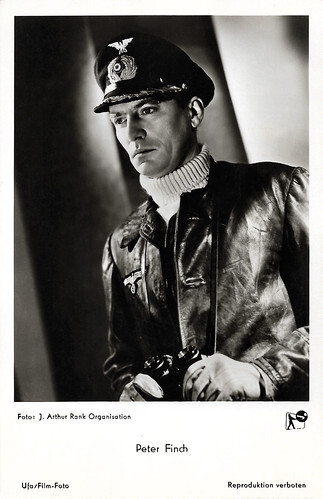
West-German postcard by Ufa/Film-Foto, Berlin-Tempelhof, no. FK 3548 Photo: J. Arthur Rank Organisation. Peter Finch in The Battle of the River Plate (Michael Powell, Emeric Pressburger, 1956).
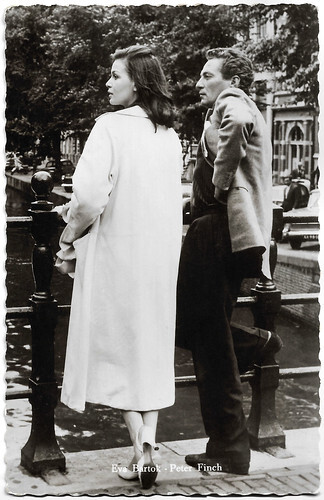
Dutch postcard. Photo: Rank. Eva Bartok and Peter Finch in Amsterdam during the shooting of the British war-time diamond thriller Operation Amsterdam (Michael McCarthy, 1959). The film was produced by Maurice Cowan and Rank and distributed by Rank and 20th Century Fox.
A sought-after character actor in international cinema
In the course of the 1960s, Peter Finch succeeded in positioning himself increasingly as a sought-after character actor in international cinema. At the 1961 Berlinale, he was awarded the Silver Bear for Best Actor for his portrayal of a politician in crisis, both personally and professionally, in No Love for Johnnie by Ralph Thomas.
He also received much praise for his portrayal of Oscar Wilde in The Man with the Green Carnation/The Trials of Oscar Wilde (Ken Hughes, 1960) on the libel and subsequent criminal cases involving Wilde and the Marquess of Queensberry. Finch won another BAFTA for his role and the film won the Golden Globe Award for Best English-Language Foreign Film, but the film was not popular at the box-offices.
Internationally, Finch played British officer Harris in Robert Aldrich's survival drama The Flight of the Phoenix (1965) and Italian general Umberto Nobile in the expensive Soviet/Italian adventure film Krasnaya palatka/The Red Tent (Mikhail Kalatozov, 1969) based on the story of the 1928 mission to rescue Umberto Nobile and the other survivors of the crash of the airship Italia. It features Sean Connery as Roald Amundsen. Finch also appeared in military roles in other films.
In 1960, Finch tried his hand behind the camera for once when he made the semi-documentary style short film The Day about the life of a boy on the island of Ibiza. The Day was well received at film festivals, but it was to remain his only directorial effort.
In Britain at this time, Peter Finch was one of a group of already established actors who had no inhibitions about working with the innovative directors of the British New Wave. He often played intelligent and reserved characters here, for example, a writer in a love affair with a younger woman in Desmond Davis' Girl with Green Eyes (1964) and the lonely farmer William Boldwood opposite Julie Christie in John Schlesinger's romantic drama Far from the Madding Crowd (1967) based on Thomas Hardy's novel 'On the Green Edge of the World'.
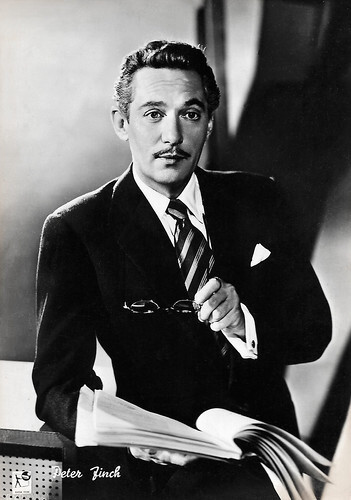
Italian postcard by Bromofoto, Milano, no. 1143 Photo: Rank. Peter Finch in Simon and Laura (Muriel Box, 1955).
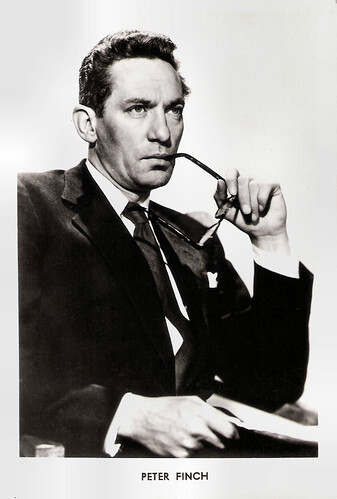
Belgian postcard, no. 5457.
The first film star to be seen in a gay film kiss
In 1971 Peter Finch worked with Schlesinger again for the film drama Sunday, Bloody Sunday (John Schlesinger, 1971), for which he received his first Oscar nomination, in the category of Best Actor in a Leading Role. Finch inherited the role of a gay doctor who shares his younger lover (Murray Head) with a woman ( Glenda Jackson ) from Alan Bates , who wanted to do it but couldn't due to his being held up filming The Go-Between (Joseph Losey, 1971). His replacement, Ian Bannen was fired at the beginning of the shooting due to his stated concern that portraying a homosexual engaged in the first screen kiss between two men might damage or destroy his career. Finch spontaneously replaced Bannen and unhesitatingly threw himself into the role. He kissed co-star Murray Head and received an Oscar nomination for his performance. For playing the role brilliantly, Finch won the BAFTA and National Society of Film Critics Awards prizes for Best Actor but lost the Oscar to eventual winner Gene Hackman.
Finch's subsequent film projects were less successful, however, as were his two films with Liv Ullmann : the spectacularly flopped musical Lost Horizon (Charles Jarrott, 1973) and the historical film The Abdication (Anthony Harvey, 1974). In the historical war film Bequest to the Nation (James Cellan Jones, 1973), he portrayed British General Horatio Nelson.
Shortly before his death, Peter Finch hit the screens with a television film, Raid on Entebbe (Irvin Kershner, 1976), in which he played Yitzchak Rabin, and was on a promotional tour for his latest feature film, the media satire Network (Sidney Lumet, 1976). In 1977, Finch died of a heart attack suffered in the lobby of the Beverly Hills Hotel in Los Angles at the age of 60. Only one day before, he appeared on The Tonight Show Starring Johnny Carson on U.S. network television NBC, entertaining the host and the audience with tales of his youth, his 'psychic' grandmother and, eerily, a joke about dying from a heart attack.
A few months later, he won the Academy Award for Best Actor in a Leading Role for his portrayal of Howard Beale, a television host gone mad, in Network. The award was accepted by his widow Eletha Finch. Finch and Heath Ledger are the only actors to date to receive the Oscar posthumously. The scenes in which Finch's character preaches his wisdom to the television audience are among the most famous of the classic Network. The film quote "I'm mad as hell and I can't take it anymore" spoken by him became equally famous.
Peter Finch was married three times and had four children. From 1943 until their divorce in 1959, he was married to ballet dancer Tamara Tchinarova Finch (1919-2017) They had one child. From 1959 to 1965, his wife was actress Yolande Turner (1935-2003), and they had two children. Businessman and film producer Charles Finch (b. 1962) is their son. From 1973 until his death in 1977 Peter Finch was married to Eletha Barrett Finch, with whom he had one child. Biographies and obituaries described Finch the man as a womaniser and relatively heavy drinker, but also as kind and educated. Peter Finch is buried at the Hollywood Forever Cemetery.
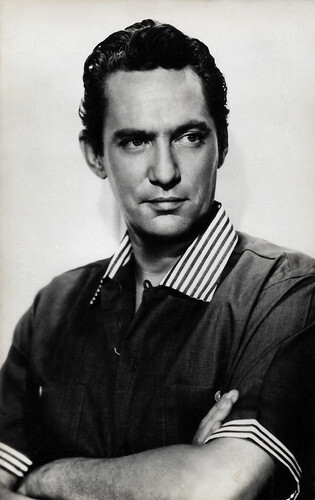
Spanish postcard, no. 2660.
Sources: (IMDb), Wikipedia (German, Dutch and English), and .

British postcard in the Picturegoer Series, London, no. D 722. Photo: British Lion.

American postcard by Fotofolio, NY, NY, no. P 348. Photo: Phil Stern. Peter Finch in The Flight of the Phoenix (Robert Aldrich, 1965).
"If I was broke anyway, I might as well become an actor"
Peter Finch was born Frederick Peter Ingle-Finch in 1916 in London, Great Britain. Finch was the illegitimate child of Alicia Gladys Fisher and Wentworth Edward Dallas "Jock" Campbell, a Scottish Military officer. His mother was married at the time to Australian-born chemist and mountaineer George Ingle Finch, who officially assumed paternity.
After his parents' early divorce, Peter Finch grew up mostly with relatives in France, India and finally in his parents' native Australia. He grew up in Sydney, New South Wales. Finch didn't meet his mother until he was 33, and his natural father until he was 45.
After leaving school, he took numerous low-paid odd jobs in Sydney, including a brief spell as a reporter on the Sydney Sun. He eventually decided to become an actor. He later commented, "If I was broke anyway, I might as well become an actor." He first found employment in sketches within vaudeville shows. By the mid-1930s, Finch began to play more serious roles in the theatre and started to work in radio.
Finch's first on-screen performance was as Prince Charming in The Magic Shoes (Claude Fleming, 1935). The Australian short film was an adaptation of the Cinderella fairy-tale, and also starred Helen Hughes, the daughter of the Australian Prime Minister Morris Hughes. In 1938 Finch made his feature film screen debut in Dad and Dave Come to Town (Ken Hall, 1938). Other roles in Australian cinema followed, though without initially attracting international attention. He did, however, become one of the most popular actors in radio dramas in Australia, thanks to his pleasant voice.
From 1941 to 1945 he served with the Australian Imperial Force in World War II, partly in troop entertainment, and was latterly in the rank of sergeant. During one of his stage appearances shortly after the end of the war, he was spotted by Laurence Olivier who was conducting a tour of Australia with his theatrical company. He brought Finch to London to the Old Vic Theatre, where Olivier was artistic director at the time. Finch later had an affair with Olivier's wife, the actress Vivien Leigh . In London, Finch was soon able to make a name for himself in stage roles, for example in 1949 with a performance in 'Daphne Laureola' alongside Edith Evans, which received a standing ovation.

British publicity photo by J. Rank Organisation. Original signature.

British postcard in the Celebrity Autograph Series by Celebrity Publishers LTD., London, no. 246. Photo: J. Arthur Rank Organisation. Peter Finch in Simon and Laura (Muriel Box, 1955).
Propelled to stardom in British cinema
However, as Peter Finch had severe stage fright, from the 1950s onward he concentrated primarily on his film career, which had been sluggish until then. His first British production was Eureka Stockade (Harry Watt, 1949), although here he was still in a supporting role.
A year later he made a minor appearance in the Hollywood drama The Miniver Story (H.C. Potter, 1950), the sequel to the war drama Mrs. Miniver (William Wyler, 1942), both starring Greer Garson . In 1952, his portrayal of the Sheriff of Nottingham opposite Richard Todd in Walt Disney's The Story of Robin Hood and His Merrie Men (Ken Annakin, 1952) received some attention. This was followed by a series of leading roles that propelled him to stardom in British cinema in the mid-1950s.
In 1954, he signed a seven-year contract with the Rank Organisation worth £87,500 to make one film a year for them. "We are going to build Peter into a major British star", said Earl St. John, Rank's head of production, at the time. He protrayed an Australian soldier in the World War II drama A Town Like Alice (Jack Lee, 1956) starring Virginia McKenna . The film, mostly set in Malaya and almost entirely shot at Pinewood Studios, became the third-most-popular film at the British box office in 1956 and earned him his first British Film Academy Award (BAFTA) for Best Actor in 1956. He later received the award three more times.
Finch's other roles included Elizabeth Taylor 's husband in Elephant Walk (William Dieterle, 1954), the villain Flambeau in Father Brown (Robert Hamer, 1954) starring Alec Guinness , and German Captain Hans Langsdorff in The Battle of the River Plate (Michael Powell, Emeric Pressburger, 1957) about the first major naval battle of World War II in which the British Navy destroyed the Graf Spee, a powerful German warship. This war film was also hugely popular in Great Britain, and British exhibitors voted Finch the seventh-most-popular British star at the box office for 1956.
Then Finch played an atheist medical doctor alongside Audrey Hepburn 's nun in The Nun's Story (Fred Zinnemann, 1959). It is the melancholy tale of a young missionary working as a nurse in the Belgian Congo during WW II. The film was based on the novel by Kathryn Hulme that told the story of the real-life nun, Marie-Louise Habets. Especially this film, a huge financial and critical success, boosted Finch's international reputation.

West-German postcard by Ufa/Film-Foto, Berlin-Tempelhof, no. FK 3548 Photo: J. Arthur Rank Organisation. Peter Finch in The Battle of the River Plate (Michael Powell, Emeric Pressburger, 1956).

Dutch postcard. Photo: Rank. Eva Bartok and Peter Finch in Amsterdam during the shooting of the British war-time diamond thriller Operation Amsterdam (Michael McCarthy, 1959). The film was produced by Maurice Cowan and Rank and distributed by Rank and 20th Century Fox.
A sought-after character actor in international cinema
In the course of the 1960s, Peter Finch succeeded in positioning himself increasingly as a sought-after character actor in international cinema. At the 1961 Berlinale, he was awarded the Silver Bear for Best Actor for his portrayal of a politician in crisis, both personally and professionally, in No Love for Johnnie by Ralph Thomas.
He also received much praise for his portrayal of Oscar Wilde in The Man with the Green Carnation/The Trials of Oscar Wilde (Ken Hughes, 1960) on the libel and subsequent criminal cases involving Wilde and the Marquess of Queensberry. Finch won another BAFTA for his role and the film won the Golden Globe Award for Best English-Language Foreign Film, but the film was not popular at the box-offices.
Internationally, Finch played British officer Harris in Robert Aldrich's survival drama The Flight of the Phoenix (1965) and Italian general Umberto Nobile in the expensive Soviet/Italian adventure film Krasnaya palatka/The Red Tent (Mikhail Kalatozov, 1969) based on the story of the 1928 mission to rescue Umberto Nobile and the other survivors of the crash of the airship Italia. It features Sean Connery as Roald Amundsen. Finch also appeared in military roles in other films.
In 1960, Finch tried his hand behind the camera for once when he made the semi-documentary style short film The Day about the life of a boy on the island of Ibiza. The Day was well received at film festivals, but it was to remain his only directorial effort.
In Britain at this time, Peter Finch was one of a group of already established actors who had no inhibitions about working with the innovative directors of the British New Wave. He often played intelligent and reserved characters here, for example, a writer in a love affair with a younger woman in Desmond Davis' Girl with Green Eyes (1964) and the lonely farmer William Boldwood opposite Julie Christie in John Schlesinger's romantic drama Far from the Madding Crowd (1967) based on Thomas Hardy's novel 'On the Green Edge of the World'.

Italian postcard by Bromofoto, Milano, no. 1143 Photo: Rank. Peter Finch in Simon and Laura (Muriel Box, 1955).

Belgian postcard, no. 5457.
The first film star to be seen in a gay film kiss
In 1971 Peter Finch worked with Schlesinger again for the film drama Sunday, Bloody Sunday (John Schlesinger, 1971), for which he received his first Oscar nomination, in the category of Best Actor in a Leading Role. Finch inherited the role of a gay doctor who shares his younger lover (Murray Head) with a woman ( Glenda Jackson ) from Alan Bates , who wanted to do it but couldn't due to his being held up filming The Go-Between (Joseph Losey, 1971). His replacement, Ian Bannen was fired at the beginning of the shooting due to his stated concern that portraying a homosexual engaged in the first screen kiss between two men might damage or destroy his career. Finch spontaneously replaced Bannen and unhesitatingly threw himself into the role. He kissed co-star Murray Head and received an Oscar nomination for his performance. For playing the role brilliantly, Finch won the BAFTA and National Society of Film Critics Awards prizes for Best Actor but lost the Oscar to eventual winner Gene Hackman.
Finch's subsequent film projects were less successful, however, as were his two films with Liv Ullmann : the spectacularly flopped musical Lost Horizon (Charles Jarrott, 1973) and the historical film The Abdication (Anthony Harvey, 1974). In the historical war film Bequest to the Nation (James Cellan Jones, 1973), he portrayed British General Horatio Nelson.
Shortly before his death, Peter Finch hit the screens with a television film, Raid on Entebbe (Irvin Kershner, 1976), in which he played Yitzchak Rabin, and was on a promotional tour for his latest feature film, the media satire Network (Sidney Lumet, 1976). In 1977, Finch died of a heart attack suffered in the lobby of the Beverly Hills Hotel in Los Angles at the age of 60. Only one day before, he appeared on The Tonight Show Starring Johnny Carson on U.S. network television NBC, entertaining the host and the audience with tales of his youth, his 'psychic' grandmother and, eerily, a joke about dying from a heart attack.
A few months later, he won the Academy Award for Best Actor in a Leading Role for his portrayal of Howard Beale, a television host gone mad, in Network. The award was accepted by his widow Eletha Finch. Finch and Heath Ledger are the only actors to date to receive the Oscar posthumously. The scenes in which Finch's character preaches his wisdom to the television audience are among the most famous of the classic Network. The film quote "I'm mad as hell and I can't take it anymore" spoken by him became equally famous.
Peter Finch was married three times and had four children. From 1943 until their divorce in 1959, he was married to ballet dancer Tamara Tchinarova Finch (1919-2017) They had one child. From 1959 to 1965, his wife was actress Yolande Turner (1935-2003), and they had two children. Businessman and film producer Charles Finch (b. 1962) is their son. From 1973 until his death in 1977 Peter Finch was married to Eletha Barrett Finch, with whom he had one child. Biographies and obituaries described Finch the man as a womaniser and relatively heavy drinker, but also as kind and educated. Peter Finch is buried at the Hollywood Forever Cemetery.

Spanish postcard, no. 2660.
Sources: (IMDb), Wikipedia (German, Dutch and English), and .
Published on December 17, 2022 22:00
December 16, 2022
Directed by Victor Sjöström
Director and actor Victor Sjöström (1979-1960) was famous for his poetic and touching epics, such as Ingeborg Holm (1913), Terje Vigen/A Man There Was (1916) - by then the most expensive Swedish film made - and Körkarlen/The Phantom Carriage (1920), considered one of the best Swedish films ever. From 1923 he worked in Hollywood under the name of Victor Seastrom, directing such films as He Who Gets Slapped (1924), starring Lon Chaney, and The Wind (1928), starring Lilian Gish. With the advent of sound cinema, he returned to Sweden. This was for now the final post in our series on silent Swedish cinema.
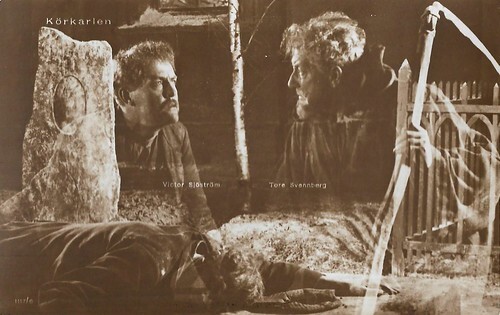
Swedish postcard by Förlag Nordisk Konst, Stockholm, no. 1117/6. Photo: Svensk Filmindustri. Victor Sjöström and Tore Svennberg in Körkarlen/The Phantom Carriage, (Victor Sjöström, 1920).
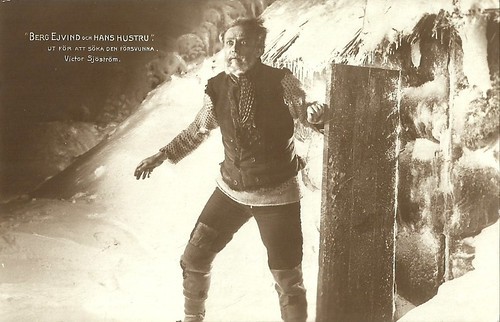
Swedish postcard by Nordisk Konst, Stockholm, no. 844/ 11. Photo: Svenska Biografteatern AB. Victor Sjöström in Berg-Ejvind och hans hustru/The Outlaw and His Wife (Victor Sjöström, 1918). Caption: Out to seek the lost.
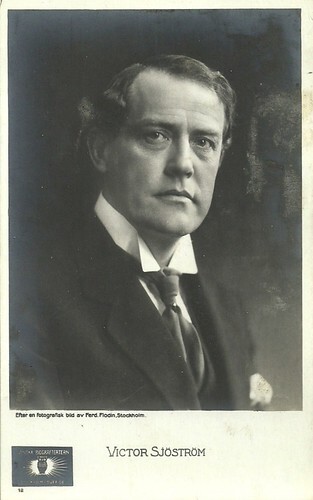
Swedish postcard by Svenska Biografteatern, no. 12. Photo: Ferd. Flodin, Stockholm. Victor Sjöström .
The first classic of Swedish cinema
Victor David Sjöström was born in Silbodal, Sweden, in 1879. He was only a year old when his father, Olof Adolf Sjöström, moved the family to Brooklyn, New York, where the father soon built up a successful shipping agency. As a boy, Sjöström was close to his mother, actress Sofia Elisabeth Hartman, who died in New York during childbirth in 1886. The seven-year-old Victor returned to Sweden where he lived with relatives in Stockholm. His uncle was a leading actor at the Royal Dramatic Theatre in Stockholm during the latter part of the 19th century, Victor Hartman.
As a teenager, Sjöström loved the theatre. He formed a theatre society at his Uppsala school, which produced the play 'The Two Deaf Men', in which Sjöström is said to have shown a flair for comedy. In 1895, Olof Sjöström returned from the United States, poor. Victor interrupted his studies and moved in with him in Stockholm. He now began working to support himself and his father, including working in a boarding house in Stockholm and selling novelty doughnuts on the city streets. In 1896, his father died, and Sjöström decided to embark on an acting career in earnest. Sjöström could not afford to attend the Drama School, but instead joined Ernst Ahlbom's theatre company, with which he toured Finland from 1896-1898. In the following decade, he worked for several stage companies in Scandinavia, first as an actor and later also as a director. In 1912-1913, he and Einar Fröberg had a theatre company together - the Fröberg-Sjöströmska Society - which performed in Copenhagen and elsewhere.
Then Charles Magnusson of Svenska Bio hired him and fellow stage director, Mauritz Stiller, to helm motion pictures. Here, Sjöström met the photographer brothers Henrik and Julius Jaenzon, who were to work with him. Sjöström made his acting debut in the Stiller film Vampyren/The Vampire to learn the ropes of filmmaking. The film was shot in 1912 but did not premiere until 1913. His debut as a director was the silent film Ett hemligt giftermål/A Ruined Life (Victor Sjöström, 1912) with Hilda Borgström and John Ekman.
Between 1912 and 1915, Victor Sjöström directed 31 silent films of which only three still survive. His drama Trädgårdsmästaren/The Gardener (Victor Sjöström, 1912) was the first film to ever be banned by the Swedish censor system. Sjöström himself played a brutal gardener who rapes a young, innocent woman ( Lili Beck , who became Sjöström's second wife) in his employ in a lovely greenhouse. In the final scene, the girl is found dead the next morning on the floor of the greenhouse, with red roses around her. The official comments of the censors were: "A breach of respectability. The association of death and beauty poses a threat to public order." The film was long thought to have been lost, but in 1979 a copy was found in an archive in the United States.
In 1913, he directed Ingeborg Holm (Victor Sjöström, 1913), which is considered his first masterpiece and the first classic of Swedish cinema. Ingeborg Holm is a social realist drama about a woman (played by Hilda Borgström) who, after the death of her husband, loses custody of her children and ends up in a mental hospital. The film attracted widespread attention both for its artistic merits and for the debate on poverty care that arose in its wake, and it was also successful abroad.
Sjöström's big breakthrough came with Terje Vigen/A Man There Was (Victor Sjöström, 1917), a film adaptation of Henrik Ibsen's long poem 'Terje Vigen'. The film is usually called the beginning of the golden age of Swedish film. It was Svenska Bio's most lavish film to date and was among the first films to be shot in natural settings, specifically at Landsort outside Nynäshamn. The film tells the story of a sailor, Terje, who has lost his home and family in the Napoleonic Wars and has become bitter and vengeful, yet finds the strength to act well. Sjöström himself played the lead role as Terje Vigen, and Edith Erastoff, who would become his third wife, also played a leading role. Terje Vigen/A Man There Was (1917) was a success, with Stockholms Dagblad calling it "the best Swedish film ever made".

Swedish postcard by Nordisk Konst, Stockholm, no. 843/1. Photo: Svenska Biografteatern AB. Gösta Cederlund as Per Månsson, Greta Almroth as Helga and William Larsson as her father in Tösen från Stormyrtorpet/The Girl from the Marsh Croft (Victor Sjöström, 1917). Caption: At the house of Per Månsson at Västgården. The woman in the back may be Edla Rothgardt, who plays Per Månsson's wife.
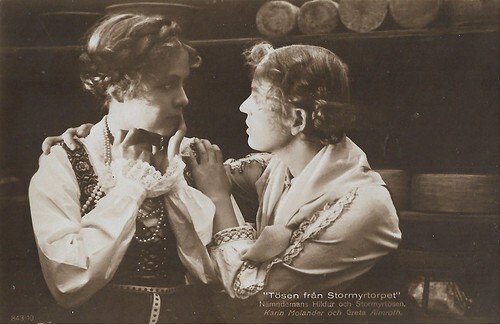
Swedish postcard by Nordisk Konst, Stockholm, no. 843/10. Photo: Svenska Biografteatern AB. Karin Molander and Greta Almroth in Tösen från Stormyrtorpet/The Girl from the Marsh Croft (Victor Sjöström, 1917). Caption: Alderman's daughter Hildur and the Marsh Girl.
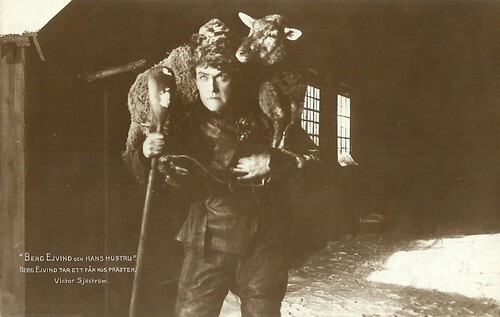
Swedish postcard by Nordisk Konst, Stockholm, no. 844/2. Photo: Svenska Biografteatern AB. Victor Sjöström in Berg-Ejvind och hans hustru/The Outlaw and His Wife (Victor Sjöström, 1918). Caption: Berg-Ejvind steals a sheep from the priest.
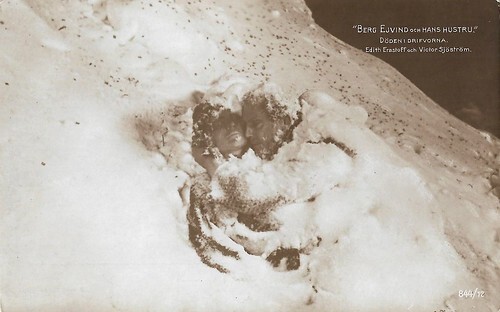
Swedish postcard by Nordisk Konst, Stockholm, no. 844/12 (final card and final scene of the film). Photo: Svenska Biografteatern AB. Victor Sjöström and Edith Erastoff in Berg-Ejvind och hans hustru/The Outlaw and His Wife (Victor Sjöström, 1918). Caption: Death in the snowstorm.
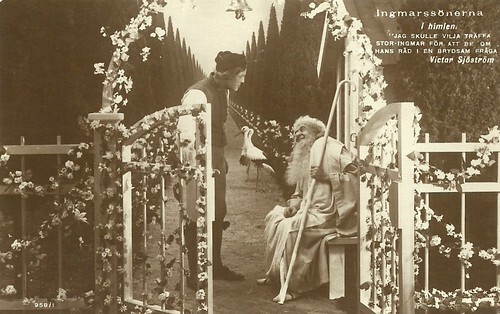
Swedish postcard by Nordisk Konst, Stockholm, no. 958/1. Photo: Svenska Biografteatern AB. Victor Sjöström in Ingmarssönerna/Sons of Ingmar (Victor Sjöström, 1919). Young Ingmar at Heaven's Gate. Caption: "I would like to meet Old Ingmar to ask for his advice in an awkward matter."
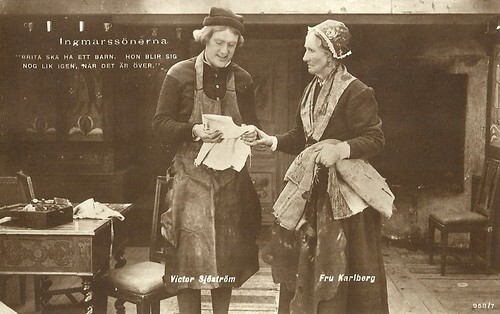
Swedish postcard by Nordisk Konst, Stockholm, no. 958/7. Victor Sjöström and Hildur Karlberg in Ingmarssönerna/Sons of Ingmar (Victor Sjöström, 1919). Caption: Mother: It is because Brita will have her child, but then she will recover and it will be over.
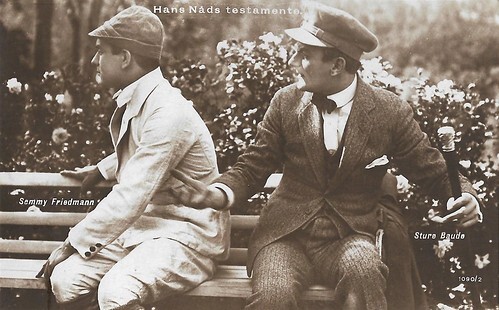
Swedish postcard by Nordisk Konst, Stockholm, no. 1090/2. Photo: Svenska Biografteatern. Semmy Friedmann and Sture Baude in Hans Nåds testamente/His Grace's Testament/His Lordship's Last Will (Victor Sjöström, 1919).
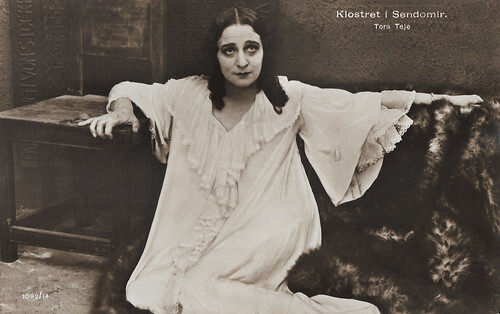
Swedish postcard. Nordisk Konst, Stockholm, no. 1092/14. Tora Teje in Klostret i Sendomir/Secret of the Monastery (Victor Sjöström 1920).
Adapting Selma Lagerlöf
The success of Terje Vigen/A Man There Was (Victor Sjöström, 1917) led to a change in Svenska Bio's production policy. Previously the company had been churning out about twenty films a year, but now the producers slowed down the rate of production and they gave each film a higher budget and more thought. That same year saw the release of the Selma Lagerlöf film adaptation Tösen från Stormyrtorpet/The Lass from the Stormy Croft (Victor Sjöström, 1917). Lagerlöf had been impressed by Terje Vigen and gave Sjöström the go-ahead to film this short story. The film was the first of Sjöström's five Lagerlöf films.
Victor Sjöström's next film was also a milestone in his career: Berg-Ejvind och hans hustru/The Outlaw and His Wife (1918), about the Icelandic outlaw Berg-Ejvind who falls in love with the wealthy widow Halla. The film was based on a play by the Danish-Icelandic writer Jóhann Sigurjónsson and, like Terje Vigen, was shot in real settings, this time in Abisko National Park in Lapland. The film was hailed almost unanimously as a great work of art. The depictions of nature were particularly praised. Sjöström starred opposite Edith Erastoff, who was expecting the couple's first child, and the couple's real-life infatuation is thought to add an extra lustre to the love story. In 1918, their daughter Gun ("Guje") was born. They married in 1922, after having to wait five years for her divorce.
Sjöström's other surviving silent Swedish films include Ingmarssönerna/Sons of Ingmar (Victor Sjöström, 1919), the sequel Karin Ingmarsdotter/Karin, Daughter of Ingmar (Victor Sjöström, 1920) and Körkarlen/The Phantom Carriage (Victor Sjöström, 1921), all based on stories by the Nobel-prize winning novelist Selma Lagerlöf. These films are marked by subtle character portrayal, fine storytelling and evocative settings in which the Swedish landscape often plays a key psychological role. The naturalistic quality of his films was enhanced by his, then-revolutionary, preference for on-location filming, especially in rural and village settings.
Ingmarssönerna/Sons of Ingmar (1919) and Karin Ingmarsdotter/Karin, Daughter of Ingmar (1920) are based on the first four chapters of 'Jerusalem', a novel by Lagerlöf, published in two parts in 1901 and 1902. The narrative spans several generations in the 19th century and focuses on several families in Dalarna, Sweden, and a community of Swedish emigrants in Jerusalem. It is loosely based on a real emigration that took place from the parish of Nås in 1896. Sjöström originally intended to film the entire novel but decided to cancel the project after the second film received an unenthusiastic critical response.
In 1919, Svenska Bio and Filmindustri AB Skandia merged to form Svensk Filmindustri (SF). The company's first project was Sjöström's Körkarlen/The Phantom Carriage (1921), which is considered Sjöström's greatest work and the pinnacle of Swedish silent film. Released on New Year's Day 1921, Körkarlen/The Phantom Carriage starred Victor Sjöström himself, alongside Hilda Borgström, Tore Svennberg and Astrid Holm. The characters and acting were of the highest order, and the trick filming and double exposures by Julius Jaenzon were groundbreaking. It is also notable for its advanced (for the time) narrative structure with flashbacks within flashbacks. The film was a huge success both nationally and internationally. When it premiered in New York, the film received a lyrical review in The New York Times and made Sjöström a household name. Later the film would be a major influence on Ingmar Bergman .
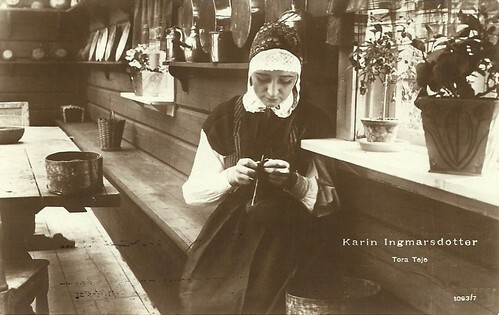
Swedish postcard by Nordisk Konst, Stockholm, no. 1093/7. Tora Teje in Karin Ingmarsdotter/Karin Daughter of Ingmar (Victor Sjöström, 1920).
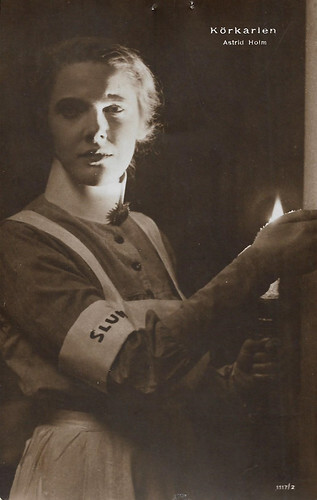
Swedish postcard by Förlag Nordisk Konst, Stockholm, no. 1117/2. Photo: Svensk Filmindustri. Astrid Holm in Körkarlen/The Phantom Carriage, (Victor Sjöström, 1920).
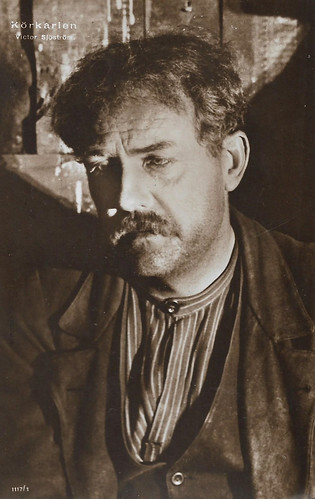
Swedish postcard by Förlag Nordisk Konst, Stockholm, no. 1117/3. Photo: Svensk Filmindustri. Victor Sjöström in Körkarlen/The Phantom Carriage, (Victor Sjöström, 1920).
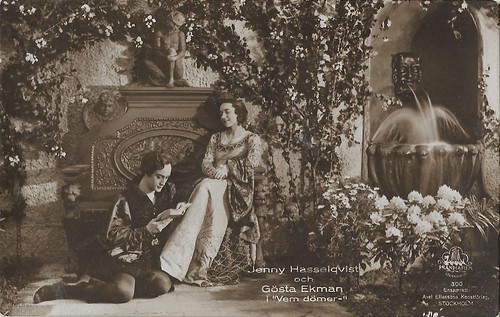
Swedish postcard by Axel Eliassons Konstförlag, Stockholm, no. 300. Photo: Skandia Film. Gösta Ekman and Jenny Hasselqvist in Vem dömer/ Love's Crucible (Victor Sjöström, 1922).
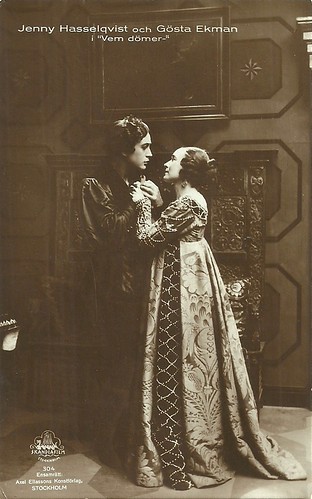
Swedish postcard by Axel Eliassons Konstförlag, Stockholm, no. 304. Photo: Skandia Film. Gösta Ekman and Jenny Hasselqvist in Vem dömer/ Love's Crucible (Victor Sjöström, 1922).
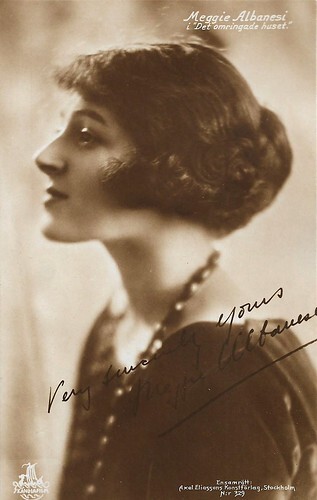
Swedish postcard by Axel Eliassons Konstförlag, Stockholm, no. 329. Photo: Skandiafilm / Svensk Filminspelning. Meggie Albanesi in Det omringade huset/The Surrounded House (Victor Sjöström, 1922).
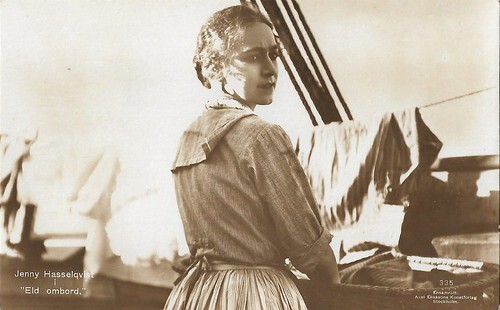
Swedish postcard by Axel Eliassons Konstförlag, Stockholm, no. 335. Photo: Svensk Filminspelning. Jenny Hasselqvist in Eld ombord/Fire on board/The Hell Ship (Victor Sjöström, 1923).
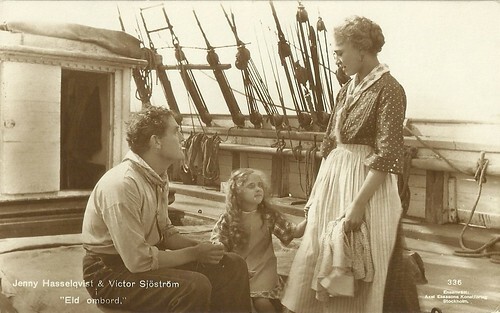
Swedish postcard by Ed. Axel Eliassons Konstförlag, Stockholm, no. 336. Photo: Svensk Filminspelning. Victor Sjöström and Jenny Hasselqvist in Eld ombord/Fire on board (Victor Sjöström, 1923).
The finest production we have yet seen
In 1922, Victor Sjöströme received an offer to come and film in Hollywood. The following year, Sjöström and his family left for the United States. His family consisted of his wife Edith and their two daughters, Gun ('Guje") and Karin ("Caje"). They spent seven years in the country. In Sweden, he had acted in his own films as well as in those for others, but in Hollywood, he devoted himself solely to directing. During this time he directed a total of nine films for the newly formed Metro-Goldwyn-Mayer company, of which he became the biggest star director.
Credited as Victor Seastrom, he directed Name the Man! (1924) for Goldwyn Pictures. Goldwyn soon folded into Metro-Goldwyn-Mayer and Sjöstrom directed the psychological thriller He Who Gets Slapped (1924) starring Lon Chaney , Norma Shearer , and John Gilbert . The film was written by Sjöström and Carey Wilson and based on the Russian play 'He Who Gets Slapped' (Тот, кто получает пощёчины; Tot, kto polučájet poščóčiny) by playwright Leonid Andreyev. He Who Gets Slapped was the first film produced entirely by Metro-Goldwyn-Mayer and was highly profitable and critically hailed. In his 1924 review of the film for the New York Times, Mordaunt Hall praised the film's direction, performances, and story, calling it "the finest production we have yet seen". He Who Gets Slapped was important in the careers of Chaney, Shearer, Gilbert, and Sjöström.
He was highly respected by MGM chief Louis B. Mayer and by production head Irving Thalberg, who shared Sjöström's concerns with art that did not exclude profit. Among his other major Hollywood films are The Scarlet Letter (1926) and The Wind (1928), both starring Lillian Gish . In The Scarlet Letter (1926), Gish plays the adulterous Hester Prynne. Sjöström allows Hester a certain voluptuousness. When she leaves the bare rooms of the town for a date with her lover in the verdant woods, she defiantly pulls off her scarlet letter A, takes off her cap as well, and we see her beautiful, rich head of hair. The romantic drama The Wind (1928) featured also Lillian Gish , Lars Hanson and Montagu Love. It was one of the last silent films released by Metro-Goldwyn-Mayer and is considered to be among the greatest silent films.
Unlike the Swedish directors Mauritz Stiller and Hjalmar Bergman, who also tried their luck in the United States, Sjöström enjoyed both artistic and commercial success in that country. Sjöström became one of the most highly-paid directors in Hollywood, reaching his peak at the end of the silent era. Sjöström's first talkie was A Lady to Love (1930) starring Vilma Bánky and Edward G. Robinson . Robinson also appeared in the German-language version also produced and directed by Sjöström. Otherwise, with a different cast, it was released a year later in the United States as Die Sehnsucht Jeder Frau.
Uncomfortable with the modifications needed to direct sound films, Victor Sjöström returned to Sweden where he directed only two more films, the German language Väter und Söhne/Father and Son (1931) and the Swedish language version Markurells i Wadköping/Father and Son (1931). His final directing effort was for 20th Century Fox, the historical drama Under the Red Robe (1937). The adventure film, starring Conrad Veidt and Annabella and filmed in the United Kingdom, was set during the religious wars of early 17th century France.
Over the following fifteen years, Victor Sjöström returned to acting in the theatre, performed a variety of leading roles in more than a dozen films and was a company director of Svensk Film Industri. Aged 78, he gave his final acting performance, probably his best remembered, as the elderly professor Isak Borg who recalls his past in Ingmar Bergman 's film Smultronstället/Wild Strawberries (1957) opposite Bergman regulars Bibi Andersson , Ingrid Thulin, and Gunnar Björnstrand. In 1960, Sjöström passed away in Stockholm at the age of 80.
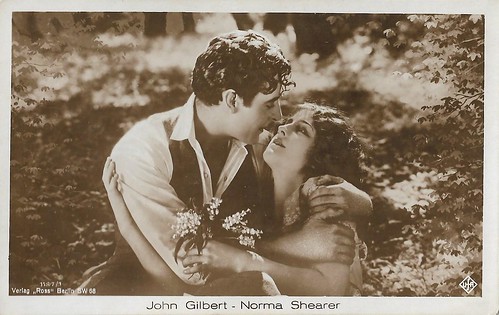
German postcard by Ross Verlag, Berlin, no. 1587/1. Photo: Ufa. John Gilbert and Norma Shearer in He Who Gets Slapped (Victor Sjöström, 1924).
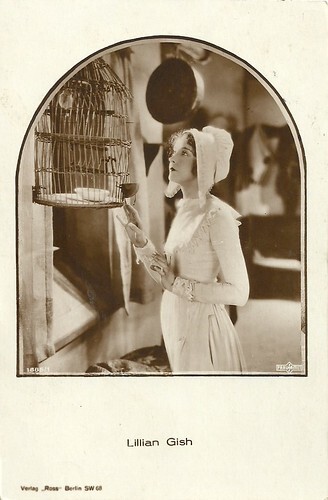
German postcard by Ross Verlag, no. 1885/1. Photo: Parufamet. Lillian Gish in The Scarlet Letter (Victor Sjöström, 1926).
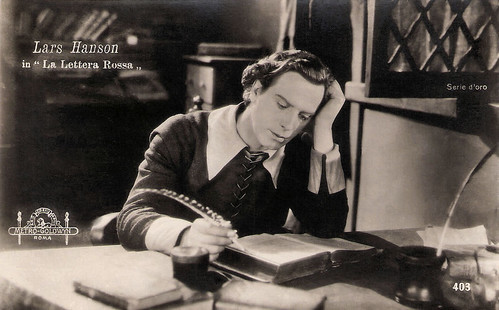
Italian postcard by Ballerini & Fratini, Firenze, no. 403. Photo: Metro-Goldwyn-Mayer, Roma. Lars Hanson as Reverend Arthur Dimmesdale in the period piece The Scarlet Letter (Victor Sjostrom, 1926), set in the era of the Puritans.
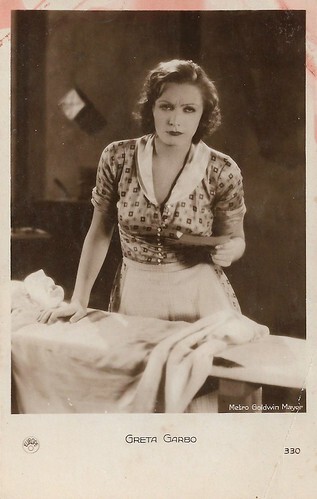
French postcard by Europe, no. 330. Photo: Metro-Goldwyn-Mayer. Greta Garbo in The Divine Woman (Victor Sjöström, 1928).
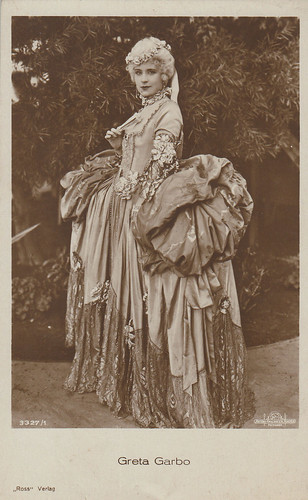
German postcard by Ross Verlag, no. 3327/1, 1928-1929. Photo: MGM. This lady is not Greta Garbo , but Paulette Duval in costume for The Divine Woman (Victor Sjöström, 1928), in which she played with Garbo. Collection: Marlene Pilaete.
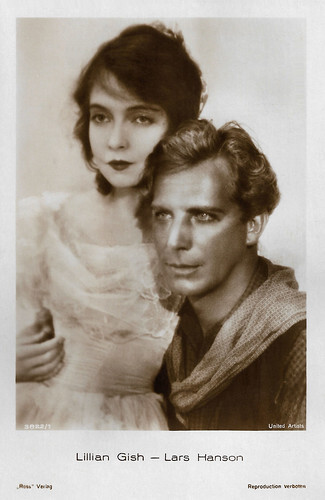
German postcard by Ross Verlag, no. 3822/1, 1928-1929. Photo: United Artists. Lillian Gish and Lars Hanson in The Wind (Victor Sjöström, 1928).
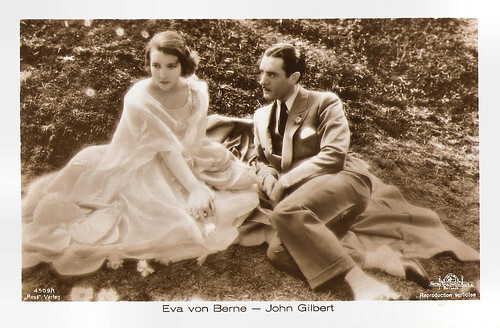
German postcard by Ross Verlag, no. 4509/1, 1929-1930. Photo: MGM. Eva von Berne and John Gilbert in The Masks of the Devil (Victor Sjöström, 1928).
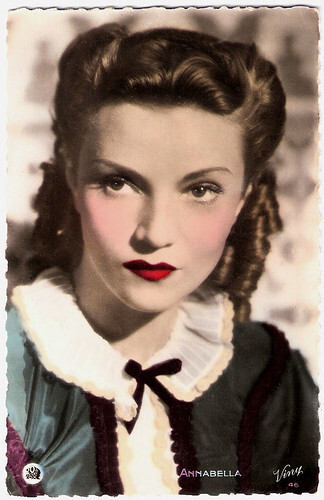
French postcard by Viny, no. 46. Photo: 20th Century Fox. Annabella in Under the Red Robe (Victor Seaström, a.k.a. Victor Sjöström, 1937).
Sources: (IMDb), Wikipedia (Swedish and English) and .

Swedish postcard by Förlag Nordisk Konst, Stockholm, no. 1117/6. Photo: Svensk Filmindustri. Victor Sjöström and Tore Svennberg in Körkarlen/The Phantom Carriage, (Victor Sjöström, 1920).

Swedish postcard by Nordisk Konst, Stockholm, no. 844/ 11. Photo: Svenska Biografteatern AB. Victor Sjöström in Berg-Ejvind och hans hustru/The Outlaw and His Wife (Victor Sjöström, 1918). Caption: Out to seek the lost.

Swedish postcard by Svenska Biografteatern, no. 12. Photo: Ferd. Flodin, Stockholm. Victor Sjöström .
The first classic of Swedish cinema
Victor David Sjöström was born in Silbodal, Sweden, in 1879. He was only a year old when his father, Olof Adolf Sjöström, moved the family to Brooklyn, New York, where the father soon built up a successful shipping agency. As a boy, Sjöström was close to his mother, actress Sofia Elisabeth Hartman, who died in New York during childbirth in 1886. The seven-year-old Victor returned to Sweden where he lived with relatives in Stockholm. His uncle was a leading actor at the Royal Dramatic Theatre in Stockholm during the latter part of the 19th century, Victor Hartman.
As a teenager, Sjöström loved the theatre. He formed a theatre society at his Uppsala school, which produced the play 'The Two Deaf Men', in which Sjöström is said to have shown a flair for comedy. In 1895, Olof Sjöström returned from the United States, poor. Victor interrupted his studies and moved in with him in Stockholm. He now began working to support himself and his father, including working in a boarding house in Stockholm and selling novelty doughnuts on the city streets. In 1896, his father died, and Sjöström decided to embark on an acting career in earnest. Sjöström could not afford to attend the Drama School, but instead joined Ernst Ahlbom's theatre company, with which he toured Finland from 1896-1898. In the following decade, he worked for several stage companies in Scandinavia, first as an actor and later also as a director. In 1912-1913, he and Einar Fröberg had a theatre company together - the Fröberg-Sjöströmska Society - which performed in Copenhagen and elsewhere.
Then Charles Magnusson of Svenska Bio hired him and fellow stage director, Mauritz Stiller, to helm motion pictures. Here, Sjöström met the photographer brothers Henrik and Julius Jaenzon, who were to work with him. Sjöström made his acting debut in the Stiller film Vampyren/The Vampire to learn the ropes of filmmaking. The film was shot in 1912 but did not premiere until 1913. His debut as a director was the silent film Ett hemligt giftermål/A Ruined Life (Victor Sjöström, 1912) with Hilda Borgström and John Ekman.
Between 1912 and 1915, Victor Sjöström directed 31 silent films of which only three still survive. His drama Trädgårdsmästaren/The Gardener (Victor Sjöström, 1912) was the first film to ever be banned by the Swedish censor system. Sjöström himself played a brutal gardener who rapes a young, innocent woman ( Lili Beck , who became Sjöström's second wife) in his employ in a lovely greenhouse. In the final scene, the girl is found dead the next morning on the floor of the greenhouse, with red roses around her. The official comments of the censors were: "A breach of respectability. The association of death and beauty poses a threat to public order." The film was long thought to have been lost, but in 1979 a copy was found in an archive in the United States.
In 1913, he directed Ingeborg Holm (Victor Sjöström, 1913), which is considered his first masterpiece and the first classic of Swedish cinema. Ingeborg Holm is a social realist drama about a woman (played by Hilda Borgström) who, after the death of her husband, loses custody of her children and ends up in a mental hospital. The film attracted widespread attention both for its artistic merits and for the debate on poverty care that arose in its wake, and it was also successful abroad.
Sjöström's big breakthrough came with Terje Vigen/A Man There Was (Victor Sjöström, 1917), a film adaptation of Henrik Ibsen's long poem 'Terje Vigen'. The film is usually called the beginning of the golden age of Swedish film. It was Svenska Bio's most lavish film to date and was among the first films to be shot in natural settings, specifically at Landsort outside Nynäshamn. The film tells the story of a sailor, Terje, who has lost his home and family in the Napoleonic Wars and has become bitter and vengeful, yet finds the strength to act well. Sjöström himself played the lead role as Terje Vigen, and Edith Erastoff, who would become his third wife, also played a leading role. Terje Vigen/A Man There Was (1917) was a success, with Stockholms Dagblad calling it "the best Swedish film ever made".

Swedish postcard by Nordisk Konst, Stockholm, no. 843/1. Photo: Svenska Biografteatern AB. Gösta Cederlund as Per Månsson, Greta Almroth as Helga and William Larsson as her father in Tösen från Stormyrtorpet/The Girl from the Marsh Croft (Victor Sjöström, 1917). Caption: At the house of Per Månsson at Västgården. The woman in the back may be Edla Rothgardt, who plays Per Månsson's wife.

Swedish postcard by Nordisk Konst, Stockholm, no. 843/10. Photo: Svenska Biografteatern AB. Karin Molander and Greta Almroth in Tösen från Stormyrtorpet/The Girl from the Marsh Croft (Victor Sjöström, 1917). Caption: Alderman's daughter Hildur and the Marsh Girl.

Swedish postcard by Nordisk Konst, Stockholm, no. 844/2. Photo: Svenska Biografteatern AB. Victor Sjöström in Berg-Ejvind och hans hustru/The Outlaw and His Wife (Victor Sjöström, 1918). Caption: Berg-Ejvind steals a sheep from the priest.

Swedish postcard by Nordisk Konst, Stockholm, no. 844/12 (final card and final scene of the film). Photo: Svenska Biografteatern AB. Victor Sjöström and Edith Erastoff in Berg-Ejvind och hans hustru/The Outlaw and His Wife (Victor Sjöström, 1918). Caption: Death in the snowstorm.

Swedish postcard by Nordisk Konst, Stockholm, no. 958/1. Photo: Svenska Biografteatern AB. Victor Sjöström in Ingmarssönerna/Sons of Ingmar (Victor Sjöström, 1919). Young Ingmar at Heaven's Gate. Caption: "I would like to meet Old Ingmar to ask for his advice in an awkward matter."

Swedish postcard by Nordisk Konst, Stockholm, no. 958/7. Victor Sjöström and Hildur Karlberg in Ingmarssönerna/Sons of Ingmar (Victor Sjöström, 1919). Caption: Mother: It is because Brita will have her child, but then she will recover and it will be over.

Swedish postcard by Nordisk Konst, Stockholm, no. 1090/2. Photo: Svenska Biografteatern. Semmy Friedmann and Sture Baude in Hans Nåds testamente/His Grace's Testament/His Lordship's Last Will (Victor Sjöström, 1919).

Swedish postcard. Nordisk Konst, Stockholm, no. 1092/14. Tora Teje in Klostret i Sendomir/Secret of the Monastery (Victor Sjöström 1920).
Adapting Selma Lagerlöf
The success of Terje Vigen/A Man There Was (Victor Sjöström, 1917) led to a change in Svenska Bio's production policy. Previously the company had been churning out about twenty films a year, but now the producers slowed down the rate of production and they gave each film a higher budget and more thought. That same year saw the release of the Selma Lagerlöf film adaptation Tösen från Stormyrtorpet/The Lass from the Stormy Croft (Victor Sjöström, 1917). Lagerlöf had been impressed by Terje Vigen and gave Sjöström the go-ahead to film this short story. The film was the first of Sjöström's five Lagerlöf films.
Victor Sjöström's next film was also a milestone in his career: Berg-Ejvind och hans hustru/The Outlaw and His Wife (1918), about the Icelandic outlaw Berg-Ejvind who falls in love with the wealthy widow Halla. The film was based on a play by the Danish-Icelandic writer Jóhann Sigurjónsson and, like Terje Vigen, was shot in real settings, this time in Abisko National Park in Lapland. The film was hailed almost unanimously as a great work of art. The depictions of nature were particularly praised. Sjöström starred opposite Edith Erastoff, who was expecting the couple's first child, and the couple's real-life infatuation is thought to add an extra lustre to the love story. In 1918, their daughter Gun ("Guje") was born. They married in 1922, after having to wait five years for her divorce.
Sjöström's other surviving silent Swedish films include Ingmarssönerna/Sons of Ingmar (Victor Sjöström, 1919), the sequel Karin Ingmarsdotter/Karin, Daughter of Ingmar (Victor Sjöström, 1920) and Körkarlen/The Phantom Carriage (Victor Sjöström, 1921), all based on stories by the Nobel-prize winning novelist Selma Lagerlöf. These films are marked by subtle character portrayal, fine storytelling and evocative settings in which the Swedish landscape often plays a key psychological role. The naturalistic quality of his films was enhanced by his, then-revolutionary, preference for on-location filming, especially in rural and village settings.
Ingmarssönerna/Sons of Ingmar (1919) and Karin Ingmarsdotter/Karin, Daughter of Ingmar (1920) are based on the first four chapters of 'Jerusalem', a novel by Lagerlöf, published in two parts in 1901 and 1902. The narrative spans several generations in the 19th century and focuses on several families in Dalarna, Sweden, and a community of Swedish emigrants in Jerusalem. It is loosely based on a real emigration that took place from the parish of Nås in 1896. Sjöström originally intended to film the entire novel but decided to cancel the project after the second film received an unenthusiastic critical response.
In 1919, Svenska Bio and Filmindustri AB Skandia merged to form Svensk Filmindustri (SF). The company's first project was Sjöström's Körkarlen/The Phantom Carriage (1921), which is considered Sjöström's greatest work and the pinnacle of Swedish silent film. Released on New Year's Day 1921, Körkarlen/The Phantom Carriage starred Victor Sjöström himself, alongside Hilda Borgström, Tore Svennberg and Astrid Holm. The characters and acting were of the highest order, and the trick filming and double exposures by Julius Jaenzon were groundbreaking. It is also notable for its advanced (for the time) narrative structure with flashbacks within flashbacks. The film was a huge success both nationally and internationally. When it premiered in New York, the film received a lyrical review in The New York Times and made Sjöström a household name. Later the film would be a major influence on Ingmar Bergman .

Swedish postcard by Nordisk Konst, Stockholm, no. 1093/7. Tora Teje in Karin Ingmarsdotter/Karin Daughter of Ingmar (Victor Sjöström, 1920).

Swedish postcard by Förlag Nordisk Konst, Stockholm, no. 1117/2. Photo: Svensk Filmindustri. Astrid Holm in Körkarlen/The Phantom Carriage, (Victor Sjöström, 1920).

Swedish postcard by Förlag Nordisk Konst, Stockholm, no. 1117/3. Photo: Svensk Filmindustri. Victor Sjöström in Körkarlen/The Phantom Carriage, (Victor Sjöström, 1920).

Swedish postcard by Axel Eliassons Konstförlag, Stockholm, no. 300. Photo: Skandia Film. Gösta Ekman and Jenny Hasselqvist in Vem dömer/ Love's Crucible (Victor Sjöström, 1922).

Swedish postcard by Axel Eliassons Konstförlag, Stockholm, no. 304. Photo: Skandia Film. Gösta Ekman and Jenny Hasselqvist in Vem dömer/ Love's Crucible (Victor Sjöström, 1922).

Swedish postcard by Axel Eliassons Konstförlag, Stockholm, no. 329. Photo: Skandiafilm / Svensk Filminspelning. Meggie Albanesi in Det omringade huset/The Surrounded House (Victor Sjöström, 1922).

Swedish postcard by Axel Eliassons Konstförlag, Stockholm, no. 335. Photo: Svensk Filminspelning. Jenny Hasselqvist in Eld ombord/Fire on board/The Hell Ship (Victor Sjöström, 1923).

Swedish postcard by Ed. Axel Eliassons Konstförlag, Stockholm, no. 336. Photo: Svensk Filminspelning. Victor Sjöström and Jenny Hasselqvist in Eld ombord/Fire on board (Victor Sjöström, 1923).
The finest production we have yet seen
In 1922, Victor Sjöströme received an offer to come and film in Hollywood. The following year, Sjöström and his family left for the United States. His family consisted of his wife Edith and their two daughters, Gun ('Guje") and Karin ("Caje"). They spent seven years in the country. In Sweden, he had acted in his own films as well as in those for others, but in Hollywood, he devoted himself solely to directing. During this time he directed a total of nine films for the newly formed Metro-Goldwyn-Mayer company, of which he became the biggest star director.
Credited as Victor Seastrom, he directed Name the Man! (1924) for Goldwyn Pictures. Goldwyn soon folded into Metro-Goldwyn-Mayer and Sjöstrom directed the psychological thriller He Who Gets Slapped (1924) starring Lon Chaney , Norma Shearer , and John Gilbert . The film was written by Sjöström and Carey Wilson and based on the Russian play 'He Who Gets Slapped' (Тот, кто получает пощёчины; Tot, kto polučájet poščóčiny) by playwright Leonid Andreyev. He Who Gets Slapped was the first film produced entirely by Metro-Goldwyn-Mayer and was highly profitable and critically hailed. In his 1924 review of the film for the New York Times, Mordaunt Hall praised the film's direction, performances, and story, calling it "the finest production we have yet seen". He Who Gets Slapped was important in the careers of Chaney, Shearer, Gilbert, and Sjöström.
He was highly respected by MGM chief Louis B. Mayer and by production head Irving Thalberg, who shared Sjöström's concerns with art that did not exclude profit. Among his other major Hollywood films are The Scarlet Letter (1926) and The Wind (1928), both starring Lillian Gish . In The Scarlet Letter (1926), Gish plays the adulterous Hester Prynne. Sjöström allows Hester a certain voluptuousness. When she leaves the bare rooms of the town for a date with her lover in the verdant woods, she defiantly pulls off her scarlet letter A, takes off her cap as well, and we see her beautiful, rich head of hair. The romantic drama The Wind (1928) featured also Lillian Gish , Lars Hanson and Montagu Love. It was one of the last silent films released by Metro-Goldwyn-Mayer and is considered to be among the greatest silent films.
Unlike the Swedish directors Mauritz Stiller and Hjalmar Bergman, who also tried their luck in the United States, Sjöström enjoyed both artistic and commercial success in that country. Sjöström became one of the most highly-paid directors in Hollywood, reaching his peak at the end of the silent era. Sjöström's first talkie was A Lady to Love (1930) starring Vilma Bánky and Edward G. Robinson . Robinson also appeared in the German-language version also produced and directed by Sjöström. Otherwise, with a different cast, it was released a year later in the United States as Die Sehnsucht Jeder Frau.
Uncomfortable with the modifications needed to direct sound films, Victor Sjöström returned to Sweden where he directed only two more films, the German language Väter und Söhne/Father and Son (1931) and the Swedish language version Markurells i Wadköping/Father and Son (1931). His final directing effort was for 20th Century Fox, the historical drama Under the Red Robe (1937). The adventure film, starring Conrad Veidt and Annabella and filmed in the United Kingdom, was set during the religious wars of early 17th century France.
Over the following fifteen years, Victor Sjöström returned to acting in the theatre, performed a variety of leading roles in more than a dozen films and was a company director of Svensk Film Industri. Aged 78, he gave his final acting performance, probably his best remembered, as the elderly professor Isak Borg who recalls his past in Ingmar Bergman 's film Smultronstället/Wild Strawberries (1957) opposite Bergman regulars Bibi Andersson , Ingrid Thulin, and Gunnar Björnstrand. In 1960, Sjöström passed away in Stockholm at the age of 80.

German postcard by Ross Verlag, Berlin, no. 1587/1. Photo: Ufa. John Gilbert and Norma Shearer in He Who Gets Slapped (Victor Sjöström, 1924).

German postcard by Ross Verlag, no. 1885/1. Photo: Parufamet. Lillian Gish in The Scarlet Letter (Victor Sjöström, 1926).

Italian postcard by Ballerini & Fratini, Firenze, no. 403. Photo: Metro-Goldwyn-Mayer, Roma. Lars Hanson as Reverend Arthur Dimmesdale in the period piece The Scarlet Letter (Victor Sjostrom, 1926), set in the era of the Puritans.

French postcard by Europe, no. 330. Photo: Metro-Goldwyn-Mayer. Greta Garbo in The Divine Woman (Victor Sjöström, 1928).

German postcard by Ross Verlag, no. 3327/1, 1928-1929. Photo: MGM. This lady is not Greta Garbo , but Paulette Duval in costume for The Divine Woman (Victor Sjöström, 1928), in which she played with Garbo. Collection: Marlene Pilaete.

German postcard by Ross Verlag, no. 3822/1, 1928-1929. Photo: United Artists. Lillian Gish and Lars Hanson in The Wind (Victor Sjöström, 1928).

German postcard by Ross Verlag, no. 4509/1, 1929-1930. Photo: MGM. Eva von Berne and John Gilbert in The Masks of the Devil (Victor Sjöström, 1928).

French postcard by Viny, no. 46. Photo: 20th Century Fox. Annabella in Under the Red Robe (Victor Seaström, a.k.a. Victor Sjöström, 1937).
Sources: (IMDb), Wikipedia (Swedish and English) and .
Published on December 16, 2022 22:00
December 15, 2022
George Clooney
George Clooney (1961) is an American actor, director, screenwriter, and producer with more than thirty film awards and nominations to his name. Clooney gained wide recognition in his role as Dr. Doug Ross on the medical TV drama ER (1994-1999). In the cinema, he had his breakthrough roles in From Dusk till Dawn (1996), and the crime comedy Out of Sight (1998), in which he first worked with director Steven Soderbergh. In 2001 followed their biggest commercial success with the blockbuster Ocean's Eleven, the first of what became a trilogy. He won an Oscar for Best Supporting Actor for Syriana (2005). He also won an Oscar for Best Picture for the thriller Argo (Ben Affleck, 2012) as a producer. He also received Oscar nominations for his roles in the conspiracy thriller Michael Clayton (2007) and The Descendants (2011), and a European Film Award for Good Night, and Good Luck (2005), which he also wrote and directed.
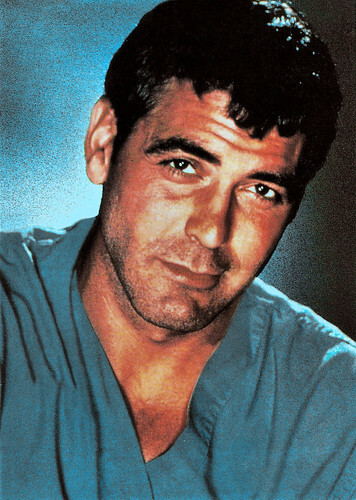
British postcard by Heroes Publishing LTD., London, no. SFC 3039. Photo: George Clooney in the TV Series ER (1994-1999).
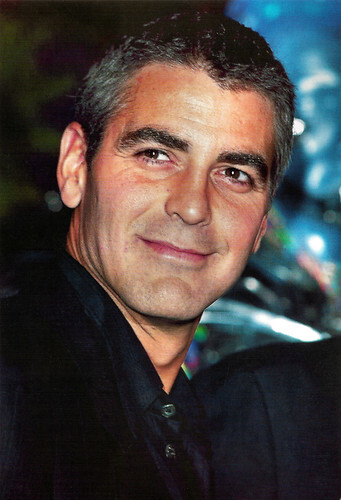
British postcard by Editions Limited, no. PRT-010.
Return of the Killer Tomatoes!
George Timothy Clooney was born in Lexington, Kentucky, in 1961. Clooney is the son of television personality Nicholas Joseph "Nick" Clooney and Nina Bruce Warren. He has an older sister, Ada Zeidler. His father is the brother of singer-actress Rosemary Clooney , who was married to film star José Ferrer, and George is the cousin of their son, actor Miguel Ferrer.
At a young age, Clooney learned how to handle the camera. His father Nick often took his family to public appearances and at the age of five George held the text boards for his father, then a television presenter in Illinois, on a quiz show. It looked like Clooney would follow in his father's footsteps, but that changed when his uncle José Ferrer came to Kentucky to make a film about horse racing with his sons Miguel and Rafael. In it, Clooney also got a role.
The film And They're Off was never released, but Clooney had found his calling. At Augusta High School, Clooney was a gifted baseball player, but during a tryout with the Cincinnati Reds, he proved not good enough to turn pro. Clooney attended Northern Kentucky University from 1979 to 1981, where he studied radio journalism. After he broke off his studies, he held a few random jobs. His father, knowing how difficult it is to succeed as an actor, tried in vain to change his mind.
In the summer of 1982, the determined Clooney spent harvesting tobacco in order to earn enough money to go to Hollywood. In California, he was allowed to live with his aunt Rosemary, although the latter did not wholeheartedly support his aspirations either. For several months, he was her chauffeur on her tour with singers like Martha Raye. After this, Clooney tried to get a job as an actor, but he was constantly rejected, which greatly affected his mood. Eventually, Rosemary felt compelled to ask her cousin to leave.
Clooney moved in with a friend, rookie actor Tom Matthews. He did odd jobs on the sets of commercials and took acting classes at The Beverly Hills Playhouse. Under the guidance of Milton Katselas, he mastered the craft and, as a result of a school project, found an impresario. In the following years, he played several bigger and smaller roles, mostly in moderately received series, never-released films and B-movies like Return of the Killer Tomatoes! (John De Bello, 1988). He was not dissatisfied; he was doing what he loved most: acting and developing himself. Clooney's only longer-lasting role during this period was in the first season of the sitcom Roseanne (1989). In it, he played Booker Brooks, Roseanne's supervisor and temporary boyfriend of her sister.

Vintage postcard, no. PP 137. Photo: George Clooney and Quentin Tarantino in From Dusk Till Dawn (Robert Rodriguez, 1996).
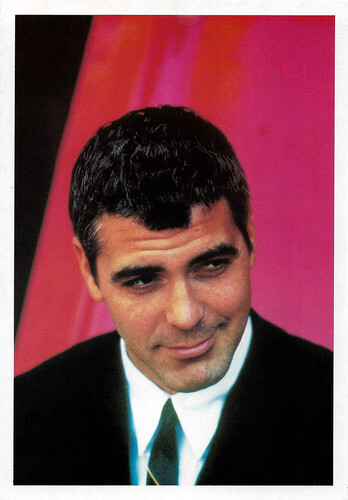
Vintage postcard, no. 134.
From Dusk Till Dawn
George Clooney's breakthrough came in 1994, through his role as Dr Douglas Ross in the hospital series ER (Emergency Room, 1994-1999). His popularity in this television series gave his film career a major boost. The series, which depicted everyday life in a Chicago teaching hospital in a realistic and dramatic manner and ran from 1994 to 1999, became a major international television success.
Clooney rose to become one of the most famous television actors and was especially popular with female viewers. He portrayed the role in 109 episodes from 1994 to 1999 and made a guest appearance in the series in 2009. The Clooneys' sense of family was also expressed in guest appearances by Rosemary Clooney and his cousin Miguel Ferrer.
Now film producers in Hollywood could no longer pass him over. From 1996, the actor established himself as a film star; he appeared in a wide variety of roles. He had great success with the leading role in the Robert Rodriguez-directed film From Dusk Till Dawn (1996), which soon achieved cult status. He also starred alongside Michelle Pfeiffer in the romantic comedy One Fine Day (Michael Hoffmann, 1996).
His final breakthrough came in the role of Batman in the superhero film Batman & Robin (Joel Schumacher, 1997) with Chris O'Donnell. In the same year, he was voted "Sexiest Man Alive" by People Magazine. Clooney demonstrated a preference for whimsical roles such as in O Brother, Where Art Thou? (2000) by the Coen Brothers.
However, he also took leading roles in commercially oriented films such as The Peacemaker (Mimi Leder, 1997) with Nicole Kidman , which featured him as an action hero. The thriller comedy Out of Sight (Steven Soderbergh, 1998) with Jennifer Lopez and the war films The Thin Red Line (Terrence Malick, 1998) and Three Kings (David O. Russell, 1999) with Mark Wahlberg, all received excellent reviews and did well at the box-office.
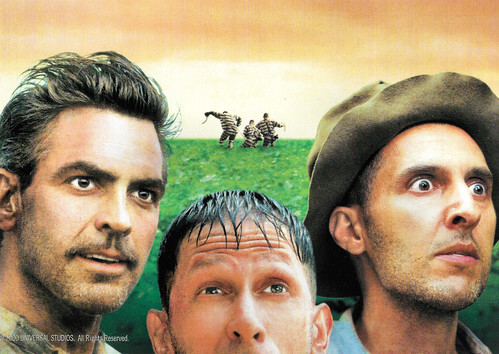
Dutch postcard by Boomerang in the Cult Cards series, no. P25-00. Photo: Universal Studios, 2000. George Clooney, Tim Blake Nelson and John Turturro in O Brother, Where Art Thou (Joel Cohn, Ethan Cohn, 2000).
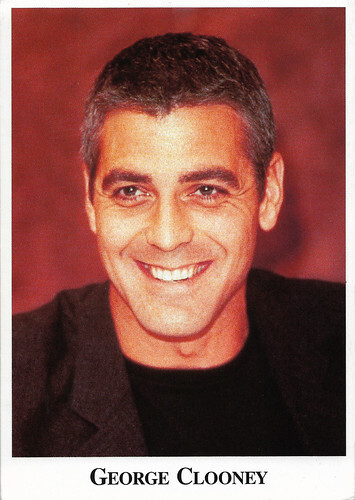
British postcard by Pyramid, Leicester, no. PC 2063.
Gravity
George Clooney received $20,000,000 for the blockbuster Ocean's Eleven (Steven Soderbergh, 2001), a remake of the heist comedy Ocean's 11 (Lewis Milestone, 1960), which also starred Brad Pitt , Matt Damon, and Julia Roberts. Later, he also went on to work as a producer, screenwriter and director. His directorial debut was the spy drama Confessions of a Dangerous Mind (George Clooney, 2002). He also directed the multi-award-winning historical drama Good Night, and Good Luck (George Clooney, 2005), for which he also was a co-screenwriter and one of the actors.
Ocean's Eleven drew two sequels, Ocean’s Twelve (Steven Soderbergh, 2004) and Ocean’s Thirteen (Steven Soderbergh, 2007), in which Clooney also starred. Important in this context was his friendship with director Steven Soderbergh, with whom he founded the company Section Eight. In 2006, it was announced that the company was wound up. Soon after, Clooney founded the production company Smoke House, with close friend Grant Heslov.
Clooney appeared in several Coen Brothers films, including Burn After Reading (Ethan Coen, Joel Coen, 2008) with Frances McDormand and Brad Pitt , and Hail, Caesar! (Ethan Coen, Joel Coen, 2016). He earned Oscar nominations for Best Actor for the legal thriller Michael Clayton (Tony Gilroy, 2007), the comedy-dramas Up in the Air (Jason Reitman, 2009) and The Descendants (Alexander Payne, 2011). A huge box office hit was the Science Fiction thriller Gravity (Alfonso Cuarón, 2013) in which he co-starred with Sandra Bullock and which he also co-wrote.
Clooney's directed the political drama The Ides of March (George Clooney, 2011), in which he also contributed to the screenplay and took on one of the leading roles. The film adaptation of Beau Willimon's play 'Farragut North' focuses on a young idealistic press secretary (played by Ryan Gosling) who, as an employee of a presidential candidate (Clooney), is confronted with fraud and corruption in the Ohio primaries. His other productions as a director include the war film The Monuments Men (George Clooney, 2014), the crime drama Suburbicon (George Clooney, 2017), two episodes of the series Catch-22 (2019) and the Science-Fiction film The Midnight Sky (George Clooney, 2020).
In 1989, George Clooney married actress Talia Balsam, from whom he divorced again in 1993. Clooney had several relationships in the past including with Lisa Snowdon (2000-2005), Sarah Larson (2007-2008), Elisabetta Canalis (2009-2011) and Stacy Keibler (2011-2013). Clooney vowed that he would never marry again. However, in 2014, Clooney married British-Lebanese human rights lawyer Amal Alamuddin; they married in law two days later. They became parents to twins, a daughter and a son, in 2017. This year George Clooney reunited with Julia Roberts in the romantic comedy Ticket to Paradise (Ol Parker, 2022), for which they both also served as executive producers.
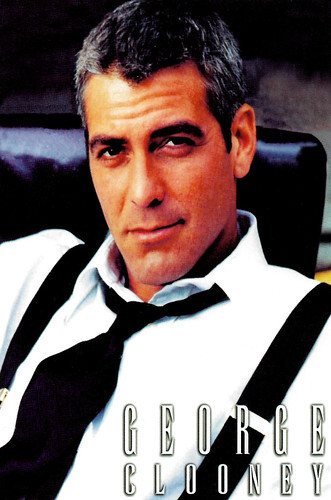
British postcard by Box Office, London, no. BO583.
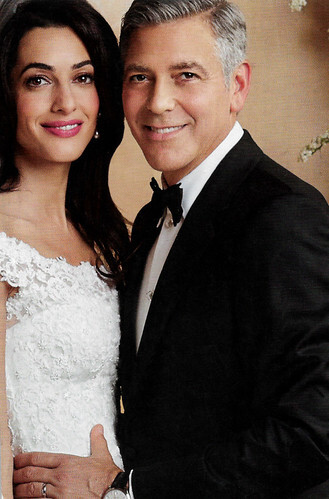
Russian postcard. George Clooney and Amal Clooney.
Sources: Wikipedia (Dutch, German and English), and .

British postcard by Heroes Publishing LTD., London, no. SFC 3039. Photo: George Clooney in the TV Series ER (1994-1999).

British postcard by Editions Limited, no. PRT-010.
Return of the Killer Tomatoes!
George Timothy Clooney was born in Lexington, Kentucky, in 1961. Clooney is the son of television personality Nicholas Joseph "Nick" Clooney and Nina Bruce Warren. He has an older sister, Ada Zeidler. His father is the brother of singer-actress Rosemary Clooney , who was married to film star José Ferrer, and George is the cousin of their son, actor Miguel Ferrer.
At a young age, Clooney learned how to handle the camera. His father Nick often took his family to public appearances and at the age of five George held the text boards for his father, then a television presenter in Illinois, on a quiz show. It looked like Clooney would follow in his father's footsteps, but that changed when his uncle José Ferrer came to Kentucky to make a film about horse racing with his sons Miguel and Rafael. In it, Clooney also got a role.
The film And They're Off was never released, but Clooney had found his calling. At Augusta High School, Clooney was a gifted baseball player, but during a tryout with the Cincinnati Reds, he proved not good enough to turn pro. Clooney attended Northern Kentucky University from 1979 to 1981, where he studied radio journalism. After he broke off his studies, he held a few random jobs. His father, knowing how difficult it is to succeed as an actor, tried in vain to change his mind.
In the summer of 1982, the determined Clooney spent harvesting tobacco in order to earn enough money to go to Hollywood. In California, he was allowed to live with his aunt Rosemary, although the latter did not wholeheartedly support his aspirations either. For several months, he was her chauffeur on her tour with singers like Martha Raye. After this, Clooney tried to get a job as an actor, but he was constantly rejected, which greatly affected his mood. Eventually, Rosemary felt compelled to ask her cousin to leave.
Clooney moved in with a friend, rookie actor Tom Matthews. He did odd jobs on the sets of commercials and took acting classes at The Beverly Hills Playhouse. Under the guidance of Milton Katselas, he mastered the craft and, as a result of a school project, found an impresario. In the following years, he played several bigger and smaller roles, mostly in moderately received series, never-released films and B-movies like Return of the Killer Tomatoes! (John De Bello, 1988). He was not dissatisfied; he was doing what he loved most: acting and developing himself. Clooney's only longer-lasting role during this period was in the first season of the sitcom Roseanne (1989). In it, he played Booker Brooks, Roseanne's supervisor and temporary boyfriend of her sister.

Vintage postcard, no. PP 137. Photo: George Clooney and Quentin Tarantino in From Dusk Till Dawn (Robert Rodriguez, 1996).

Vintage postcard, no. 134.
From Dusk Till Dawn
George Clooney's breakthrough came in 1994, through his role as Dr Douglas Ross in the hospital series ER (Emergency Room, 1994-1999). His popularity in this television series gave his film career a major boost. The series, which depicted everyday life in a Chicago teaching hospital in a realistic and dramatic manner and ran from 1994 to 1999, became a major international television success.
Clooney rose to become one of the most famous television actors and was especially popular with female viewers. He portrayed the role in 109 episodes from 1994 to 1999 and made a guest appearance in the series in 2009. The Clooneys' sense of family was also expressed in guest appearances by Rosemary Clooney and his cousin Miguel Ferrer.
Now film producers in Hollywood could no longer pass him over. From 1996, the actor established himself as a film star; he appeared in a wide variety of roles. He had great success with the leading role in the Robert Rodriguez-directed film From Dusk Till Dawn (1996), which soon achieved cult status. He also starred alongside Michelle Pfeiffer in the romantic comedy One Fine Day (Michael Hoffmann, 1996).
His final breakthrough came in the role of Batman in the superhero film Batman & Robin (Joel Schumacher, 1997) with Chris O'Donnell. In the same year, he was voted "Sexiest Man Alive" by People Magazine. Clooney demonstrated a preference for whimsical roles such as in O Brother, Where Art Thou? (2000) by the Coen Brothers.
However, he also took leading roles in commercially oriented films such as The Peacemaker (Mimi Leder, 1997) with Nicole Kidman , which featured him as an action hero. The thriller comedy Out of Sight (Steven Soderbergh, 1998) with Jennifer Lopez and the war films The Thin Red Line (Terrence Malick, 1998) and Three Kings (David O. Russell, 1999) with Mark Wahlberg, all received excellent reviews and did well at the box-office.

Dutch postcard by Boomerang in the Cult Cards series, no. P25-00. Photo: Universal Studios, 2000. George Clooney, Tim Blake Nelson and John Turturro in O Brother, Where Art Thou (Joel Cohn, Ethan Cohn, 2000).

British postcard by Pyramid, Leicester, no. PC 2063.
Gravity
George Clooney received $20,000,000 for the blockbuster Ocean's Eleven (Steven Soderbergh, 2001), a remake of the heist comedy Ocean's 11 (Lewis Milestone, 1960), which also starred Brad Pitt , Matt Damon, and Julia Roberts. Later, he also went on to work as a producer, screenwriter and director. His directorial debut was the spy drama Confessions of a Dangerous Mind (George Clooney, 2002). He also directed the multi-award-winning historical drama Good Night, and Good Luck (George Clooney, 2005), for which he also was a co-screenwriter and one of the actors.
Ocean's Eleven drew two sequels, Ocean’s Twelve (Steven Soderbergh, 2004) and Ocean’s Thirteen (Steven Soderbergh, 2007), in which Clooney also starred. Important in this context was his friendship with director Steven Soderbergh, with whom he founded the company Section Eight. In 2006, it was announced that the company was wound up. Soon after, Clooney founded the production company Smoke House, with close friend Grant Heslov.
Clooney appeared in several Coen Brothers films, including Burn After Reading (Ethan Coen, Joel Coen, 2008) with Frances McDormand and Brad Pitt , and Hail, Caesar! (Ethan Coen, Joel Coen, 2016). He earned Oscar nominations for Best Actor for the legal thriller Michael Clayton (Tony Gilroy, 2007), the comedy-dramas Up in the Air (Jason Reitman, 2009) and The Descendants (Alexander Payne, 2011). A huge box office hit was the Science Fiction thriller Gravity (Alfonso Cuarón, 2013) in which he co-starred with Sandra Bullock and which he also co-wrote.
Clooney's directed the political drama The Ides of March (George Clooney, 2011), in which he also contributed to the screenplay and took on one of the leading roles. The film adaptation of Beau Willimon's play 'Farragut North' focuses on a young idealistic press secretary (played by Ryan Gosling) who, as an employee of a presidential candidate (Clooney), is confronted with fraud and corruption in the Ohio primaries. His other productions as a director include the war film The Monuments Men (George Clooney, 2014), the crime drama Suburbicon (George Clooney, 2017), two episodes of the series Catch-22 (2019) and the Science-Fiction film The Midnight Sky (George Clooney, 2020).
In 1989, George Clooney married actress Talia Balsam, from whom he divorced again in 1993. Clooney had several relationships in the past including with Lisa Snowdon (2000-2005), Sarah Larson (2007-2008), Elisabetta Canalis (2009-2011) and Stacy Keibler (2011-2013). Clooney vowed that he would never marry again. However, in 2014, Clooney married British-Lebanese human rights lawyer Amal Alamuddin; they married in law two days later. They became parents to twins, a daughter and a son, in 2017. This year George Clooney reunited with Julia Roberts in the romantic comedy Ticket to Paradise (Ol Parker, 2022), for which they both also served as executive producers.

British postcard by Box Office, London, no. BO583.

Russian postcard. George Clooney and Amal Clooney.
Sources: Wikipedia (Dutch, German and English), and .
Published on December 15, 2022 22:00
December 14, 2022
Belinda Lee
English actress Belinda Lee (1935-1961) was a knock-out peroxide starlet who became an authentic brunette star. After a scandal, Rank terminated her contract. Lee moved to Italy where the industry offered her a range of riskier roles that played on her previously contained sexuality.
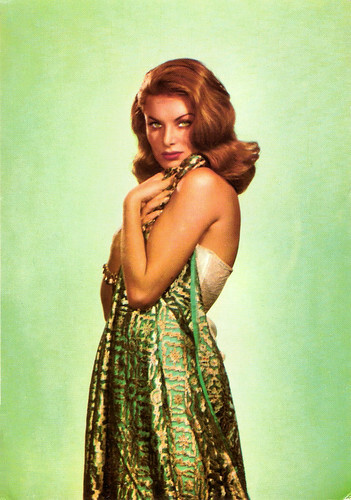
French postcard by Editions P.I., Paris, no. 1003. Photo: Sam Lévin.
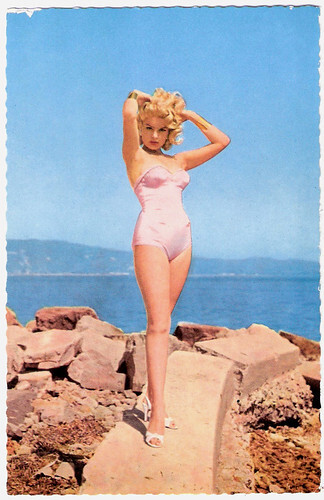 German postcard by Kunst und Bild, Berlin-Charlottenburg, no. C D 21. Photo: Rank-Film.
German postcard by Kunst und Bild, Berlin-Charlottenburg, no. C D 21. Photo: Rank-Film.
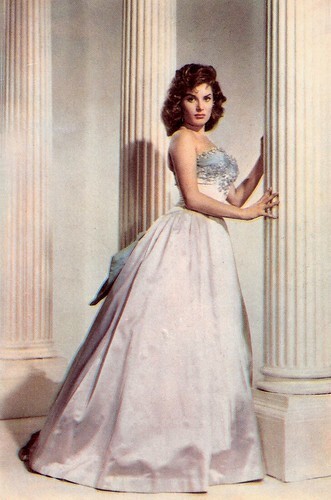
Belgian card by Cox, no. 20.
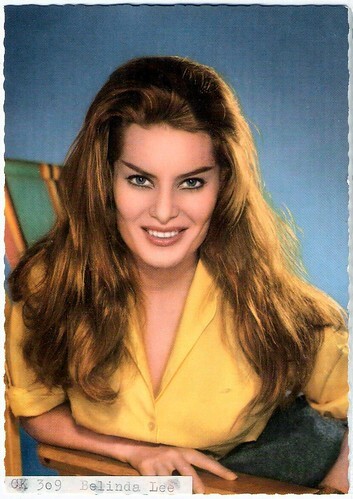
German postcard by Ufa, Berlin-Tempelhof, no. CK-309. Photo: Klaus Collignon / Ufa.
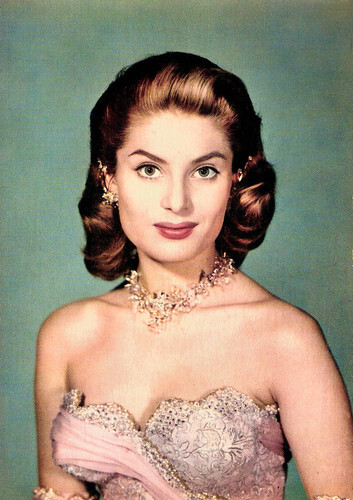
Italian postcard Rotalfoto / Rotalcolor, no. N 75.
Dumb Blonde Pulp-thriller Addict
Belinda Lee was born in Budleigh Salterton, England, in 1935. Her parents were Robert Esmond Lee, a former army captain and owner of the Rosemullion Hotel, and Stella Mary Graham, a florist. They raised Belinda as a good class-English country girl.
Belinda pestered her parents to send her to drama school. They finally relented, and Belinda attended the Tudor Arts Academy in Minehead / Hindhead, Surrey, and later the Royal Academy of Dramatic Arts (RADA). While playing in one of the Academy’s productions, she was spotted by director Val Guest and cast for the comedy The Runaway Bus (1954) with Frankie Howerd and Margaret Rutherford.
Val Guest introduced her to Rank’s still photographer Cornel Lucas, who took some glamour publicity photographs for The Runaway Bus. Lucas was 14 years her senior. They fell madly in love and became engaged. For her role as a dumb blonde pulp-thriller addict in the film, she received good notices.
She was then cast as Amanda, one of the nubile and naughty schoolgirls in The Belles Of St.Trinians (Frank Launder, 1954). This anarchic comedy is set in the riotous, thankfully fictional girls' school St Trinian's, created between 1942 and 1951 by British cartoonist Ronald Searle. It was the first of a series of five films wand starred Alastair Sim in a dual role.
When the Rank Organisation offered her a seven-year contract in 1954, Belinda Lee readily accepted. That same year Lee and Lucas married. Lucas took thousands of photographs of his beautiful wife and sent them to leading newspapers and magazines around the world.
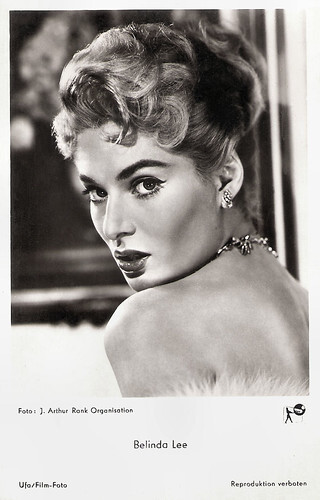
German postcard by Ufa, Berlin-Tempelhof, no. FK 3091. Photo: Cornel Lucas / Arthur Rank Film. Publicity still for Man of the Moment (John Paddy Carstairs, 1955).
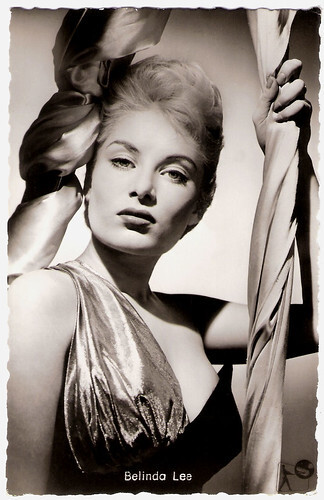
West-German postcard by Kolibri-Verlag G.m.b.H, Minden/Westf., no. 2720. Photo: Cornel Lucas / J. Arhur Rank Organisation.
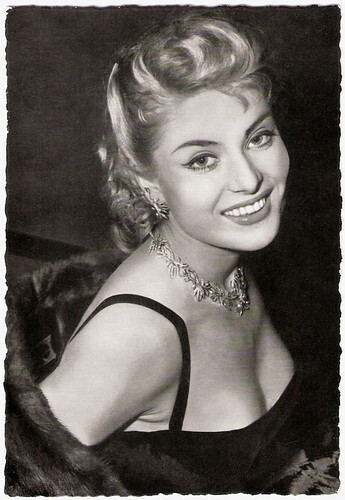
West-German postcard by WS-Druck, Wanne-Eickel. Photo: dpa-Bild.
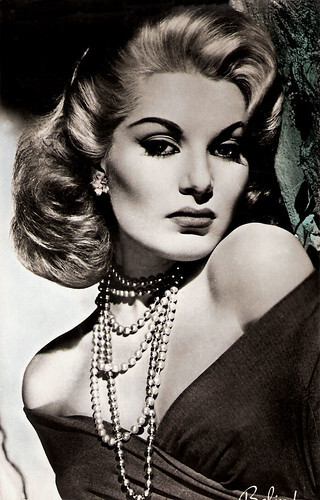
Yugoslavian postcard by Irzarda Nas Glas, Smederevo, no. 105. Photo: Cornel Lucas.
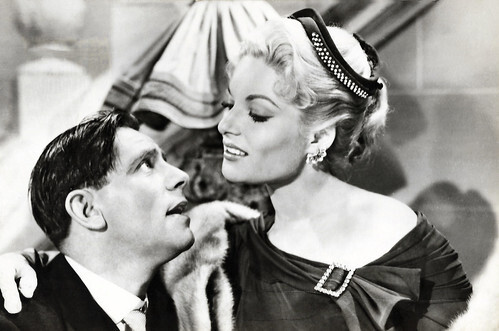
Romanian postcard by Casa Filmului Acin, no. 364. Photo: Norman Wisdom and Belinda Lee in Man of the Moment (John Paddy Carstairs, 1955). Sent by mail in 1972.
Glamorous starlet
Rank typecasted Belinda Lee as one of their glamorous starlets. Dylan Cave at BFI Screenonline : "At the 1955 Cannes film festival she led Rank's glitterati during the studio's uncharacteristic attempt to generate British Cinema glitz. This may well have prompted Diana Dors' outrageous mink bikini at the same event - a barely concealed method of stealing back the limelight."
Lee was often seen as a second-string Diana Dors . Lucas advised her to stop bleaching her hair.
She landed bigger comedy roles opposite stars like Benny Hill in Who Done It? (Basil Dearden, 1956) and was served as typical window dressing in Miracle in Soho (Julian Amyes, 1957).
The swashbuckler Dangerous Exile (Brian Desmond Hurst, 1957) concerned the fate of Louis XVII, who died in 1795 as a boy, yet was popularly believed to have escaped from his French revolutionary captors. Lee played a spirited young woman looking after the refugee heir (Richard O'Sullivan). That year, British exhibitors voted her the 10th most popular British film star at the box office.
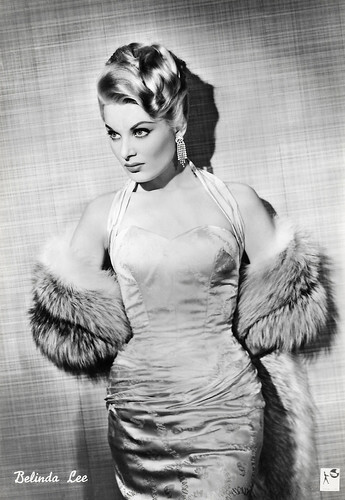
Italian postcard by Bromofoto, Milano, no. 1134. Photo: Rank.
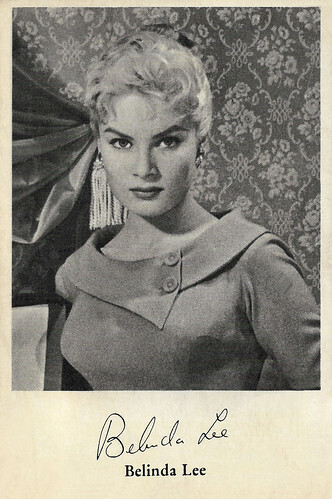
German collectors card. Photo: Rank.
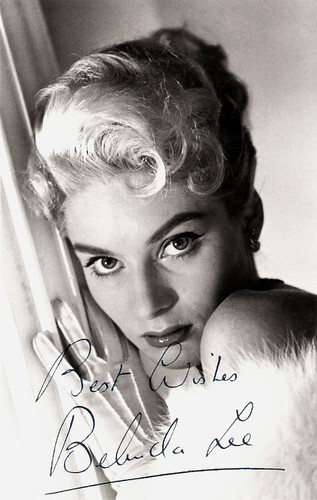
British autograph card by Rank. Photo: Rank.
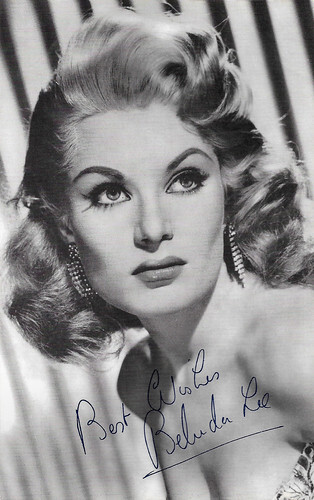
British postcard by Celebrity Autograph Series, no. 244. Photo: J. Arthur Rank Organisation. Publicity still for The Feminine Touch (Pat Jackson, 1956).
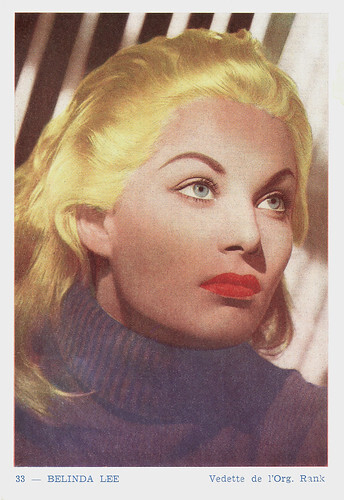
Belgian collectors card by Merbotex for Cine Madeira, Lebbeke, no. 33. Photo: Rank.
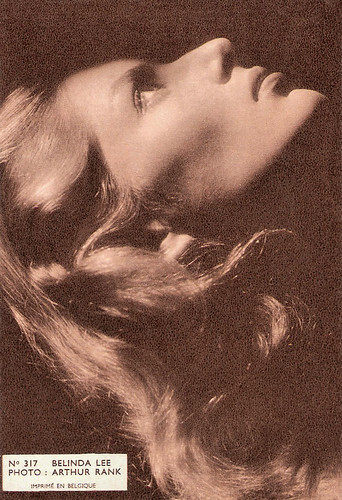
Belgian collectors card (chromo) for Les Cinémas Le Phare and L'Étoile, Nivelles, no. 317. Photo: Arthur Rank.
Scandalous Romance
Belinda Lee then went to Rome to play the female lead, Aphrodite, in La Venera Di Cheronea/Goddess of Love (Fernando Cerchio, Victor Tourjansky, 1958) opposite Jacques Sernas and Massimo Girotti .
She met intelligent, and good-looking Prince Filippo Orsini, head of one of the oldest and finest families in Italy, with many popes and generals in their lineage. Soon there was a romance between the married prince and the also-married film star, and it became an international scandal.
Wikipedia : "Italian newspapers reported that Miss Lee had taken an overdose of sleeping pills. Three days later, papal prince Filippo Orsini, who had been linked to her by the papers, was reported to have been hospitalised after slashing his wrists. Police refused to comment on the newspaper reports linking the two romantically.
Orsini, whose injuries were light, refused to tell the police why he had done it. Lee said that she had been suffering from insomnia and had taken an overdose by mistake. Both were married to others at the time. The Vatican said that Orsini would lose his title if it were proven that he had attempted suicide"
Belinda Lee returned to England for Nor The Moon By Night (Ken Annakin, 1958) in which she was even allowed to suggest sexual desire. However, the scandal significantly damaged the image that Rank had built for Lee and, by the end of 1958, her contract was terminated, and her husband filed for divorce.
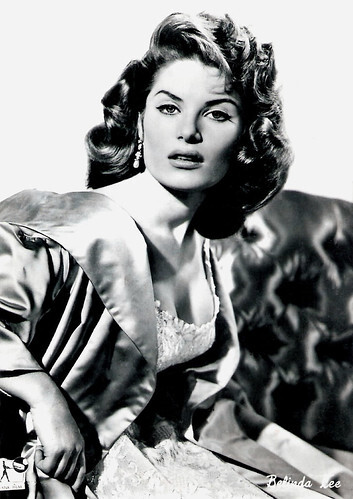
Postcard. Photo: Rank.
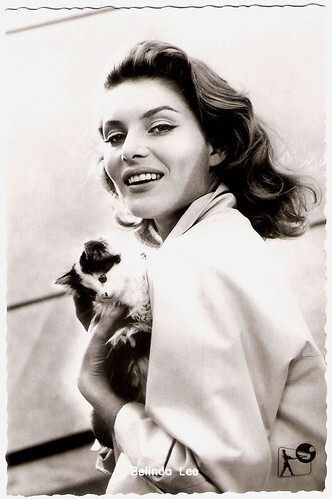
German postcard by Kolibri-Verlag G.m.b.H, Minden/Westf., no. 2942. Photo: J. Arthur-Rank-Film. Publicity still for The Secret Place (Clive Donner, 1957).
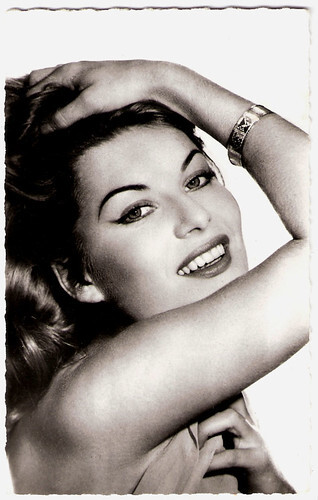
French postcard by Editions du Globe, Paris, no. 731. Photo: Sam Lévin.
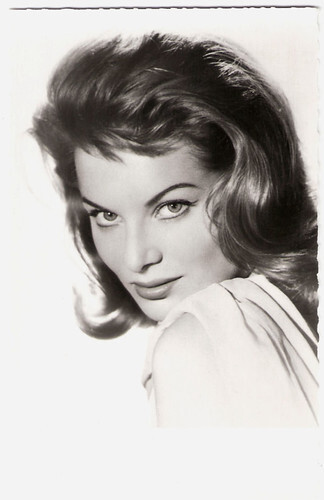
French postcard by Editions P.I., no. 927, presented by Les Carbones Korès Carboplane. Photo: Sam Lévin.
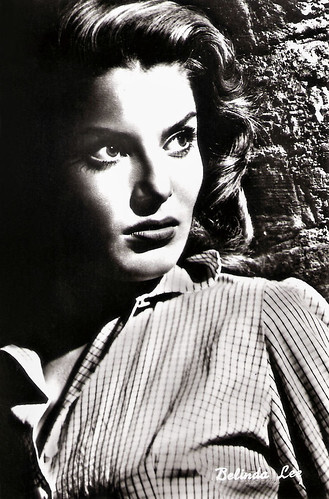
Belgian postcard by Bromophoto, Bruxelles, no. V 45.
Voluptuous temptresses
In 1959, after her divorce from Cornel Lucas, Belinda Lee moved definitively to Italy. Her personal drama worked to Lee's advantage. Avoiding the complete obscurity suffered by many Rank starlets, the European film industry offered her a range of riskier roles that played on her previously contained sexuality.
The parts she played, the colour of her hair, her publicity photographs: all were in marked contrast to her British period. She played voluptuous temptresses in low-budget epics such as Le Notti di Lucrezia Borgia/The Nights of Lucretia Borgia (Sergio Grieco, 1959) and Messalina Venere imperatrice/Messalina (Vittorio Cottafavi, 1960).
Belinda Lee also gave credible dramatic performances in Francesco Rosi's immigration drama I Magliari/The Magliari (1959), in Il Sicario/Blood Feud (Damiano Damiani, 1960) and in the intense war story La lungha notte del 43/The Long Night of '43 (Florestano Vancini, 1960).
While on holiday in California with her boyfriend, filmmaker Gualtiero Jacopetti, she suddenly died in a car accident. Near San Bernardino, California, on US 91, their driver, driving too fast, lost control on the winding road. A tire blew, the car somersaulted and flipped over on its top, and Belinda was thrown out. She was seriously injured and died twenty minutes later of a fractured skull and broken neck in the arms of a California police officer.
Belinda Lee was only 25. It all ended much too soon. Cremated in the States, her ashes were eventually returned to Rome and placed in the Campo Cestio Cemetery. In 1962 Gualtiero Jacopetti presented Mondo Cane, the first and commercially most successful of several sensational feature-length documentaries that focused on lurid and cruel aspects of life. Before he died 50 years later in 2011, he reportedly said he wanted to be buried next to Belinda.
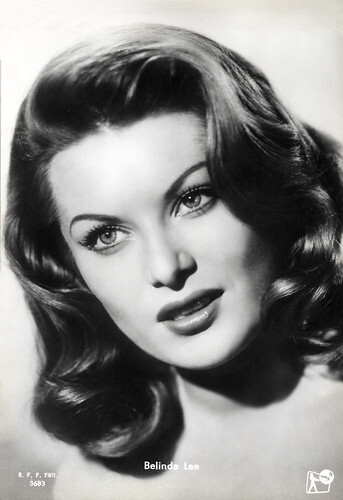
Italian postcard by B.F.F. Edit., no. 3683. Photo: Rank. Publicity still for Nor the Moon by Night (Ken Annakin, 1958).
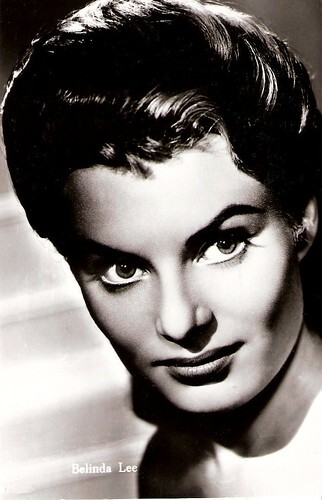
Dutch postcard by Gebr. Spanjersberg, Rotterdam, no. 963.
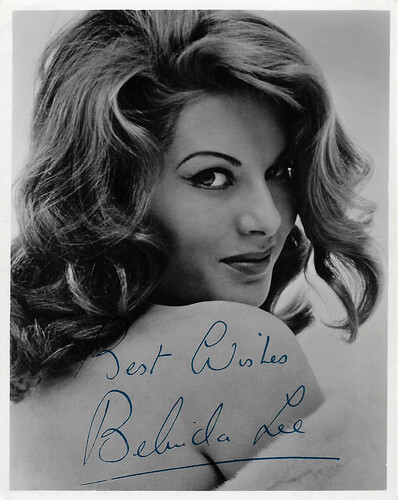
British autograph card by Rank. Photo: Rank.
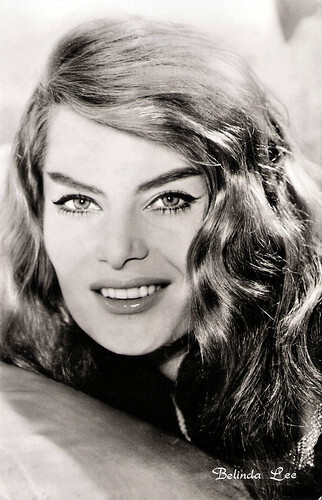
Dutch card.
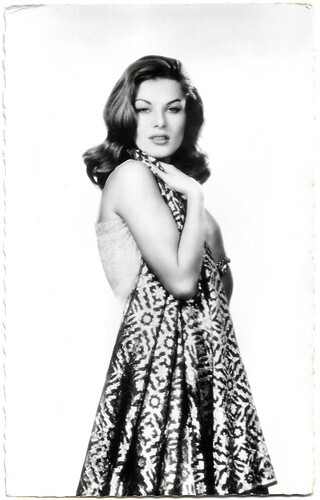
French postcard by Editions du Globe, Paris, no. 846. Photo: Sam Levin.
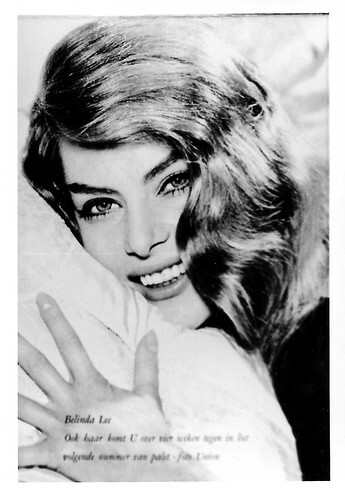
Dutch collectors card. Photo: Union. Caption: Belinda Lee - you will also meet her in the next issue of Palet in four weeks.
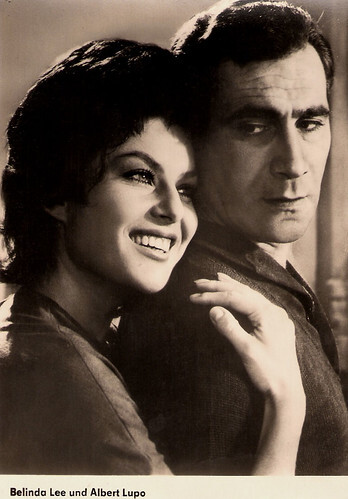
East-German postcard by VEB Progress Filmvertrieb, no. 1636, 1961. Photo: publicity still for Il sicario/Blood Feud (Damiano Damiani, 1960) with Albert Lupo.
Belinda Lee and Ian Carmichael in a scene from The Big Money (1958). Source: Jim Beattie (YouTube).
Sources: Dylan Cave (BFI ScreenOnline), (IMDb), Hal Erickson (AllMovie), Glamour Girls of the Silver Screen, LoveGoddess.info, Wikipedia, and .

French postcard by Editions P.I., Paris, no. 1003. Photo: Sam Lévin.
 German postcard by Kunst und Bild, Berlin-Charlottenburg, no. C D 21. Photo: Rank-Film.
German postcard by Kunst und Bild, Berlin-Charlottenburg, no. C D 21. Photo: Rank-Film.
Belgian card by Cox, no. 20.

German postcard by Ufa, Berlin-Tempelhof, no. CK-309. Photo: Klaus Collignon / Ufa.

Italian postcard Rotalfoto / Rotalcolor, no. N 75.
Dumb Blonde Pulp-thriller Addict
Belinda Lee was born in Budleigh Salterton, England, in 1935. Her parents were Robert Esmond Lee, a former army captain and owner of the Rosemullion Hotel, and Stella Mary Graham, a florist. They raised Belinda as a good class-English country girl.
Belinda pestered her parents to send her to drama school. They finally relented, and Belinda attended the Tudor Arts Academy in Minehead / Hindhead, Surrey, and later the Royal Academy of Dramatic Arts (RADA). While playing in one of the Academy’s productions, she was spotted by director Val Guest and cast for the comedy The Runaway Bus (1954) with Frankie Howerd and Margaret Rutherford.
Val Guest introduced her to Rank’s still photographer Cornel Lucas, who took some glamour publicity photographs for The Runaway Bus. Lucas was 14 years her senior. They fell madly in love and became engaged. For her role as a dumb blonde pulp-thriller addict in the film, she received good notices.
She was then cast as Amanda, one of the nubile and naughty schoolgirls in The Belles Of St.Trinians (Frank Launder, 1954). This anarchic comedy is set in the riotous, thankfully fictional girls' school St Trinian's, created between 1942 and 1951 by British cartoonist Ronald Searle. It was the first of a series of five films wand starred Alastair Sim in a dual role.
When the Rank Organisation offered her a seven-year contract in 1954, Belinda Lee readily accepted. That same year Lee and Lucas married. Lucas took thousands of photographs of his beautiful wife and sent them to leading newspapers and magazines around the world.

German postcard by Ufa, Berlin-Tempelhof, no. FK 3091. Photo: Cornel Lucas / Arthur Rank Film. Publicity still for Man of the Moment (John Paddy Carstairs, 1955).

West-German postcard by Kolibri-Verlag G.m.b.H, Minden/Westf., no. 2720. Photo: Cornel Lucas / J. Arhur Rank Organisation.

West-German postcard by WS-Druck, Wanne-Eickel. Photo: dpa-Bild.

Yugoslavian postcard by Irzarda Nas Glas, Smederevo, no. 105. Photo: Cornel Lucas.

Romanian postcard by Casa Filmului Acin, no. 364. Photo: Norman Wisdom and Belinda Lee in Man of the Moment (John Paddy Carstairs, 1955). Sent by mail in 1972.
Glamorous starlet
Rank typecasted Belinda Lee as one of their glamorous starlets. Dylan Cave at BFI Screenonline : "At the 1955 Cannes film festival she led Rank's glitterati during the studio's uncharacteristic attempt to generate British Cinema glitz. This may well have prompted Diana Dors' outrageous mink bikini at the same event - a barely concealed method of stealing back the limelight."
Lee was often seen as a second-string Diana Dors . Lucas advised her to stop bleaching her hair.
She landed bigger comedy roles opposite stars like Benny Hill in Who Done It? (Basil Dearden, 1956) and was served as typical window dressing in Miracle in Soho (Julian Amyes, 1957).
The swashbuckler Dangerous Exile (Brian Desmond Hurst, 1957) concerned the fate of Louis XVII, who died in 1795 as a boy, yet was popularly believed to have escaped from his French revolutionary captors. Lee played a spirited young woman looking after the refugee heir (Richard O'Sullivan). That year, British exhibitors voted her the 10th most popular British film star at the box office.

Italian postcard by Bromofoto, Milano, no. 1134. Photo: Rank.

German collectors card. Photo: Rank.

British autograph card by Rank. Photo: Rank.

British postcard by Celebrity Autograph Series, no. 244. Photo: J. Arthur Rank Organisation. Publicity still for The Feminine Touch (Pat Jackson, 1956).

Belgian collectors card by Merbotex for Cine Madeira, Lebbeke, no. 33. Photo: Rank.

Belgian collectors card (chromo) for Les Cinémas Le Phare and L'Étoile, Nivelles, no. 317. Photo: Arthur Rank.
Scandalous Romance
Belinda Lee then went to Rome to play the female lead, Aphrodite, in La Venera Di Cheronea/Goddess of Love (Fernando Cerchio, Victor Tourjansky, 1958) opposite Jacques Sernas and Massimo Girotti .
She met intelligent, and good-looking Prince Filippo Orsini, head of one of the oldest and finest families in Italy, with many popes and generals in their lineage. Soon there was a romance between the married prince and the also-married film star, and it became an international scandal.
Wikipedia : "Italian newspapers reported that Miss Lee had taken an overdose of sleeping pills. Three days later, papal prince Filippo Orsini, who had been linked to her by the papers, was reported to have been hospitalised after slashing his wrists. Police refused to comment on the newspaper reports linking the two romantically.
Orsini, whose injuries were light, refused to tell the police why he had done it. Lee said that she had been suffering from insomnia and had taken an overdose by mistake. Both were married to others at the time. The Vatican said that Orsini would lose his title if it were proven that he had attempted suicide"
Belinda Lee returned to England for Nor The Moon By Night (Ken Annakin, 1958) in which she was even allowed to suggest sexual desire. However, the scandal significantly damaged the image that Rank had built for Lee and, by the end of 1958, her contract was terminated, and her husband filed for divorce.

Postcard. Photo: Rank.

German postcard by Kolibri-Verlag G.m.b.H, Minden/Westf., no. 2942. Photo: J. Arthur-Rank-Film. Publicity still for The Secret Place (Clive Donner, 1957).

French postcard by Editions du Globe, Paris, no. 731. Photo: Sam Lévin.

French postcard by Editions P.I., no. 927, presented by Les Carbones Korès Carboplane. Photo: Sam Lévin.

Belgian postcard by Bromophoto, Bruxelles, no. V 45.
Voluptuous temptresses
In 1959, after her divorce from Cornel Lucas, Belinda Lee moved definitively to Italy. Her personal drama worked to Lee's advantage. Avoiding the complete obscurity suffered by many Rank starlets, the European film industry offered her a range of riskier roles that played on her previously contained sexuality.
The parts she played, the colour of her hair, her publicity photographs: all were in marked contrast to her British period. She played voluptuous temptresses in low-budget epics such as Le Notti di Lucrezia Borgia/The Nights of Lucretia Borgia (Sergio Grieco, 1959) and Messalina Venere imperatrice/Messalina (Vittorio Cottafavi, 1960).
Belinda Lee also gave credible dramatic performances in Francesco Rosi's immigration drama I Magliari/The Magliari (1959), in Il Sicario/Blood Feud (Damiano Damiani, 1960) and in the intense war story La lungha notte del 43/The Long Night of '43 (Florestano Vancini, 1960).
While on holiday in California with her boyfriend, filmmaker Gualtiero Jacopetti, she suddenly died in a car accident. Near San Bernardino, California, on US 91, their driver, driving too fast, lost control on the winding road. A tire blew, the car somersaulted and flipped over on its top, and Belinda was thrown out. She was seriously injured and died twenty minutes later of a fractured skull and broken neck in the arms of a California police officer.
Belinda Lee was only 25. It all ended much too soon. Cremated in the States, her ashes were eventually returned to Rome and placed in the Campo Cestio Cemetery. In 1962 Gualtiero Jacopetti presented Mondo Cane, the first and commercially most successful of several sensational feature-length documentaries that focused on lurid and cruel aspects of life. Before he died 50 years later in 2011, he reportedly said he wanted to be buried next to Belinda.

Italian postcard by B.F.F. Edit., no. 3683. Photo: Rank. Publicity still for Nor the Moon by Night (Ken Annakin, 1958).

Dutch postcard by Gebr. Spanjersberg, Rotterdam, no. 963.

British autograph card by Rank. Photo: Rank.

Dutch card.

French postcard by Editions du Globe, Paris, no. 846. Photo: Sam Levin.

Dutch collectors card. Photo: Union. Caption: Belinda Lee - you will also meet her in the next issue of Palet in four weeks.

East-German postcard by VEB Progress Filmvertrieb, no. 1636, 1961. Photo: publicity still for Il sicario/Blood Feud (Damiano Damiani, 1960) with Albert Lupo.
Belinda Lee and Ian Carmichael in a scene from The Big Money (1958). Source: Jim Beattie (YouTube).
Sources: Dylan Cave (BFI ScreenOnline), (IMDb), Hal Erickson (AllMovie), Glamour Girls of the Silver Screen, LoveGoddess.info, Wikipedia, and .
Published on December 14, 2022 22:00
December 13, 2022
Max Mack
German film actor and director Max Mack (1884-1973) was one of the pioneers of German silent cinema. From 1912 until the end of the First World War, Mack was one of the most productive filmmakers. His film Der Andere/The Other (1913) is seen by film historians as the first German auteur film. The Jewish Mack was later forced to emigrate to escape Nazism. He settled in the United Kingdom, where he made his last films in 1935.
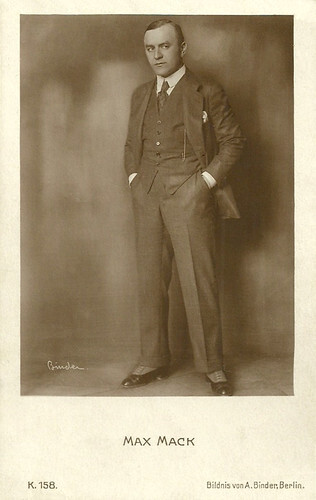
German postcard (by Photochemie), no. K.158. Photo: Alex Binder, Berlin.
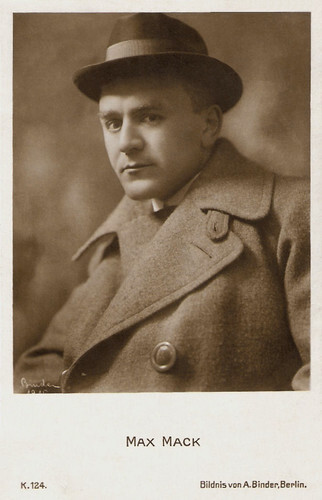
German postcard (by Photochemie), no. K.124. Photo: Alex Binder, Berlin.
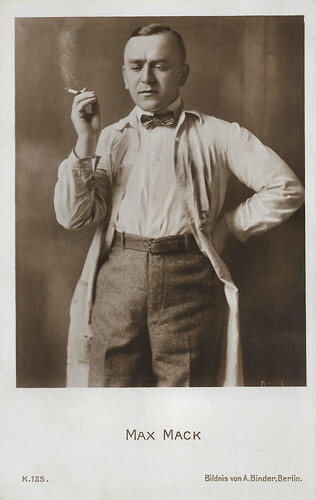
German postcard (by Photochemie), no. K.125. Photo: Alex Binder, Berlin.
Leading in German cinema
Max Mack was born Moritz Myrthenzweig or Maimon Myrthenbaum in 1884 in Halberstadt, Germany. He was the son of a Jewish cantor. After graduating from high school, he briefly pursued plans to go into politics, which he discarded, however, in order to join a travelling theatre troupe as an actor. Max worked as a theatre actor at the Stadttheater Eisenach from 1906. From 1907 he was active in Berlin, briefly also in Max Reinhardt's ensemble. The greatest success of his short - but according to Mack quite instructive - time in the theatre came in 1910 when he appeared as a repertory actor in Max Halbe's 'Jugend' (Youth). At the beginning of 1911 he came for the first time in contact with the film business as a writer for Der ehrliche Finder.
Since he had previously attracted attention in a Japanese role at the theatre, he was cast as an Asian character a few times, such as in his screen debut in the Messter production Japanisches Opfer/Japanese victim (Adolf Gärtner, 1910), starring Friedrich Zelnik . After this film, he was brought to Vitascope, where he acted under the direction of Viggo Larsen and Walter Schmidthässler, first in Die Pulvermühle/The powder mill (Viggo Larsen, 1910) with Larsen and his wife Wanda Treumann .
Soon he began to write scripts to increase his salary from 15 to 25 marks - often adding a small part for himself so he could also work as an actor. In keeping with contemporary taste, he wrote mainly scripts with dramatic plots, but also occasional comedies. He made his directorial debut with Ein seltener Fall/A rare case (Max Mack, 1911) for Deutsche Mutoskop und Biograph. He continued working at Vitascope, now also as a director, first in Gehirnreflexe/Brain reflexes (Max Mack, 1911).
He worked for Deutsche Mutoskop und Biograph, Vitascope, Continental-Kunstfilm, e.g. Zweimal gelebt/Lived twice (Max Mack, 1912) with Eva Speyer and Ernst Rückert , and Eiko-Film, such as Der stellungslose Photograph/The positionless photographer (Max Mack, 1912) with Hanni Weisse . Mack paid much attention to modernity. His frontal, symmetric compositions betray his background in theatre. Mack was much beloved and thus an important film pioneer.
Max Mack's film Der Andere/The Other (1913) premiered before Stellan Rye's more famous Der Student von Prag/The Student from Prague (1913). Mack had written the film together with famous stage author Paul Lindau. Der Andere, with renowned stage actor Albert Bassermann in the double lead roles, had the topic of schizophrenia. It is considered the first German 'Autorenfilm' (auteur film), creating recognition for the film medium among the higher classes.
Also in 1913, Mack was leading in German cinema with the public success of the crime comedy Wo ist Coletti?/Where is Coletti? (Max Mack, 1913), starring Hans Junkermann. It is one of the first films to explicitly exploit the urban landscape of Berlin in a fiction film. In Die blaue Maus/The Blue Mouse (Max Mack, 1913), starring Madge Lessing , he showed his predilection for urban nightlife, vaudeville, masked balls and tango. The comedy became the biggest German box office success before WW I, and was also distributed in the United States. Mack's modernity was also expressed in his emancipatory themes such as in the comedy Die Welt ohne Männer/A World Without Men (Max Mack, 1914), with Madge Lessing , and in crossdressing and masquerades.
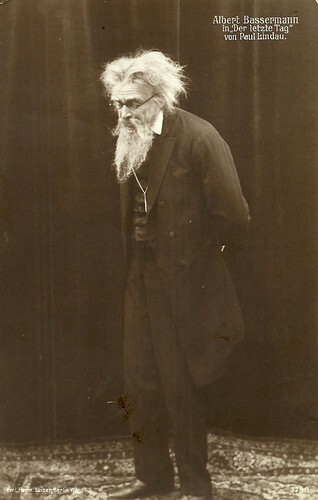
German postcard by Verlag Hermann Leiser, Berlin, no. 7798. Photo: Vitascope. Albert Bassermann in Der letzte Tag/The last day (Max Mack, 1913), scripted by playwright Paul Lindau. Plot: A professor (Bassermann) overthinks his life (in flashback), remembering the decisive day when he killed his longtime cheating and adulterous wife. On his last day, he dies before he can commit suicide.
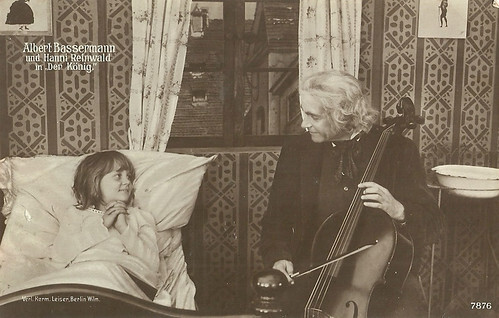
German postcard by Verlag Hermann Leiser, Berlin, no. 7876. Photo: Vitascope. Albert Bassermann and Hanni Reinwald in the film Der König/The King (Max Mack, 1913), based on the novel by Richard Fischer.
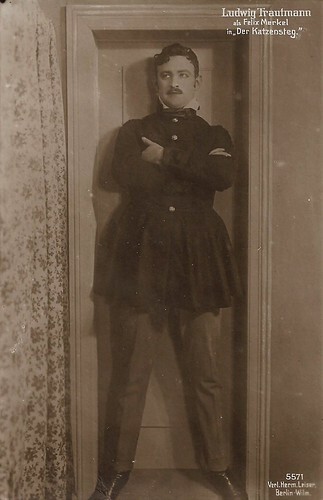
German postcard by Verlag Hermann Leiser, Berlin, no. 5571. Photo: PAGU / Union. Ludwig Trautmann as Felix Merkel in Der Katzensteg/The cat footbridge (Max Mack, 1915), based on the famous novel by Hermann Sudermann, and starring George Lengbach.
A Showman Looks Back
From 1912 until the end of the First World War, Max Mack was one of the most productive filmmakers. He directed, and co-starred in Ein Seltsamer Fall/A strange case (Max Mack, 1914) starring Hanni Weisse and Alwin Neuss , an early film adaptation of Dr. Jekyll and Mr. Hyde written by Richard Oswald. The original title of the film was Sein eigner Mörder (His own Murderer) as it is in the only surviving film material. Due to problems with the German censors it was changed for the official release.
As early as 1915, Ernst Lubitsch had small supporting roles in Max Mack's films. In 1916, Mack and Ewald André Dupont published one of the first books on film theory, 'Die zappelnde Leinwand' (The Fidgeting Canvas). In 1917 he founded his own production company, Max Mack-Film GmbH, which merged in 1919 into Solaris Film. With Der Sohn der Magd/The son of the maid (Max Mack, 1919), Mack took part in the then popular genre of the Aufklärungsfilm (enlightenment film), a genre that dealt with taboo subjects such as prostitution and free love.
In 1920 he quit the company and hence worked for a wide range of firms, including Terra-Film, such as Figaros Hochzeit/Figaro's Wedding (Max Mack, 1920) with Alexander Moissi , Esha-Film, International-Film AG, Ufa and Sokal-Film. In the 1920s Mack worked in a wide range of genres: moral dramas, literary adaptations, realist melodramas, comedies, and even tourist films. Mack already took part in sound film experiments with the sketch Ein Tag Film/One Day Film (1928), the first fictional German sound film and with the youth film Der Kampf der Tertia/Fight of the Tertia (Max Mack, 1929) in which he tried a documentary style with amateur actors. This was to be Mack's last respectable success in Germany.
His first full-length sound film Nur am Rhein…/Only on the Rhine (Max Mack, 1930) starring Daisy D'Ora, Igo Sym , and Truus Van Aalten , took up the then-current topic of the occupation of the Rhine, but the plot of a British officer falling in love with a local German mayor's daughter was considered highly controversial. Tausend für eine Nacht/A Thousand for One Night (Max Mack, 1933) and the two-act film Varieté Nr. 7/Varieté Number 7: A Musical Grotesque (Max Mack, 1933) were his last German films before Max Mack emigrated to London via Prague and Paris in 1933 following Hitler's seizure of power.
Max Mack was involved in 138 films during his film career, predominantly before 1920. With the advent of the National Socialists, he was no longer wanted as a Jew. Via Prague and Paris, he emigrated to Great Britain. The plan to build his career in America remained unsuccessful: the only thing he achieved during his brief excursion to Hollywood was a supporting role in the Paramount film You Belong to Me (Alfred L. Werker, 1934). In England, he directed the only moderately successful quota quickie comedy Be Careful, Mr. Smith (Max Mack, 1935). It was followed by two sketch compilations, The Wigan Express (Max Mack, 1935) and Mack's Comedies (Max Mack, 1935). Mack continued to try to get some projects off the ground and founded Ocean Films Ltd in 1936, but he failed first because of a lack of backers and then because of the war.
So with no practical work opportunities, Mack now began to write down his memoirs, under the title 'With a Sigh and a Smile. A Showman Looks Back'. The book was published in London in 1943. He also continued to write articles on film, many of which had been published since 1914. From the 1940s onwards, he kept his head above water with amateur productions, for which he arranged stage plays whose copyright had expired. He married a well-off widow in London, whose mentally disabled daughter he looked after. In 1965, the German ambassador in London presented him with the Filmband in Gold (Golden Ribbon) for many years of outstanding work in German film but he never returned to Germany. In 1973, Max Mack died in London at the age of 88.
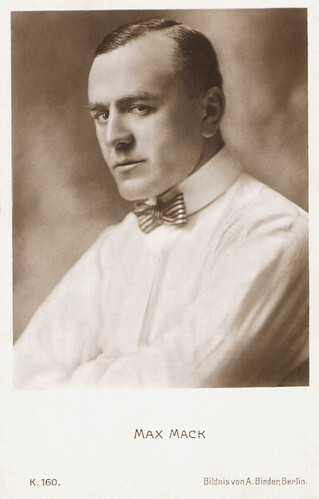
German postcard (by Photochemie), no. K.160. Photo: Alex Binder, Berlin.
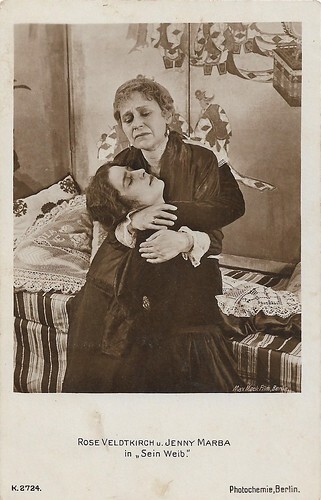
German postcard by Photochemie, no. K.2724. Photo: Max Mack-Film. Rose Veldtkirch and Jenny Marba in Sein Weib/His wife (1918), starring Karl Beckersachs. The film is lost. Plot: A blind man (Beckersachs) has a [his?] child read out compromising letters by his wife (Veldtkirch) and realizes her fidelity.
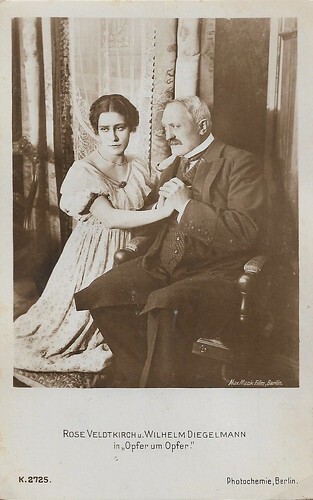
German postcard by Photochemie, no. K.2725. Photo: Max Mack-Film. Rosa Veldtkirch and Wilhelm Diegelmann in Opfer um Opfer/Victim after victim (Max Mack, 1918), starring Karl Beckersachs. The film is lost. The plot deals with a baron (Beckersachs) who ruins the father (Diegelmann) of a girl (Veldtkirch) when the other man doesn't give his consent.
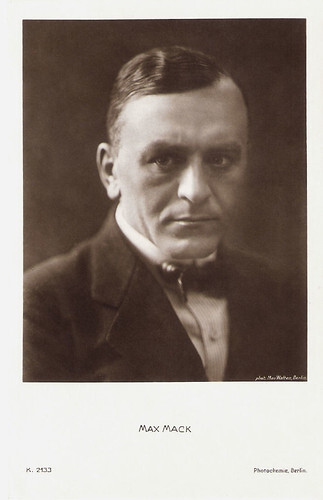
German postcard by Photochemie, no. K.2133. Photo: Mac Walten, Berlin.
Sources: Miranda Reason (Filmportal.de - German), Wikipedia (German and English), and . In 1996, Michael Wedel published 'Max Mack: Showman im Glashaus'. The Desmet Collection of Eye Filmmuseum (Amsterdam) holds tinted prints of the Mack films Zweimal gelebt/Twice lived (1912), Das Paradies der Damen/The Ladies' Paradise (1914) with Hanni Weisse , and Das Urteil des Arztes/The doctor's verdict (1914) with Albert and Else Bassermann, plus the film Vergebens/In vain (Walter Schmidthässler, 1911) in which Mack acted and for which he wrote the script. The Eye collection also holds beautiful posters for Der letzte Tag/The last day and Die Welt ohne Männer/A World Without Men.

German postcard (by Photochemie), no. K.158. Photo: Alex Binder, Berlin.

German postcard (by Photochemie), no. K.124. Photo: Alex Binder, Berlin.

German postcard (by Photochemie), no. K.125. Photo: Alex Binder, Berlin.
Leading in German cinema
Max Mack was born Moritz Myrthenzweig or Maimon Myrthenbaum in 1884 in Halberstadt, Germany. He was the son of a Jewish cantor. After graduating from high school, he briefly pursued plans to go into politics, which he discarded, however, in order to join a travelling theatre troupe as an actor. Max worked as a theatre actor at the Stadttheater Eisenach from 1906. From 1907 he was active in Berlin, briefly also in Max Reinhardt's ensemble. The greatest success of his short - but according to Mack quite instructive - time in the theatre came in 1910 when he appeared as a repertory actor in Max Halbe's 'Jugend' (Youth). At the beginning of 1911 he came for the first time in contact with the film business as a writer for Der ehrliche Finder.
Since he had previously attracted attention in a Japanese role at the theatre, he was cast as an Asian character a few times, such as in his screen debut in the Messter production Japanisches Opfer/Japanese victim (Adolf Gärtner, 1910), starring Friedrich Zelnik . After this film, he was brought to Vitascope, where he acted under the direction of Viggo Larsen and Walter Schmidthässler, first in Die Pulvermühle/The powder mill (Viggo Larsen, 1910) with Larsen and his wife Wanda Treumann .
Soon he began to write scripts to increase his salary from 15 to 25 marks - often adding a small part for himself so he could also work as an actor. In keeping with contemporary taste, he wrote mainly scripts with dramatic plots, but also occasional comedies. He made his directorial debut with Ein seltener Fall/A rare case (Max Mack, 1911) for Deutsche Mutoskop und Biograph. He continued working at Vitascope, now also as a director, first in Gehirnreflexe/Brain reflexes (Max Mack, 1911).
He worked for Deutsche Mutoskop und Biograph, Vitascope, Continental-Kunstfilm, e.g. Zweimal gelebt/Lived twice (Max Mack, 1912) with Eva Speyer and Ernst Rückert , and Eiko-Film, such as Der stellungslose Photograph/The positionless photographer (Max Mack, 1912) with Hanni Weisse . Mack paid much attention to modernity. His frontal, symmetric compositions betray his background in theatre. Mack was much beloved and thus an important film pioneer.
Max Mack's film Der Andere/The Other (1913) premiered before Stellan Rye's more famous Der Student von Prag/The Student from Prague (1913). Mack had written the film together with famous stage author Paul Lindau. Der Andere, with renowned stage actor Albert Bassermann in the double lead roles, had the topic of schizophrenia. It is considered the first German 'Autorenfilm' (auteur film), creating recognition for the film medium among the higher classes.
Also in 1913, Mack was leading in German cinema with the public success of the crime comedy Wo ist Coletti?/Where is Coletti? (Max Mack, 1913), starring Hans Junkermann. It is one of the first films to explicitly exploit the urban landscape of Berlin in a fiction film. In Die blaue Maus/The Blue Mouse (Max Mack, 1913), starring Madge Lessing , he showed his predilection for urban nightlife, vaudeville, masked balls and tango. The comedy became the biggest German box office success before WW I, and was also distributed in the United States. Mack's modernity was also expressed in his emancipatory themes such as in the comedy Die Welt ohne Männer/A World Without Men (Max Mack, 1914), with Madge Lessing , and in crossdressing and masquerades.

German postcard by Verlag Hermann Leiser, Berlin, no. 7798. Photo: Vitascope. Albert Bassermann in Der letzte Tag/The last day (Max Mack, 1913), scripted by playwright Paul Lindau. Plot: A professor (Bassermann) overthinks his life (in flashback), remembering the decisive day when he killed his longtime cheating and adulterous wife. On his last day, he dies before he can commit suicide.

German postcard by Verlag Hermann Leiser, Berlin, no. 7876. Photo: Vitascope. Albert Bassermann and Hanni Reinwald in the film Der König/The King (Max Mack, 1913), based on the novel by Richard Fischer.

German postcard by Verlag Hermann Leiser, Berlin, no. 5571. Photo: PAGU / Union. Ludwig Trautmann as Felix Merkel in Der Katzensteg/The cat footbridge (Max Mack, 1915), based on the famous novel by Hermann Sudermann, and starring George Lengbach.
A Showman Looks Back
From 1912 until the end of the First World War, Max Mack was one of the most productive filmmakers. He directed, and co-starred in Ein Seltsamer Fall/A strange case (Max Mack, 1914) starring Hanni Weisse and Alwin Neuss , an early film adaptation of Dr. Jekyll and Mr. Hyde written by Richard Oswald. The original title of the film was Sein eigner Mörder (His own Murderer) as it is in the only surviving film material. Due to problems with the German censors it was changed for the official release.
As early as 1915, Ernst Lubitsch had small supporting roles in Max Mack's films. In 1916, Mack and Ewald André Dupont published one of the first books on film theory, 'Die zappelnde Leinwand' (The Fidgeting Canvas). In 1917 he founded his own production company, Max Mack-Film GmbH, which merged in 1919 into Solaris Film. With Der Sohn der Magd/The son of the maid (Max Mack, 1919), Mack took part in the then popular genre of the Aufklärungsfilm (enlightenment film), a genre that dealt with taboo subjects such as prostitution and free love.
In 1920 he quit the company and hence worked for a wide range of firms, including Terra-Film, such as Figaros Hochzeit/Figaro's Wedding (Max Mack, 1920) with Alexander Moissi , Esha-Film, International-Film AG, Ufa and Sokal-Film. In the 1920s Mack worked in a wide range of genres: moral dramas, literary adaptations, realist melodramas, comedies, and even tourist films. Mack already took part in sound film experiments with the sketch Ein Tag Film/One Day Film (1928), the first fictional German sound film and with the youth film Der Kampf der Tertia/Fight of the Tertia (Max Mack, 1929) in which he tried a documentary style with amateur actors. This was to be Mack's last respectable success in Germany.
His first full-length sound film Nur am Rhein…/Only on the Rhine (Max Mack, 1930) starring Daisy D'Ora, Igo Sym , and Truus Van Aalten , took up the then-current topic of the occupation of the Rhine, but the plot of a British officer falling in love with a local German mayor's daughter was considered highly controversial. Tausend für eine Nacht/A Thousand for One Night (Max Mack, 1933) and the two-act film Varieté Nr. 7/Varieté Number 7: A Musical Grotesque (Max Mack, 1933) were his last German films before Max Mack emigrated to London via Prague and Paris in 1933 following Hitler's seizure of power.
Max Mack was involved in 138 films during his film career, predominantly before 1920. With the advent of the National Socialists, he was no longer wanted as a Jew. Via Prague and Paris, he emigrated to Great Britain. The plan to build his career in America remained unsuccessful: the only thing he achieved during his brief excursion to Hollywood was a supporting role in the Paramount film You Belong to Me (Alfred L. Werker, 1934). In England, he directed the only moderately successful quota quickie comedy Be Careful, Mr. Smith (Max Mack, 1935). It was followed by two sketch compilations, The Wigan Express (Max Mack, 1935) and Mack's Comedies (Max Mack, 1935). Mack continued to try to get some projects off the ground and founded Ocean Films Ltd in 1936, but he failed first because of a lack of backers and then because of the war.
So with no practical work opportunities, Mack now began to write down his memoirs, under the title 'With a Sigh and a Smile. A Showman Looks Back'. The book was published in London in 1943. He also continued to write articles on film, many of which had been published since 1914. From the 1940s onwards, he kept his head above water with amateur productions, for which he arranged stage plays whose copyright had expired. He married a well-off widow in London, whose mentally disabled daughter he looked after. In 1965, the German ambassador in London presented him with the Filmband in Gold (Golden Ribbon) for many years of outstanding work in German film but he never returned to Germany. In 1973, Max Mack died in London at the age of 88.

German postcard (by Photochemie), no. K.160. Photo: Alex Binder, Berlin.

German postcard by Photochemie, no. K.2724. Photo: Max Mack-Film. Rose Veldtkirch and Jenny Marba in Sein Weib/His wife (1918), starring Karl Beckersachs. The film is lost. Plot: A blind man (Beckersachs) has a [his?] child read out compromising letters by his wife (Veldtkirch) and realizes her fidelity.

German postcard by Photochemie, no. K.2725. Photo: Max Mack-Film. Rosa Veldtkirch and Wilhelm Diegelmann in Opfer um Opfer/Victim after victim (Max Mack, 1918), starring Karl Beckersachs. The film is lost. The plot deals with a baron (Beckersachs) who ruins the father (Diegelmann) of a girl (Veldtkirch) when the other man doesn't give his consent.

German postcard by Photochemie, no. K.2133. Photo: Mac Walten, Berlin.
Sources: Miranda Reason (Filmportal.de - German), Wikipedia (German and English), and . In 1996, Michael Wedel published 'Max Mack: Showman im Glashaus'. The Desmet Collection of Eye Filmmuseum (Amsterdam) holds tinted prints of the Mack films Zweimal gelebt/Twice lived (1912), Das Paradies der Damen/The Ladies' Paradise (1914) with Hanni Weisse , and Das Urteil des Arztes/The doctor's verdict (1914) with Albert and Else Bassermann, plus the film Vergebens/In vain (Walter Schmidthässler, 1911) in which Mack acted and for which he wrote the script. The Eye collection also holds beautiful posters for Der letzte Tag/The last day and Die Welt ohne Männer/A World Without Men.
Published on December 13, 2022 22:00
December 12, 2022
Eugen Burg
Eugen Burg (1871-1944) was a German actor, writer and film director. He appeared on many stages in Germany and Austria and often worked with his good friend Max Reinhardt. From 1915, he acted in and directed silent films and becamne a well-known character actor in the Weimar cinema. From 1935, he was unemployed, classified by the Nazis as a 'full Jew'. His daughter was actress Hansi Burg, the wife of Hans Albers.
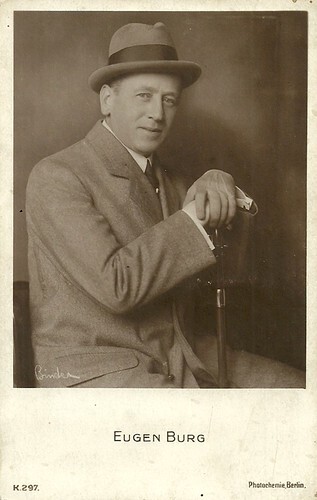
German postcard by Photochemie, Berlin, no. K.297. Photo: Alex Binder.
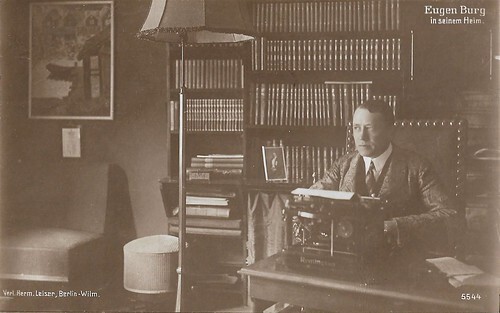
German postcard by Verlag Hermann Leiser, Berlin-Wilm., no. 5544. Caption: Eugen Burg in seinem Heim (Eugen Burg at home).
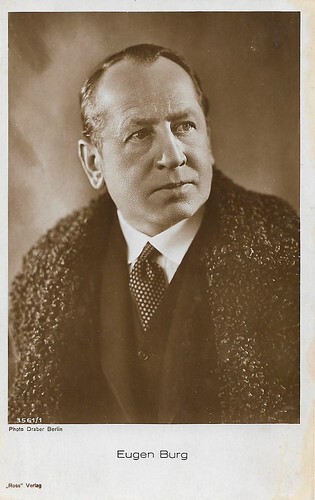
German postcard by Ross Verlag, no. 3561/1, 1928-1929. Photo Draber, Berlin.
A group of theatre-loving young people
Eugen Burg was born as Eugen Hirschburg in 1871 in Berlin. He was supposed to become a merchant, but he left his native Berlin in the 1890s to pursue a stage career in Vienna. There he received acting training from Maximilian Streben, then director of the Sulkowsky Private Theatre in the Viennese suburb of Matzleinsdorf.
Around the same time, Max Reinhardt also took acting lessons from Maximilian Streben. They began a lifelong friendship. Eugen Burg and Max Reinhardt belonged to a group of theatre-loving young people who called themselves the "Leopoldstadters", as most of them were residents of Vienna's Leopoldstadt. This group of theatre enthusiasts also included Luis Taufstein, with whom Eugen Burg wrote several plays.
Eugen Burg specialised in the role of the young lover and bon vivant. He made his stage debut in 1889 in the Bohemian spa town of Franzensbad in the comedy 'Die Wilddiebe' by Theodor Herzl, in the role of Max von Thürmer. In the years following his stage debut, Burg appeared on various imperial and royal provincial stages (Bielitz, Wiener Neustadt, Bad Ischl, Reichenberg, Troppau). In 1893 Eugen Burg was briefly engaged at the Jantsch Theatre in Vienna.
In the summer of 1894 he followed the call of director and theatre manager Otto Brahm to the Deutsches Theater in Berlin, where Eugen Burg appeared on stage with Joseph Kainz and Agnes Sorma until 1896. Another engagement in Vienna at the Raimund-Theater (1900-1904) was followed by a season at the Deutsches Schauspielhaus in Hamburg, which he left in 1905 to return to the Deutsches Theater, which by then was already directed by his friend Max Reinhardt. Between 1908 and 1909, Burg appeared at the Deutsches Theater in New York, where he also served as head director.
From 1910, Eugen Burg was then permanently based in Berlin and acted on several Berlin stages (Neues Schauspielhaus, Berliner Theater, Trianon-Theater, Residenz-Theater, Rotter-Bühnen, Deutsches Künstlertheater, Kleines Theater, Komische Oper). From 1935, after a last engagement at the theatre in Behrenstraße, he remained unemployed, classified by the Nazis as a 'full Jew'.
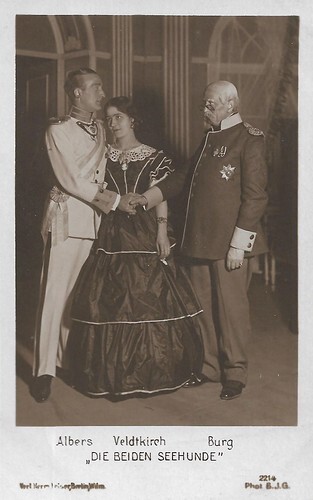
German postcard by Verlag Hermann Leiser, no. 2214. Photo: B.J.G. Hans Albers , Rose Veldtkirch, and Eugen Burg in the play 'Die beiden Seehunde' (The Two Seals), performed in 1918 at the Komödienhaus Berlin, and starring Albers as the Crown Prince. Albers was a close friend of Burg and later his son-in-law.
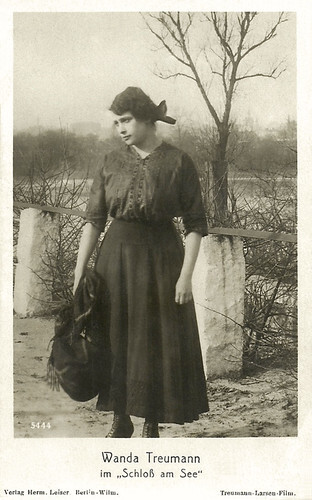
German postcard by Verlag Hermann Leiser, Berlin, no. 5444. Photo: Treumann-Larsen Film. Wanda Treumann in Im Schloß am See (Eugen Burg, 1918). Treumann's co-actors in this film were a.o. Eugen Burg, Carl Beckersachs and Reinhold Schünzel . It was approved by the German censor in May 1918.
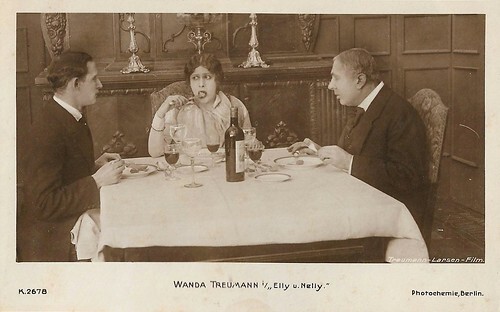
German postcard by Photochemie, no. K. 2678. Photo: Treumann-Larsen Film. Wanda Treumann in the German silent comedy Elly und Nelly (Eugen Burg, 1918). The film passed German censorship in August 1918.
Banned from working by the Nazis
Eugen Burg was already 43 years old and a well-known stage actor when he appeared in front of the camera for the first time in 1914. At the Berlin PAGU studio, he was one of the earliest impersonators of Sherlock Holmes on screen, he played the famous detective in Das dunkle Schloß/The Dark Castle (Willy Zeyn, 1915) with Hanni Weisse and Friedrich Zelnik . Burg also appeared with Ferdinand Bonn as the title characters in the farce Robert und Bertram/Robert and Bertram (Max Mack, 1915). Several more films by Mack followed.
From 1916, Burg started to direct too. He first made films with Ressel Orla , such as Gaugräfin Fifi/Gau countess Fifi (1916) and Gräfin Lukani/Countess Lukani (1917). From 1918 he directed a series of films with Wanda Treumann including Im Schloß am See/In the castle by the lake (1918), Elly und Nelly/Elly and Nelly (1918), Liebe, die sich frei verschenkt/Love that gives itself away freely (1919), Das Hexenlied/The Witches' Song (1919) Salome (1920), and Ninon de l'Enclos (1920).
In addition, he acted opposite Treumann in films directed by others such as Helga (N.N., 1918) and Die Prinzessin von Montecuculi/The Princess of Montecuculi (N.N., 1918). From 1920 he entirely focused on film acting and stopped directing. Burg became an important character actor in Weimar cinema, in films by a.o. Manfred Noa, Harry Piel , Carl Wilhelm, Friedrich Zelnik and opposite such stars as Hans Albers, Marcella Albani , Lya Mara , and Piel.
After some 70 films silent films as an actor, his first sound film followed with the crime film Der Greifer/The Snatcher (Richard Eichberg, 1930). Alongside his pupil and protégé Hans Albers , Burg appeared here in the role of a chief inspector at Scotland Yard. He would also act opposite Albers in Der Sieger/The Winner (Hans Hinrich, Paul Martin, 1932), Der Draufgänger/The Daredevil (Richard Eichberg, 1931), and Der weiße Dämon/Dope (Kurt Gerron, 1932).
After the National Socialists came to power in 1933, Burg lost his engagement at Ufa because of his Jewishness and was expelled by the Reichsfachschaft Film from the Reichstheaterkammer and the Reichsfilmkammer and thus banned from working, which abruptly ended his career. Burg fled to Holland and was arrested there after the German invasion.
Eugen Burg was married to the coloratura singer and stage singer Emmy Burg-Raabe, who later worked as a concert singer and finally as a singing teacher. He was the father of the actress Hansi Burg, who had been Hans Albers' partner since 1925, and who had sometimes acted in Burg's own films. Burg was deported from Berlin to the Theresienstadt concentration camp together with his second wife on 28 January 1943. He was seriously ill and almost blind and died at the age of 73 in the home of the blind in the Theresienstadt concentration camp.
As mentioned, Burg's daughter Hansi became known for her long-term relationship with Albers whom she met while they were acting together. The Nazi Propaganda Minister Joseph Goebbels forced them in 1935 to split up because she was Jewish, although they remained in secret contact. Hansi did a fake marriage with a Norwegian architect and art dealer, but de facto she lived with Albers in Bavaria. In 1939 she fled via Switzerland to Britain and lived in exile in Great Britain during the war. She returned in 1945 and settled down to live with Albers again.
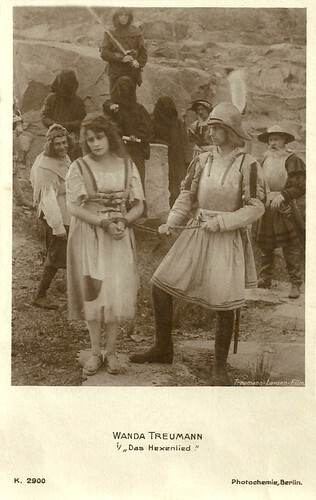
German postcard by Photochemie, no. K. 2900. Photo: Treumann-Larsen Film. Wanda Treumann in Das Hexenlied (Eugen Burg, 1919).
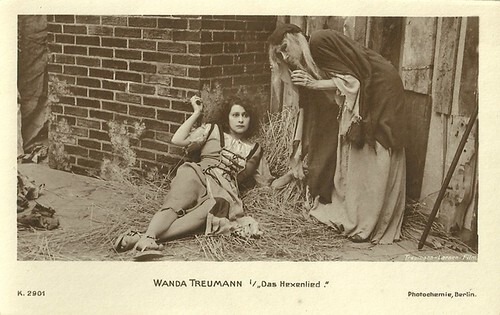
German postcard by Photochemie, no. K. 2901. Photo: Treumann-Larsen Film. Wanda Treumann in Das Hexenlied (Eugen Burg, 1919).
Sources: Wikipedia (German) and .

German postcard by Photochemie, Berlin, no. K.297. Photo: Alex Binder.

German postcard by Verlag Hermann Leiser, Berlin-Wilm., no. 5544. Caption: Eugen Burg in seinem Heim (Eugen Burg at home).

German postcard by Ross Verlag, no. 3561/1, 1928-1929. Photo Draber, Berlin.
A group of theatre-loving young people
Eugen Burg was born as Eugen Hirschburg in 1871 in Berlin. He was supposed to become a merchant, but he left his native Berlin in the 1890s to pursue a stage career in Vienna. There he received acting training from Maximilian Streben, then director of the Sulkowsky Private Theatre in the Viennese suburb of Matzleinsdorf.
Around the same time, Max Reinhardt also took acting lessons from Maximilian Streben. They began a lifelong friendship. Eugen Burg and Max Reinhardt belonged to a group of theatre-loving young people who called themselves the "Leopoldstadters", as most of them were residents of Vienna's Leopoldstadt. This group of theatre enthusiasts also included Luis Taufstein, with whom Eugen Burg wrote several plays.
Eugen Burg specialised in the role of the young lover and bon vivant. He made his stage debut in 1889 in the Bohemian spa town of Franzensbad in the comedy 'Die Wilddiebe' by Theodor Herzl, in the role of Max von Thürmer. In the years following his stage debut, Burg appeared on various imperial and royal provincial stages (Bielitz, Wiener Neustadt, Bad Ischl, Reichenberg, Troppau). In 1893 Eugen Burg was briefly engaged at the Jantsch Theatre in Vienna.
In the summer of 1894 he followed the call of director and theatre manager Otto Brahm to the Deutsches Theater in Berlin, where Eugen Burg appeared on stage with Joseph Kainz and Agnes Sorma until 1896. Another engagement in Vienna at the Raimund-Theater (1900-1904) was followed by a season at the Deutsches Schauspielhaus in Hamburg, which he left in 1905 to return to the Deutsches Theater, which by then was already directed by his friend Max Reinhardt. Between 1908 and 1909, Burg appeared at the Deutsches Theater in New York, where he also served as head director.
From 1910, Eugen Burg was then permanently based in Berlin and acted on several Berlin stages (Neues Schauspielhaus, Berliner Theater, Trianon-Theater, Residenz-Theater, Rotter-Bühnen, Deutsches Künstlertheater, Kleines Theater, Komische Oper). From 1935, after a last engagement at the theatre in Behrenstraße, he remained unemployed, classified by the Nazis as a 'full Jew'.

German postcard by Verlag Hermann Leiser, no. 2214. Photo: B.J.G. Hans Albers , Rose Veldtkirch, and Eugen Burg in the play 'Die beiden Seehunde' (The Two Seals), performed in 1918 at the Komödienhaus Berlin, and starring Albers as the Crown Prince. Albers was a close friend of Burg and later his son-in-law.

German postcard by Verlag Hermann Leiser, Berlin, no. 5444. Photo: Treumann-Larsen Film. Wanda Treumann in Im Schloß am See (Eugen Burg, 1918). Treumann's co-actors in this film were a.o. Eugen Burg, Carl Beckersachs and Reinhold Schünzel . It was approved by the German censor in May 1918.

German postcard by Photochemie, no. K. 2678. Photo: Treumann-Larsen Film. Wanda Treumann in the German silent comedy Elly und Nelly (Eugen Burg, 1918). The film passed German censorship in August 1918.
Banned from working by the Nazis
Eugen Burg was already 43 years old and a well-known stage actor when he appeared in front of the camera for the first time in 1914. At the Berlin PAGU studio, he was one of the earliest impersonators of Sherlock Holmes on screen, he played the famous detective in Das dunkle Schloß/The Dark Castle (Willy Zeyn, 1915) with Hanni Weisse and Friedrich Zelnik . Burg also appeared with Ferdinand Bonn as the title characters in the farce Robert und Bertram/Robert and Bertram (Max Mack, 1915). Several more films by Mack followed.
From 1916, Burg started to direct too. He first made films with Ressel Orla , such as Gaugräfin Fifi/Gau countess Fifi (1916) and Gräfin Lukani/Countess Lukani (1917). From 1918 he directed a series of films with Wanda Treumann including Im Schloß am See/In the castle by the lake (1918), Elly und Nelly/Elly and Nelly (1918), Liebe, die sich frei verschenkt/Love that gives itself away freely (1919), Das Hexenlied/The Witches' Song (1919) Salome (1920), and Ninon de l'Enclos (1920).
In addition, he acted opposite Treumann in films directed by others such as Helga (N.N., 1918) and Die Prinzessin von Montecuculi/The Princess of Montecuculi (N.N., 1918). From 1920 he entirely focused on film acting and stopped directing. Burg became an important character actor in Weimar cinema, in films by a.o. Manfred Noa, Harry Piel , Carl Wilhelm, Friedrich Zelnik and opposite such stars as Hans Albers, Marcella Albani , Lya Mara , and Piel.
After some 70 films silent films as an actor, his first sound film followed with the crime film Der Greifer/The Snatcher (Richard Eichberg, 1930). Alongside his pupil and protégé Hans Albers , Burg appeared here in the role of a chief inspector at Scotland Yard. He would also act opposite Albers in Der Sieger/The Winner (Hans Hinrich, Paul Martin, 1932), Der Draufgänger/The Daredevil (Richard Eichberg, 1931), and Der weiße Dämon/Dope (Kurt Gerron, 1932).
After the National Socialists came to power in 1933, Burg lost his engagement at Ufa because of his Jewishness and was expelled by the Reichsfachschaft Film from the Reichstheaterkammer and the Reichsfilmkammer and thus banned from working, which abruptly ended his career. Burg fled to Holland and was arrested there after the German invasion.
Eugen Burg was married to the coloratura singer and stage singer Emmy Burg-Raabe, who later worked as a concert singer and finally as a singing teacher. He was the father of the actress Hansi Burg, who had been Hans Albers' partner since 1925, and who had sometimes acted in Burg's own films. Burg was deported from Berlin to the Theresienstadt concentration camp together with his second wife on 28 January 1943. He was seriously ill and almost blind and died at the age of 73 in the home of the blind in the Theresienstadt concentration camp.
As mentioned, Burg's daughter Hansi became known for her long-term relationship with Albers whom she met while they were acting together. The Nazi Propaganda Minister Joseph Goebbels forced them in 1935 to split up because she was Jewish, although they remained in secret contact. Hansi did a fake marriage with a Norwegian architect and art dealer, but de facto she lived with Albers in Bavaria. In 1939 she fled via Switzerland to Britain and lived in exile in Great Britain during the war. She returned in 1945 and settled down to live with Albers again.

German postcard by Photochemie, no. K. 2900. Photo: Treumann-Larsen Film. Wanda Treumann in Das Hexenlied (Eugen Burg, 1919).

German postcard by Photochemie, no. K. 2901. Photo: Treumann-Larsen Film. Wanda Treumann in Das Hexenlied (Eugen Burg, 1919).
Sources: Wikipedia (German) and .
Published on December 12, 2022 22:00
December 11, 2022
A Sainted Devil (1924)
Rudolph Valentino's silent drama A Sainted Devil (Joseph Henabery, 1924), produced by Famous Players-Lasky Corporation, is now considered a lost film. This post is the second of three specials on films starring Hollywood's ultimate 'Latin Lover'.
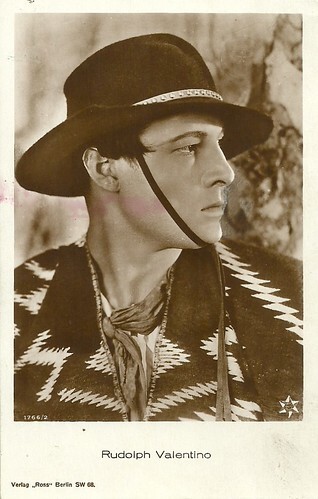
German postcard by Ross Verlag, no. 1766/2, 1927-1928. Rudolph Valentino in A Sainted Devil (Joseph Henabery, 1924).
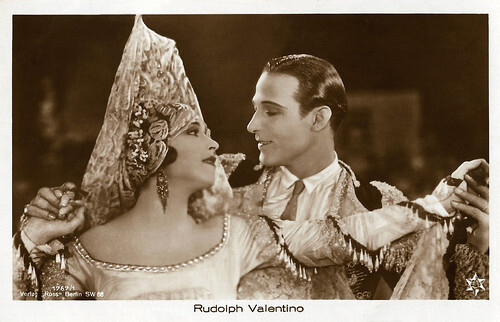
German postcard by Ross Verlag, no. 1767/1, 1927-1928. Photo Stern Film Verleih. Rudolph Valentino and Helena D'Algy in the American silent film A Sainted Devil (Joseph Henabery, 1924).
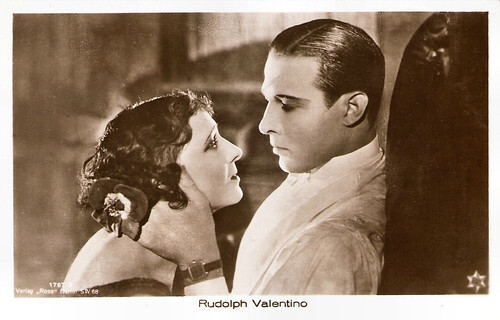
German postcard for Ross Verlag, Berlin, no. 1767/2, 1927-1928. Photo: Famous Players-Lasky Corporation. Rudolph Valentino and Dagmar Godowsky in A Sainted Devil (Joseph Henabery, 1924).
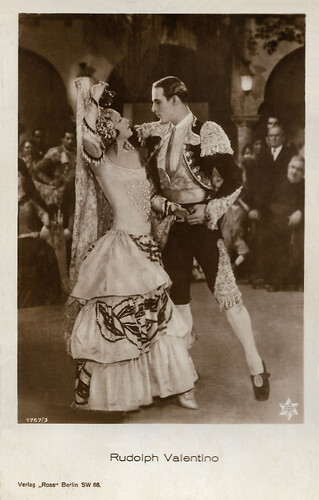
German postcard by Ross Verlag, no. 1767/3, 1927-1928. Photo Stern Film Verleih. Rudolph Valentino and Helena D'Algy in the American silent film A Sainted Devil (Joseph Henabery, 1924).
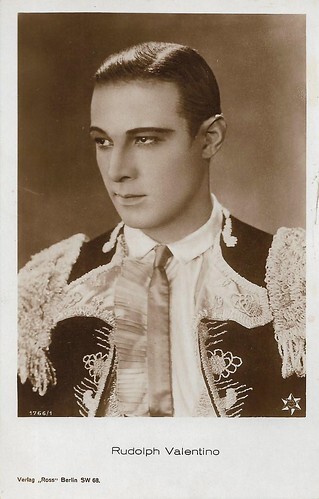
German postcard by Verlag Ross, Berlin, no. 1766/1. Photo: Stern Film Verleih. Rudolph Valentino in A Sainted Devil (Joseph Henabery, 1924). The back of the card has writings in French. In France, the film was released as L'hacienda rouge.
Kidnapped on her wedding night
In accordance with custom, Castro arranges the marriage of his son, Don Alonzo de Castro, an attractive Latino grandee from old Spanish nobility ( Rudolph Valentino ), with Julietta (Helena or Helen D'Algy), a beautiful and lovely Argentinean woman he has never met before. She comes to the South American state for the wedding.
The lavish party is to be celebrated at de Castro's sprawling hacienda. But Alonzo has not reckoned with his ex, the fiery and hot-blooded Carlotta (Nita Naldi). The daughter of the majordomo is jealous. With her father, she teams up with El Tigre (George Siegmann), the notorious Bandido leader who has been making the area unsafe for some time. When he and his gang raid the wedding feast, the villain's sole target is the bride. A fierce fight ensues, but the nobleman is defeated and cannot prevent Julietta from being kidnapped.
Don Alonzo immediately chases after the criminals and is able to confront them in their camp, which they have set up in a ruined church. From his hiding place, the robbed groom witnesses a woman in wedding clothes embracing and kissing El Tigre. Alonzo automatically believes that this can only be his Julietta.
From now on, Alonzo and El Tigre are mortal enemies, and after another encounter, in which Don Alonzo manages to escape in an adventurous manner, the Spanish nobleman swears eternal revenge. However, Alonzo has also lost his faith in his newly wedded wife, Julietta. He cannot make sense of why this chaste girl, who was educated in a convent, throws herself so shamelessly at the neck of a proven villain. The landowner has no idea that what he really saw was Carlotta, the mastermind of this plot, throwing herself into Julietta's wedding dress and embracing the chief villain.
While Alonzo increasingly focuses all his senses on stopping El Tigre, Julietta manages to free herself a little later with the help of the dancer Carmelita ( Louise Lagrange ). The bride finds shelter in a women's convent, where she is protected from El Tigre's persecution for the time being. But Don Alonzo knows nothing of these events. More and more he threatens to mutate into an avenging angel and drunkard, unable to get over the loss of his own wife and her supposed love affair with El Tigre: a holy devil, as the film title suggests.
When Don Alonzo learns that El Tigre is supposed to be in a sinister, ill-reputed pub, the Spanish grandee seeks direct confrontation with the chief scoundrel. Here it comes to a showdown. When Alonzo enters the tavern and sees El Tigre coming down the stairs, he jumps on him without warning and is about to strangle the bandit chief. Carlotta, who is also present, lets out a sharp cry, and the groom also has to realise that a dead villain cannot tell him the whereabouts of his wife.
El Tigre uses the upper hand he thinks he has gained and is about to kill Don Alonzo when the 'haciendero' receives unexpected help from Don Luis (Antonio a.k.a. Tony D'Algy). The latter is a mortal enemy of El Tigre and cuts down the chief villain. Now Don Alonzo also learns that it was actually Carlotta who embraced and kissed El Tigre in the bandit camp. Although Carmelita, the escape helper, is in love with Don Alonzo herself, she finally reveals to him the whereabouts of his newlyweds, so that the young couple can finally embrace again and can start a new life together.
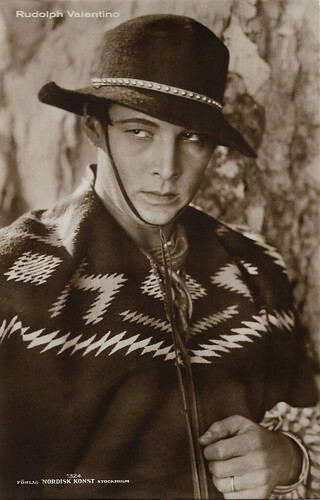
Swedish postcard by Förlag Nordisk Konst, Stockholm, no. 1324. Rudolph Valentino in A Sainted Devil (Joseph Henabery, 1924).
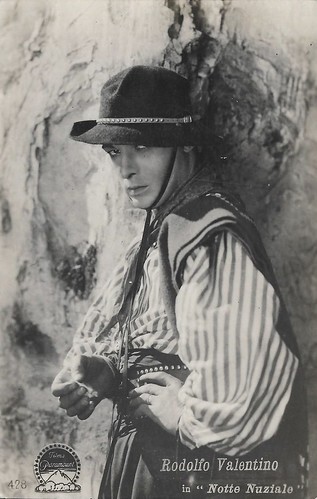
Italian postcard by Ed. Ballerini & Fratini, Florence, no. 428. Photo: Films Paramount. Rudolph Valentino in A Sainted Devil (Joseph Henabery, 1924).
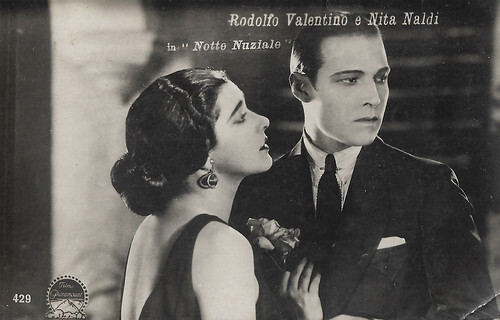
Italian postcard by Ed. Ballerini & Fratini, Florence, no. 429. Photo: Films Paramount. Rudolph Valentino and Nita Naldi in A Sainted Devil (Joseph Henabery, 1924). The Italian title Notte nuziale translates as Wedding Night.
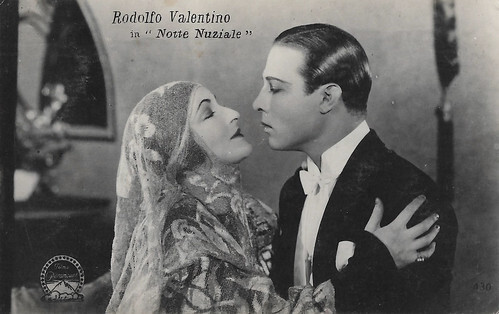
Italian postcard by Ed. Ballerini & Fratini, Florence, no. 430. Photo: Films Paramount. Rudolph Valentino and Dagmar Godowsky in A Sainted Devil (Joseph Henabery, 1924).
A splendid portrayal of a man seeing red
A Sainted Devil (1924) was directed by Joseph Henabery and produced by Adolph Zukor and Jesse Lasky. The film was made in the spring and summer of 1924 in Farmingdale on Long Island and at Paramount Studios in Astoria, New York City. The story was based on the novel 'Rope's End' by Rex Beach and adapted by Forrest Halsey. During the production, Dagmar Godowsky replaced Jetta Goudal, who repeatedly clashed with Valentino's wife, Natacha Rambova. Bebe Daniels was even replaced by Nita Naldi before filming began. As he did in Four Horsemen of the Apocalypse, Valentino plays an Argentine with a talent for the tango. The production and costuming are elaborate
The premiere took place on 17 November 1924. A week after the premiere, Mordaunt Hall wrote in The New York Times: "The narrative is told with a certain deliberation, the same tempo being sustained for its full length. There are times, however, when subtitles cover action which it would have been better to include as scenes. Then in several instances, one does not receive a clear idea of the passage of time, and here and there one perceives scenes which are introduced with tranquil poses.
Joseph Henabery, who directed this picture, has lost no little time by the inclusion of many close-ups, some of which are mere poses with little expression. Mr. Valentino is, however, a far better actor in this film than in Monsieur Beaucaire. The atmosphere evidently suits him. Toward the end of the film, he flings aside all thoughts of good looks and soft smiles and gives a splendid portrayal of a man seeing red. His rage in this sequence is most impressive, as it comes as a marked contrast to his calm bearing throughout most of the other stretches. (…) There are several fine settings in this production, and that of the hacienda is remarkably well reproduced. There is a lavish set of a cabaret, which is introduced to show the fast life Don Alanzo is leading."
However, Photoplay wrote in its review that the film "lacks force, as well as the charm of Monsieur Beaucaire. There are several reasons. Rex Beach's romance has been clumsily told and Rudy himself isn't real in his stressed emotional moments," concluding with "the story gets involved in inessentials and misses anything like a big sensation." And finally, Paimann’s Filmlisten notes: "The title, however, is interesting, but not properly chosen for the feuilletonistic but crowd-pleasing subject. In the consistently good acting, Valentino and the Naldi stand out, just as the photography achieves good effects. The presentation is picturesque and thoroughly creditable"
The same team behind A Sainted Devil (1924) - Adolph Zukor, Jesse Lasky, Joseph Henabery, cinematographer Harry Fischbeck, Rudolph Valentino, Nita Naldi) made the film Cobra immediately afterwards, but it was to prove far less successful than this production. With no prints of A Sainted Devil located in any film archives, it is considered now a lost film.
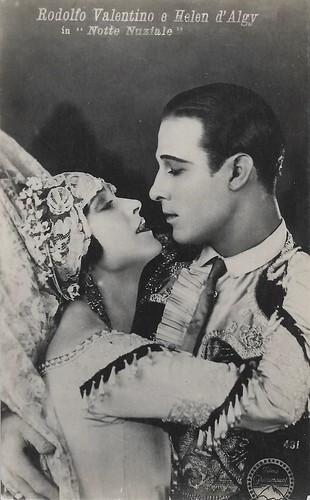
Italian postcard by Ed. Ballerini & Fratini, Florence, no. 431. Photo: Films Paramount. Rudolph Valentino and Helena d'Algy in A Sainted Devil (Joseph Henabery, 1924).
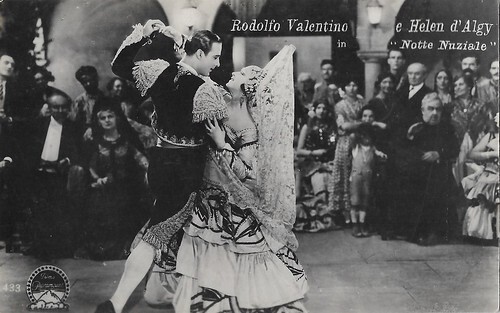
Italian postcard by Ed. Ballerini & Fratini, Florence, no. 433. Photo: Films Paramount. Rudolph Valentino and Helena d'Algy in A Sainted Devil (Joseph Henabery, 1924).
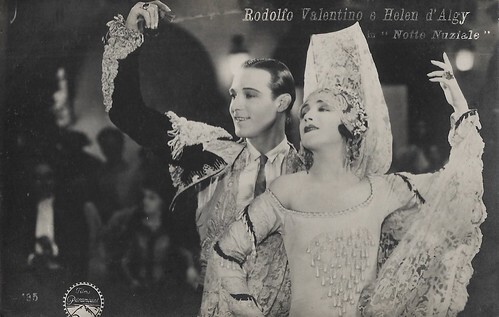
Italian postcard by Ed. Ballerini & Fratini, Florence, no. 435. Photo: Films Paramount. Rudolph Valentino and Helena d'Algy in A Sainted Devil (Joseph Henabery, 1924).
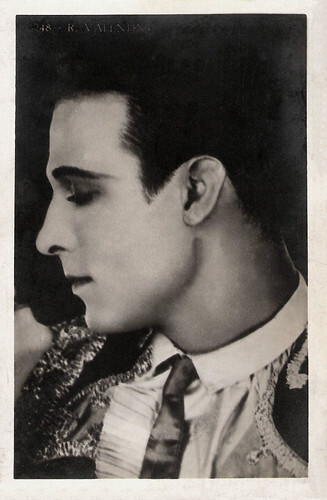
Italian postcard, no. 48. Photo: Rudolph Valentino in A Sainted Devil (Joseph Henabery, 1924).
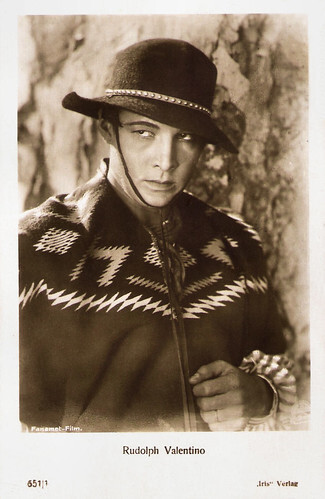
Austrian postcard by Iris Verlag, no. 651/1. Photo: Paramount-Film. Rudolph Valentino in A Sainted Devil (Joseph Henabery, 1924).
Sources: Janiss Garza (AllMovie), Wikipedia (German and English), and IMDb.

German postcard by Ross Verlag, no. 1766/2, 1927-1928. Rudolph Valentino in A Sainted Devil (Joseph Henabery, 1924).

German postcard by Ross Verlag, no. 1767/1, 1927-1928. Photo Stern Film Verleih. Rudolph Valentino and Helena D'Algy in the American silent film A Sainted Devil (Joseph Henabery, 1924).

German postcard for Ross Verlag, Berlin, no. 1767/2, 1927-1928. Photo: Famous Players-Lasky Corporation. Rudolph Valentino and Dagmar Godowsky in A Sainted Devil (Joseph Henabery, 1924).

German postcard by Ross Verlag, no. 1767/3, 1927-1928. Photo Stern Film Verleih. Rudolph Valentino and Helena D'Algy in the American silent film A Sainted Devil (Joseph Henabery, 1924).

German postcard by Verlag Ross, Berlin, no. 1766/1. Photo: Stern Film Verleih. Rudolph Valentino in A Sainted Devil (Joseph Henabery, 1924). The back of the card has writings in French. In France, the film was released as L'hacienda rouge.
Kidnapped on her wedding night
In accordance with custom, Castro arranges the marriage of his son, Don Alonzo de Castro, an attractive Latino grandee from old Spanish nobility ( Rudolph Valentino ), with Julietta (Helena or Helen D'Algy), a beautiful and lovely Argentinean woman he has never met before. She comes to the South American state for the wedding.
The lavish party is to be celebrated at de Castro's sprawling hacienda. But Alonzo has not reckoned with his ex, the fiery and hot-blooded Carlotta (Nita Naldi). The daughter of the majordomo is jealous. With her father, she teams up with El Tigre (George Siegmann), the notorious Bandido leader who has been making the area unsafe for some time. When he and his gang raid the wedding feast, the villain's sole target is the bride. A fierce fight ensues, but the nobleman is defeated and cannot prevent Julietta from being kidnapped.
Don Alonzo immediately chases after the criminals and is able to confront them in their camp, which they have set up in a ruined church. From his hiding place, the robbed groom witnesses a woman in wedding clothes embracing and kissing El Tigre. Alonzo automatically believes that this can only be his Julietta.
From now on, Alonzo and El Tigre are mortal enemies, and after another encounter, in which Don Alonzo manages to escape in an adventurous manner, the Spanish nobleman swears eternal revenge. However, Alonzo has also lost his faith in his newly wedded wife, Julietta. He cannot make sense of why this chaste girl, who was educated in a convent, throws herself so shamelessly at the neck of a proven villain. The landowner has no idea that what he really saw was Carlotta, the mastermind of this plot, throwing herself into Julietta's wedding dress and embracing the chief villain.
While Alonzo increasingly focuses all his senses on stopping El Tigre, Julietta manages to free herself a little later with the help of the dancer Carmelita ( Louise Lagrange ). The bride finds shelter in a women's convent, where she is protected from El Tigre's persecution for the time being. But Don Alonzo knows nothing of these events. More and more he threatens to mutate into an avenging angel and drunkard, unable to get over the loss of his own wife and her supposed love affair with El Tigre: a holy devil, as the film title suggests.
When Don Alonzo learns that El Tigre is supposed to be in a sinister, ill-reputed pub, the Spanish grandee seeks direct confrontation with the chief scoundrel. Here it comes to a showdown. When Alonzo enters the tavern and sees El Tigre coming down the stairs, he jumps on him without warning and is about to strangle the bandit chief. Carlotta, who is also present, lets out a sharp cry, and the groom also has to realise that a dead villain cannot tell him the whereabouts of his wife.
El Tigre uses the upper hand he thinks he has gained and is about to kill Don Alonzo when the 'haciendero' receives unexpected help from Don Luis (Antonio a.k.a. Tony D'Algy). The latter is a mortal enemy of El Tigre and cuts down the chief villain. Now Don Alonzo also learns that it was actually Carlotta who embraced and kissed El Tigre in the bandit camp. Although Carmelita, the escape helper, is in love with Don Alonzo herself, she finally reveals to him the whereabouts of his newlyweds, so that the young couple can finally embrace again and can start a new life together.

Swedish postcard by Förlag Nordisk Konst, Stockholm, no. 1324. Rudolph Valentino in A Sainted Devil (Joseph Henabery, 1924).

Italian postcard by Ed. Ballerini & Fratini, Florence, no. 428. Photo: Films Paramount. Rudolph Valentino in A Sainted Devil (Joseph Henabery, 1924).

Italian postcard by Ed. Ballerini & Fratini, Florence, no. 429. Photo: Films Paramount. Rudolph Valentino and Nita Naldi in A Sainted Devil (Joseph Henabery, 1924). The Italian title Notte nuziale translates as Wedding Night.

Italian postcard by Ed. Ballerini & Fratini, Florence, no. 430. Photo: Films Paramount. Rudolph Valentino and Dagmar Godowsky in A Sainted Devil (Joseph Henabery, 1924).
A splendid portrayal of a man seeing red
A Sainted Devil (1924) was directed by Joseph Henabery and produced by Adolph Zukor and Jesse Lasky. The film was made in the spring and summer of 1924 in Farmingdale on Long Island and at Paramount Studios in Astoria, New York City. The story was based on the novel 'Rope's End' by Rex Beach and adapted by Forrest Halsey. During the production, Dagmar Godowsky replaced Jetta Goudal, who repeatedly clashed with Valentino's wife, Natacha Rambova. Bebe Daniels was even replaced by Nita Naldi before filming began. As he did in Four Horsemen of the Apocalypse, Valentino plays an Argentine with a talent for the tango. The production and costuming are elaborate
The premiere took place on 17 November 1924. A week after the premiere, Mordaunt Hall wrote in The New York Times: "The narrative is told with a certain deliberation, the same tempo being sustained for its full length. There are times, however, when subtitles cover action which it would have been better to include as scenes. Then in several instances, one does not receive a clear idea of the passage of time, and here and there one perceives scenes which are introduced with tranquil poses.
Joseph Henabery, who directed this picture, has lost no little time by the inclusion of many close-ups, some of which are mere poses with little expression. Mr. Valentino is, however, a far better actor in this film than in Monsieur Beaucaire. The atmosphere evidently suits him. Toward the end of the film, he flings aside all thoughts of good looks and soft smiles and gives a splendid portrayal of a man seeing red. His rage in this sequence is most impressive, as it comes as a marked contrast to his calm bearing throughout most of the other stretches. (…) There are several fine settings in this production, and that of the hacienda is remarkably well reproduced. There is a lavish set of a cabaret, which is introduced to show the fast life Don Alanzo is leading."
However, Photoplay wrote in its review that the film "lacks force, as well as the charm of Monsieur Beaucaire. There are several reasons. Rex Beach's romance has been clumsily told and Rudy himself isn't real in his stressed emotional moments," concluding with "the story gets involved in inessentials and misses anything like a big sensation." And finally, Paimann’s Filmlisten notes: "The title, however, is interesting, but not properly chosen for the feuilletonistic but crowd-pleasing subject. In the consistently good acting, Valentino and the Naldi stand out, just as the photography achieves good effects. The presentation is picturesque and thoroughly creditable"
The same team behind A Sainted Devil (1924) - Adolph Zukor, Jesse Lasky, Joseph Henabery, cinematographer Harry Fischbeck, Rudolph Valentino, Nita Naldi) made the film Cobra immediately afterwards, but it was to prove far less successful than this production. With no prints of A Sainted Devil located in any film archives, it is considered now a lost film.

Italian postcard by Ed. Ballerini & Fratini, Florence, no. 431. Photo: Films Paramount. Rudolph Valentino and Helena d'Algy in A Sainted Devil (Joseph Henabery, 1924).

Italian postcard by Ed. Ballerini & Fratini, Florence, no. 433. Photo: Films Paramount. Rudolph Valentino and Helena d'Algy in A Sainted Devil (Joseph Henabery, 1924).

Italian postcard by Ed. Ballerini & Fratini, Florence, no. 435. Photo: Films Paramount. Rudolph Valentino and Helena d'Algy in A Sainted Devil (Joseph Henabery, 1924).

Italian postcard, no. 48. Photo: Rudolph Valentino in A Sainted Devil (Joseph Henabery, 1924).

Austrian postcard by Iris Verlag, no. 651/1. Photo: Paramount-Film. Rudolph Valentino in A Sainted Devil (Joseph Henabery, 1924).
Sources: Janiss Garza (AllMovie), Wikipedia (German and English), and IMDb.
Published on December 11, 2022 22:00
December 10, 2022
Adele Jergens
Glamorous Adele Jergens (1917-2002) was an American film actress of the 1940s and 1950s who was often cast in B-films as blonde floozies and burlesque dancers.

British card. Photo: Columbia. Publicity still for A Thousand and One Nights (Alfred E. Green, 1945).
The Number One Showgirl in New York City
Adele Jergens was born Adele Louisa Jurgens in Brooklyn, New York, in 1917 (her birth date is sometimes listed as 1922). She was the youngest of four to working-class Norwegian parents. She graduated from Grover Cleveland High School and received a scholarship to study at a Manhattan dance studio.
Jergens first rose to prominence in the late 1930s, when she danced in the Moss Hart/Cole Porter musical 'Jubilee!', and was named Miss World's Fairest at the 1939 New York World's Fair. In the early 1940s, she worked as a model and chorus girl, including a short stint as a Rockette, and was dubbed "The Champagne Blonde", "The Girl with the Million Dollar Legs", and even "The Number One Showgirl in New York City".
In the burlesque revue 'Star and Garter' (1942), Adele had a featured role while understudying one of its headliners, Gypsy Rose Lee. She went on for Ms. Lee, and Hollywood took immediate notice with Twentieth Century-Fox signing her up. Adele started at the bottom rank at Fox with decorative showgirl or good-time girl parts in the musicals Hello Frisco, Hello (H. Bruce Humberstone, 1943), Sweet Rosie O'Grady (Irving Cummings, 1943), and The Gang's All Here (Busby Berkeley, 1943).
When Fox dropped her option, she was snatched up by Columbia in a seven-year contract. She was entrusted with the lead female role as Princess Armina of Baghdad in the Eastern adventure A Thousand and One Nights (Alfred E. Green, 1945) starring Phil Silvers and handsome Cornel Wilde as Aladdin.
Brunette Jergens became a blonde and displayed a brusque comic flair as the aptly-named Allura in the Rosalind Russell comedy She Wouldn't Say Yes (Alexander Hall, 1945). She played a hilariously-accented blonde briefly competing for Russell's man Lee Bowman. Adele also top-lined her own musical albeit the quickly forgotten When a Girl's Beautiful (Frank McDonald, 1947) which co-starred Marc Platt and Stephen Dunne.
She was cast as blonde floozies and burlesque dancers in such films as Down to Earth (Alexander Hall, 1947) starring Rita Hayworth and The Dark Past (Rudolph Maté, 1948) starring William Holden . Gary Brumburgh describes her aptly at IMDb as: "the tough-talking, plump-cheeked peroxide blonde who gave her fair share of tawdry trouble in backstage dramas, film noir, crime potboilers, and adventure yarns."

Spanish postcard by Archivo Bermejo, Barcelona, no. 4201 A. Sent by mail in 1949. Photo: Columbia Pictures. Adele Jergens and Cornel Wilde in A Thousand and One Nights (Alfred E. Green, 1945). The Spanish title is Aladino o la lampara maravillosa.
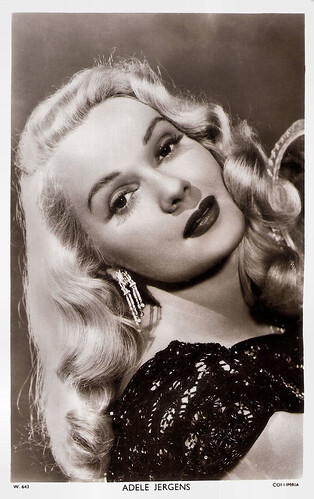
British postcard in Picturegoer Series, London, no. W 643. Photo: Columbia.
Hard-as-nails babes that did leave an impression
Adele Jergens played Marilyn Monroe 's mother in Ladies of the Chorus (Phil Karlson, 1948) despite being only 9 years older than Monroe. In 1949, Jergens met and married actor Glenn Langan, while filming Treasure of Monte Cristo (William Berke, 1949), a Film Noir set in San Francisco. They had one child, a son named Tracy Langan, who eventually worked in Hollywood behind the scenes, as a film technician.
She played an exotic dancer in Armored Car Robbery (Richard Fleischer, 1950) and also appeared in Bud Abbott and Lou Costello Meet the Invisible Man (Charles Lamont, 1951). She had a part in The Cobweb (Vincente Minnelli, 1955) starring Richard Widmark and Lauren Bacall .
She also worked in the 1950s radio show 'Stand By For Crime' as 'Glamourpuss' Carol Curtis with her husband Glenn Langan as Chuck Morgan. Adele Jergens-Langan retired from the screen in 1956. She and Langan remained married until his death from lymphoma, in 1991.
In 2001, their son, 48-year-old Tracy Langan died of a brain tumour. This devastated the actress and her health declined quickly after her son's death. Adele Jergens died the following year of pneumonia, just days before her 85th birthday. She was buried beside her husband and son at Oakwood Memorial Park Cemetery in Chatsworth, California, under the headstone marked 'Langan'.
Gary Brumburgh at IMDb : "She was (...) headstrong at trying to bust out of the chorus lines and cheesecake parts to become a topnotch 'A' actress draw. She failed in the latter but nevertheless left a respectable Hollywood legacy for the host of hard-as-nails babes that did leave an impression."
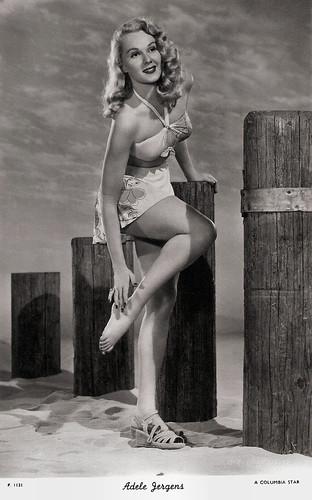
British postcard in The People Series by Show Parade Picture Service, London, no. P. 1131. Photo: Columbia. Publicity still for Beware of Blondie (Edward Bernds, 1950).
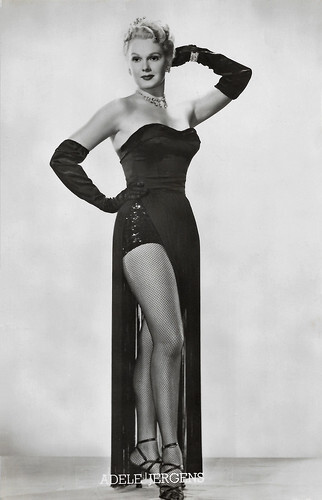
Vintage postcard, no. 951. Photo: R.K.O.
Sources: (IMDb), Wikipedia and .

British card. Photo: Columbia. Publicity still for A Thousand and One Nights (Alfred E. Green, 1945).
The Number One Showgirl in New York City
Adele Jergens was born Adele Louisa Jurgens in Brooklyn, New York, in 1917 (her birth date is sometimes listed as 1922). She was the youngest of four to working-class Norwegian parents. She graduated from Grover Cleveland High School and received a scholarship to study at a Manhattan dance studio.
Jergens first rose to prominence in the late 1930s, when she danced in the Moss Hart/Cole Porter musical 'Jubilee!', and was named Miss World's Fairest at the 1939 New York World's Fair. In the early 1940s, she worked as a model and chorus girl, including a short stint as a Rockette, and was dubbed "The Champagne Blonde", "The Girl with the Million Dollar Legs", and even "The Number One Showgirl in New York City".
In the burlesque revue 'Star and Garter' (1942), Adele had a featured role while understudying one of its headliners, Gypsy Rose Lee. She went on for Ms. Lee, and Hollywood took immediate notice with Twentieth Century-Fox signing her up. Adele started at the bottom rank at Fox with decorative showgirl or good-time girl parts in the musicals Hello Frisco, Hello (H. Bruce Humberstone, 1943), Sweet Rosie O'Grady (Irving Cummings, 1943), and The Gang's All Here (Busby Berkeley, 1943).
When Fox dropped her option, she was snatched up by Columbia in a seven-year contract. She was entrusted with the lead female role as Princess Armina of Baghdad in the Eastern adventure A Thousand and One Nights (Alfred E. Green, 1945) starring Phil Silvers and handsome Cornel Wilde as Aladdin.
Brunette Jergens became a blonde and displayed a brusque comic flair as the aptly-named Allura in the Rosalind Russell comedy She Wouldn't Say Yes (Alexander Hall, 1945). She played a hilariously-accented blonde briefly competing for Russell's man Lee Bowman. Adele also top-lined her own musical albeit the quickly forgotten When a Girl's Beautiful (Frank McDonald, 1947) which co-starred Marc Platt and Stephen Dunne.
She was cast as blonde floozies and burlesque dancers in such films as Down to Earth (Alexander Hall, 1947) starring Rita Hayworth and The Dark Past (Rudolph Maté, 1948) starring William Holden . Gary Brumburgh describes her aptly at IMDb as: "the tough-talking, plump-cheeked peroxide blonde who gave her fair share of tawdry trouble in backstage dramas, film noir, crime potboilers, and adventure yarns."

Spanish postcard by Archivo Bermejo, Barcelona, no. 4201 A. Sent by mail in 1949. Photo: Columbia Pictures. Adele Jergens and Cornel Wilde in A Thousand and One Nights (Alfred E. Green, 1945). The Spanish title is Aladino o la lampara maravillosa.

British postcard in Picturegoer Series, London, no. W 643. Photo: Columbia.
Hard-as-nails babes that did leave an impression
Adele Jergens played Marilyn Monroe 's mother in Ladies of the Chorus (Phil Karlson, 1948) despite being only 9 years older than Monroe. In 1949, Jergens met and married actor Glenn Langan, while filming Treasure of Monte Cristo (William Berke, 1949), a Film Noir set in San Francisco. They had one child, a son named Tracy Langan, who eventually worked in Hollywood behind the scenes, as a film technician.
She played an exotic dancer in Armored Car Robbery (Richard Fleischer, 1950) and also appeared in Bud Abbott and Lou Costello Meet the Invisible Man (Charles Lamont, 1951). She had a part in The Cobweb (Vincente Minnelli, 1955) starring Richard Widmark and Lauren Bacall .
She also worked in the 1950s radio show 'Stand By For Crime' as 'Glamourpuss' Carol Curtis with her husband Glenn Langan as Chuck Morgan. Adele Jergens-Langan retired from the screen in 1956. She and Langan remained married until his death from lymphoma, in 1991.
In 2001, their son, 48-year-old Tracy Langan died of a brain tumour. This devastated the actress and her health declined quickly after her son's death. Adele Jergens died the following year of pneumonia, just days before her 85th birthday. She was buried beside her husband and son at Oakwood Memorial Park Cemetery in Chatsworth, California, under the headstone marked 'Langan'.
Gary Brumburgh at IMDb : "She was (...) headstrong at trying to bust out of the chorus lines and cheesecake parts to become a topnotch 'A' actress draw. She failed in the latter but nevertheless left a respectable Hollywood legacy for the host of hard-as-nails babes that did leave an impression."

British postcard in The People Series by Show Parade Picture Service, London, no. P. 1131. Photo: Columbia. Publicity still for Beware of Blondie (Edward Bernds, 1950).

Vintage postcard, no. 951. Photo: R.K.O.
Sources: (IMDb), Wikipedia and .
Published on December 10, 2022 22:00
December 9, 2022
Directed by Mauritz Stiller
Director Mauritz Stiller (1883-1928) was next to Victor Sjöström, the greatest director of Swedish cinema's golden age. He wrote and directed 51 silent films since 1912. When Metro-Goldwyn-Mayer invited him to Hollywood as a director, he arrived with his new discovery Greta Gustafsson, now better known as Greta Garbo. After frequent disagreements with MGM and Paramount Pictures studio executives, Stiller returned to Sweden, where he died soon afterwards.
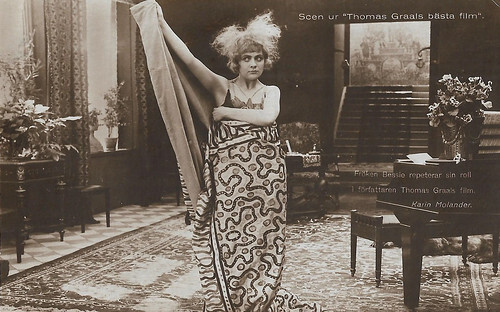
Swedish postcard by Ed. Nordisk Konst, Stockholm, no. 876. Photo: Svenska Biografteatern AB. Karin Molander vamping in Thomas Graals bästa film/Thomas Graal's Best Film (Mauritz Stiller, 1917), scripted by Gustav Molander. The story deals with a screenwriter ( Victor Sjöström ) who falls in love with his secretary Bessie ( Karin Molander ) and imagines himself rescuing her from poverty. Reality is quite different as Bessie is a modern woman. The film also mocks the bored aristocracy involved in the modernity of filmmaking. Caption: Miss Bessie is practising her role in the writer Thomas Graal's film.
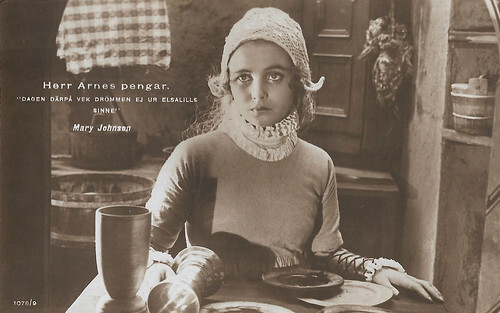
Swedish postcard by Nordisk Konst, Stockholm, no. 1078/9. Photo: Svenska Biografteatern. Mary Johnson in Herr Arnes pengar/Sir Arne's Treasure (Mauritz Stiller, 1919). Caption: The next day the dream did not leave Elsalill's mind.
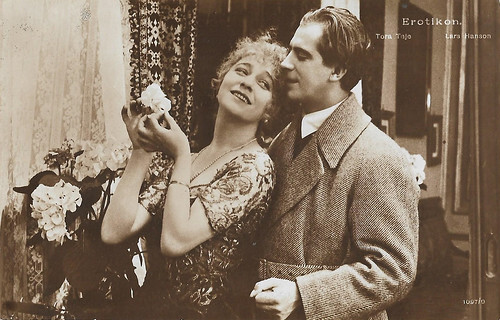
Swedish postcard by Nordisk Konst, Stockholm, no. 1097/9. Tora Teje and Lars Hanson in Erotikon (Mauritz Stiller, 1920).
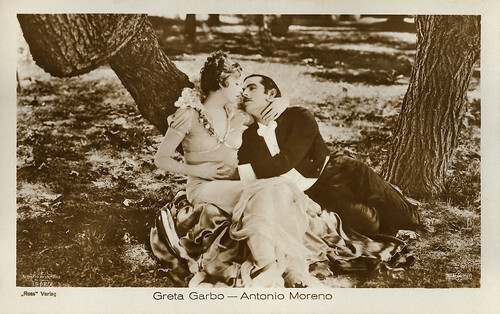
German postcard by Ross Verlag, no. 3062/2, 1928-1929. Photo: Metro-Goldwyn-Mayer / Parufamet. Greta Garbo and Antonio Moreno in The Temptress (Fred Niblo, Mauritz Stiller, 1926).
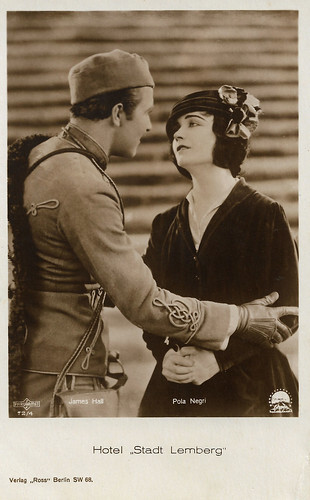
German postcard by Ross Verlag, Berlin, no. 72/4. Photo: ParUfaMet / Paramount. James Hall and Pola Negri in Hotel Imperial (Mauritz Stiller, 1927). The German film title was Hotel "Stadt Lemberg".
Involved with Sweden's rapidly developing silent film industry
Mauritz Stiller was born Moshe Stiller in Helsingfors (now Helsinki) in 1883. He was one of the six children of Hirsch Stiller and his wife Mindel (née Weissenberg). His family was of Ashkenazi Jewish heritage. Before settling in Finland, they had lived in Russia and Poland, then part of the Russian Empire.
After his father's death when he was four, his mother committed suicide. A family friend, the tailor Peretz Katsman, raised him and Mauritz began working for him at the age of 13. From an early age, Stiller was interested in acting. His talents did not go unnoticed, and soon Stiller got the opportunity to practice and display his acting skills in the Folkteatern of Helsingfors and other theatres in Finland.
Finland was at the time an autonomous Grand Duchy of Finland, part of Russia, and Stiller was drafted into the army of Czar Nicholas II. Rather than report for duty he fled the country for exile and settled in Sweden. He became a Swedish citizen in 1921. By 1912, Stiller had become involved with Sweden's rapidly developing silent film industry.
Together with actor-director Viktor Sjöström , he was recruited as a director and actor in the Swedish film industry by Charles Magnusson at AB Svenska Biografteatern. Stiller began by writing scripts, acting, and directing short films and was immediately successful. Soon he gave up acting to devote his time to writing and directing.
During 1912-1916 he directed no less than 34 films, in different genres. The most remarkable early film was Vingarne/The Wings (1916), an adaptation of Danish writer Herman Bang’s novel ‘Mikael’. Stiller added a framing structure to the story, showing the production of the film itself and how it is received by critics and the audience.
This self-reflexive element is also present in Stiller’s comedies Thomas Graals bästa film/Thomas Graal’s Best Film (1917) and Thomas Graals bästa barn/Thomas Graal’s Best Child (1918), both starring Victor Sjöström in the title role opposite Karin Molander . Both films received much acclaim and were very popular.

Swedish postcard by Ed. Nordisk Konst, Stockholm, no. 876/8. Photo: Svenska Biografteatern AB. Publicity still for Thomas Graals bästa film/Thomas Graal's Best Film (Mauritz Stiller, 1917), scripted by Gustav Molander. The story deals with a screenwriter ( Victor Sjöström ) who falls in love with his secretary Bessie ( Karin Molander ) and imagines himself rescuing her from poverty. Reality is quite different as Bessie is a modern woman. The film also mocks the bored aristocracy involved in the modernity of filmmaking. Caption: The newly engaged ones.
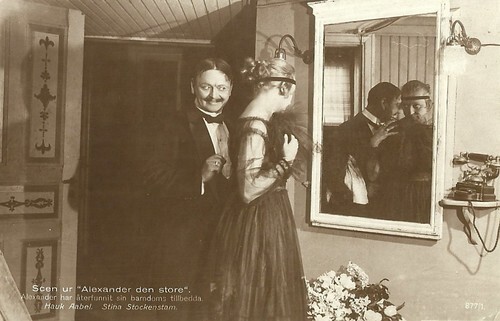
Swedish postcard by Nordisk Konst, Stockholm, no. 877/1. Photo: Svenska Biografteatern AB. Hauk Aabel and Stina Stockenstam in the comedy Alexander den Store/Alexander the Great (Mauritz Stiller, 1917) with . The story of the film deals with a provincial hotel cook, named Alexander the Great, in whose restaurant not only the dishes can be spicy. Caption: Alexander has rediscovered his beloved from his youth.
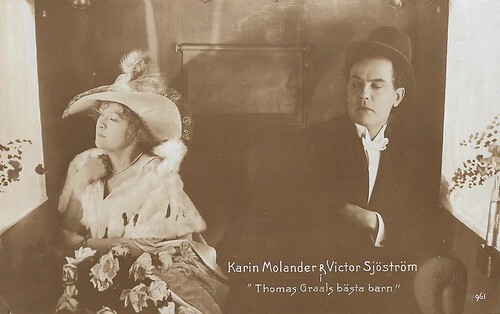
Swedish postcard by Förlag Nordisk Konst, Stockholm, no. 961. Photo: Svenska Biografteatern. Victor Sjöström and Karin Molander in the comedy Thomas Graals bästa barn/Thomas Graal's First Child (Mauritz Stiller, 1918).
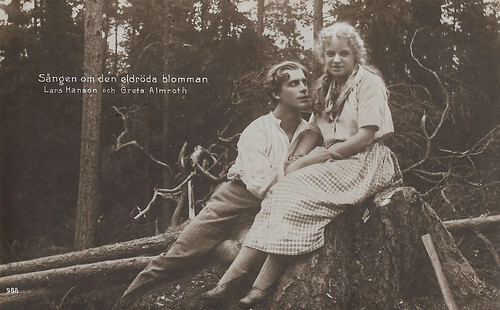
Swedish postcard by Forlag Nordisk Konst, Stockholm, no. 988. Photo: Svenska Biografteatern, Stockholm. Lars Hanson and Greta Amroth in Sången om den eldröda blomman/Song of the Scarlet Flower (Mauritz Stiller, 1919).
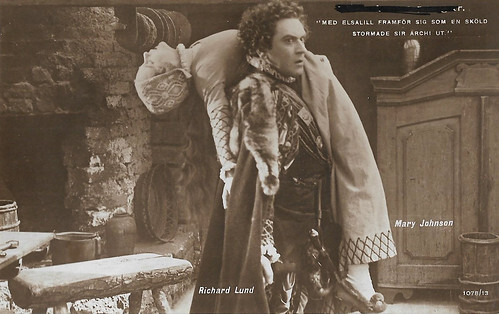
Swedish postcard by Nordisk Konst, Stockholm, no. 1078/3. Photo: Svenska Biografteatern. Richard Lund and Mary Johnson in Herr Arnes pengar/Sir Arne's Treasure (Mauritz Stiller, 1919). Caption: With Elsallil before him like a shield, Sir Archi stormed out.
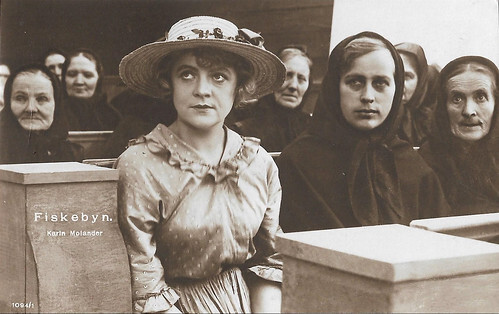
Swedish postcard by Förlag Nordisk Konst, Stockholm, no. 1094/1. Photo: Svenska. Karin Molander in Fiskebyn/Chains/The Fishing Village (Mauritz Stiller, 1920).
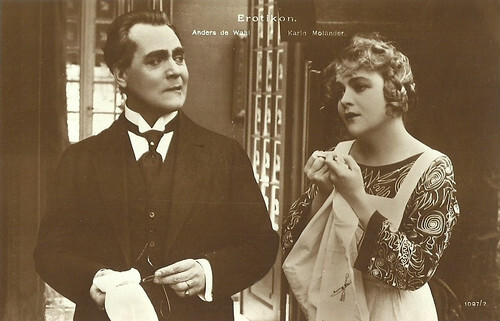
Swedish postcard by Nordisk Konst, Stockholm, no. 1097/2. Anders de Wahl and Karin Molander in Erotikon (Mauritz Stiller, 1920).
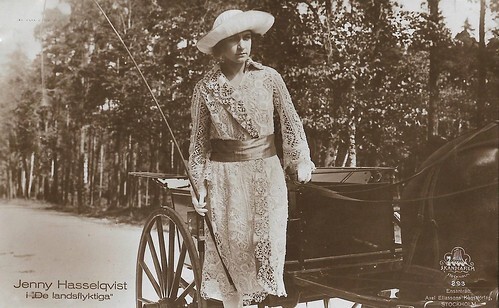
Swedish postcard by Ed. Axel Eliassons Konstförlag, Stockholm, no. 293. Photo: Skandia Film, Stockholm. Jenny Hasselquist in De landsflyktiga/The Emigrants/The Exiles (Mauritz Stiller, 1921). This is a lost film, except for a few very short fragments.
Continuing disagreements with Hollywood studio executives
By 1920, Mauritz Stiller was a leading figure in Swedish filmmaking. His masterpieces were the Selma Lagerlöf adaptation Herr Arnes pengar/Sir Arne's Treasure (1919) with Richard Lund and Mary Johnson and the stylish comedy Erotikon (1920) with Tora Teje and Lars Hanson .
Jon Wengström writes in The Swedish Film Database : “The characteristic trait in Swedish silent films at the time, the interaction between Man and Nature, was taken to new heights by Stiller in Sången om den eldröda blomman/Song of the Scarlet Flower (1919) and Johan (1921). Both films were shot on location in northern Sweden, and both had spectacular downstream log-riding sequences as dramatic climaxes.”
He also directed Gunnar Hedes saga/Snowbound (1923) starring a young Einar Hanson and based on the Selma Lagerlöf novel ‘En herrgårdssägen’. At the Royal Dramatic Theatre in Stockholm, he met a young actress named Greta Gustafsson whom he cast in an important but secondary role in his film, Gösta Berlings saga/The Atonement of Gosta Berling (1924), featuring Lars Hanson and also a Selma Lagerlöf adaptation.
In 1924, Mauritz Stiller planned to shoot a film in Turkey titled The Odalisque from Smyrna and hired Conrad Veidt and Einar Hanson as stars. Along with Hansen and protégée Greta Gustafsson , Stiller left for Istanbul but the promised financing vanished. They moved to Germany, where Greta appeared in Die Freudlose Gasse (G.W. Pabst, 1925). Then they sailed with Einar Hanson off to the USA.
Stiller had accepted an offer from Louis B. Mayer to direct for Metro-Goldwyn-Mayer. In Hollywood, MGM assigned Stiller to direct Greta Gustafsson as Greta Garbo in her second American film, The Temptress (1926), but he could not deal with the studio structure. After repeated arguments with studio executives, MGM replaced him on the film with Fred Niblo and terminated his contract with the studio.
Paramount Pictures immediately hired Stiller. He made three successful films, The Woman on Trial (1927), Hotel Imperial (1927) and Barbed Wire (1927), all starring Pola Negri . Then Stiller was let go a second time while directing his fourth film, The Street of Sin (1928), starring Emil Jannings and Fay Wray , because of his continuing disagreements with studio bosses.
Mauritz Stiller returned to Sweden in 1927 and died the following year from pleurisy at the age of 45. Garbo was devastated when she heard the news. He was interred in the Norra begravningsplatsen in Stockholm. Mauritz Stiller directed 51 silent films and appeared as an actor in seven productions from 1912 to 1927. In 1960, Hollywood recognised Stiller's contribution to the motion picture industry with a star on the Hollywood Walk of Fame at 1713 Vine Street. Originally his star was listed erroneously as "Maurice Diller" but it was finally corrected in the late 1980s. In Kristianstad, a monument was erected in his honour.
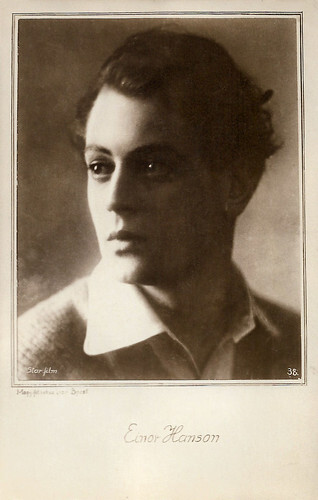
Hungarian postcard by Magy. fot. soksz ipar, Budapest, no. 38. Photo: Starfilm. Einar Hanson in Gunnar Hedes saga/Snowbound (Mauritz Stiller, 1923).
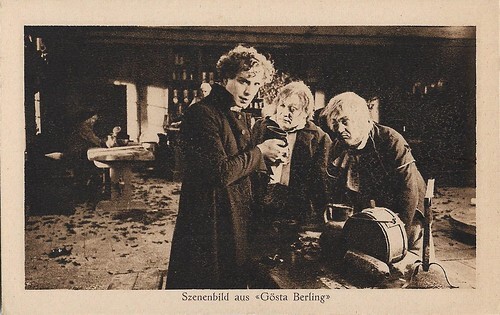
German postcard. Photo: Svenska Film of the Trianon-Film-Konzern, Berlin (also in Leipzig, Frankfurt a.M., Düsseldorf and Hamburg). Lars Hanson in Gösta Berlings saga/The Saga of Gösta Berling (Mauritz Stiller, 1924). The film was an adaptation of the famous novel by Selma Lagerlöf. The cinematography was by Julius Jaenzon, and the art direction was by Vilhelm Bryde (with Edgar Ulmer collaborating on the set design). This postcard was made by Trianon for the German premiere of the film on 20 August 1924, at the Berlin Theater am Nollendorfplatz.
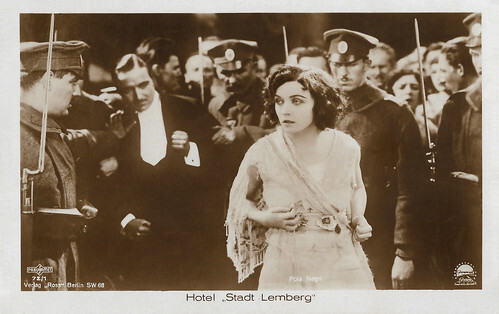
German postcard by Ross Verlag, Berlin, no. 72/1. Photo: Parufamet / Paramount. Pola Negri in Hotel Imperial (Mauritz Stiller, 1927).
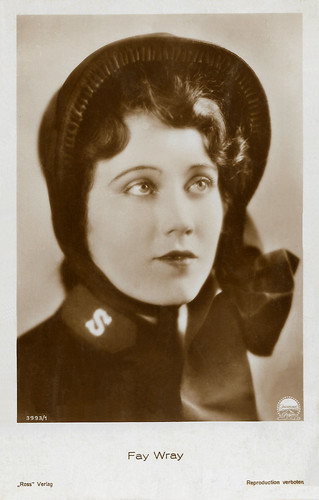
German postcard by Ross Verlag, no. 3993/1, 1928-1929. Photo: Paramount. Fay Wray in Street of Sin (Mauritz Stiller, 1928).
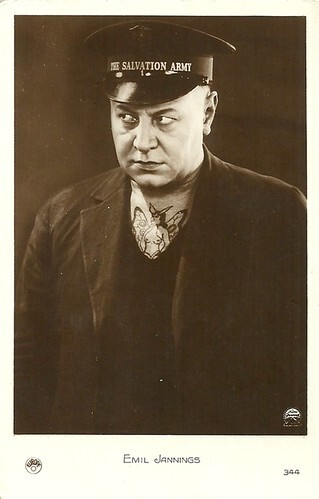
French postcard by Europe, no. 344. Emil Jannings in The Street of Sin (Mauritz Stiller, 1928).
Sources: Jon Wengström (The Swedish Film Database), (IMDb), Sandra Brennan (AllMovie), Wikipedia (English and Swedish), and .

Swedish postcard by Ed. Nordisk Konst, Stockholm, no. 876. Photo: Svenska Biografteatern AB. Karin Molander vamping in Thomas Graals bästa film/Thomas Graal's Best Film (Mauritz Stiller, 1917), scripted by Gustav Molander. The story deals with a screenwriter ( Victor Sjöström ) who falls in love with his secretary Bessie ( Karin Molander ) and imagines himself rescuing her from poverty. Reality is quite different as Bessie is a modern woman. The film also mocks the bored aristocracy involved in the modernity of filmmaking. Caption: Miss Bessie is practising her role in the writer Thomas Graal's film.

Swedish postcard by Nordisk Konst, Stockholm, no. 1078/9. Photo: Svenska Biografteatern. Mary Johnson in Herr Arnes pengar/Sir Arne's Treasure (Mauritz Stiller, 1919). Caption: The next day the dream did not leave Elsalill's mind.

Swedish postcard by Nordisk Konst, Stockholm, no. 1097/9. Tora Teje and Lars Hanson in Erotikon (Mauritz Stiller, 1920).

German postcard by Ross Verlag, no. 3062/2, 1928-1929. Photo: Metro-Goldwyn-Mayer / Parufamet. Greta Garbo and Antonio Moreno in The Temptress (Fred Niblo, Mauritz Stiller, 1926).

German postcard by Ross Verlag, Berlin, no. 72/4. Photo: ParUfaMet / Paramount. James Hall and Pola Negri in Hotel Imperial (Mauritz Stiller, 1927). The German film title was Hotel "Stadt Lemberg".
Involved with Sweden's rapidly developing silent film industry
Mauritz Stiller was born Moshe Stiller in Helsingfors (now Helsinki) in 1883. He was one of the six children of Hirsch Stiller and his wife Mindel (née Weissenberg). His family was of Ashkenazi Jewish heritage. Before settling in Finland, they had lived in Russia and Poland, then part of the Russian Empire.
After his father's death when he was four, his mother committed suicide. A family friend, the tailor Peretz Katsman, raised him and Mauritz began working for him at the age of 13. From an early age, Stiller was interested in acting. His talents did not go unnoticed, and soon Stiller got the opportunity to practice and display his acting skills in the Folkteatern of Helsingfors and other theatres in Finland.
Finland was at the time an autonomous Grand Duchy of Finland, part of Russia, and Stiller was drafted into the army of Czar Nicholas II. Rather than report for duty he fled the country for exile and settled in Sweden. He became a Swedish citizen in 1921. By 1912, Stiller had become involved with Sweden's rapidly developing silent film industry.
Together with actor-director Viktor Sjöström , he was recruited as a director and actor in the Swedish film industry by Charles Magnusson at AB Svenska Biografteatern. Stiller began by writing scripts, acting, and directing short films and was immediately successful. Soon he gave up acting to devote his time to writing and directing.
During 1912-1916 he directed no less than 34 films, in different genres. The most remarkable early film was Vingarne/The Wings (1916), an adaptation of Danish writer Herman Bang’s novel ‘Mikael’. Stiller added a framing structure to the story, showing the production of the film itself and how it is received by critics and the audience.
This self-reflexive element is also present in Stiller’s comedies Thomas Graals bästa film/Thomas Graal’s Best Film (1917) and Thomas Graals bästa barn/Thomas Graal’s Best Child (1918), both starring Victor Sjöström in the title role opposite Karin Molander . Both films received much acclaim and were very popular.

Swedish postcard by Ed. Nordisk Konst, Stockholm, no. 876/8. Photo: Svenska Biografteatern AB. Publicity still for Thomas Graals bästa film/Thomas Graal's Best Film (Mauritz Stiller, 1917), scripted by Gustav Molander. The story deals with a screenwriter ( Victor Sjöström ) who falls in love with his secretary Bessie ( Karin Molander ) and imagines himself rescuing her from poverty. Reality is quite different as Bessie is a modern woman. The film also mocks the bored aristocracy involved in the modernity of filmmaking. Caption: The newly engaged ones.

Swedish postcard by Nordisk Konst, Stockholm, no. 877/1. Photo: Svenska Biografteatern AB. Hauk Aabel and Stina Stockenstam in the comedy Alexander den Store/Alexander the Great (Mauritz Stiller, 1917) with . The story of the film deals with a provincial hotel cook, named Alexander the Great, in whose restaurant not only the dishes can be spicy. Caption: Alexander has rediscovered his beloved from his youth.

Swedish postcard by Förlag Nordisk Konst, Stockholm, no. 961. Photo: Svenska Biografteatern. Victor Sjöström and Karin Molander in the comedy Thomas Graals bästa barn/Thomas Graal's First Child (Mauritz Stiller, 1918).

Swedish postcard by Forlag Nordisk Konst, Stockholm, no. 988. Photo: Svenska Biografteatern, Stockholm. Lars Hanson and Greta Amroth in Sången om den eldröda blomman/Song of the Scarlet Flower (Mauritz Stiller, 1919).

Swedish postcard by Nordisk Konst, Stockholm, no. 1078/3. Photo: Svenska Biografteatern. Richard Lund and Mary Johnson in Herr Arnes pengar/Sir Arne's Treasure (Mauritz Stiller, 1919). Caption: With Elsallil before him like a shield, Sir Archi stormed out.

Swedish postcard by Förlag Nordisk Konst, Stockholm, no. 1094/1. Photo: Svenska. Karin Molander in Fiskebyn/Chains/The Fishing Village (Mauritz Stiller, 1920).

Swedish postcard by Nordisk Konst, Stockholm, no. 1097/2. Anders de Wahl and Karin Molander in Erotikon (Mauritz Stiller, 1920).

Swedish postcard by Ed. Axel Eliassons Konstförlag, Stockholm, no. 293. Photo: Skandia Film, Stockholm. Jenny Hasselquist in De landsflyktiga/The Emigrants/The Exiles (Mauritz Stiller, 1921). This is a lost film, except for a few very short fragments.
Continuing disagreements with Hollywood studio executives
By 1920, Mauritz Stiller was a leading figure in Swedish filmmaking. His masterpieces were the Selma Lagerlöf adaptation Herr Arnes pengar/Sir Arne's Treasure (1919) with Richard Lund and Mary Johnson and the stylish comedy Erotikon (1920) with Tora Teje and Lars Hanson .
Jon Wengström writes in The Swedish Film Database : “The characteristic trait in Swedish silent films at the time, the interaction between Man and Nature, was taken to new heights by Stiller in Sången om den eldröda blomman/Song of the Scarlet Flower (1919) and Johan (1921). Both films were shot on location in northern Sweden, and both had spectacular downstream log-riding sequences as dramatic climaxes.”
He also directed Gunnar Hedes saga/Snowbound (1923) starring a young Einar Hanson and based on the Selma Lagerlöf novel ‘En herrgårdssägen’. At the Royal Dramatic Theatre in Stockholm, he met a young actress named Greta Gustafsson whom he cast in an important but secondary role in his film, Gösta Berlings saga/The Atonement of Gosta Berling (1924), featuring Lars Hanson and also a Selma Lagerlöf adaptation.
In 1924, Mauritz Stiller planned to shoot a film in Turkey titled The Odalisque from Smyrna and hired Conrad Veidt and Einar Hanson as stars. Along with Hansen and protégée Greta Gustafsson , Stiller left for Istanbul but the promised financing vanished. They moved to Germany, where Greta appeared in Die Freudlose Gasse (G.W. Pabst, 1925). Then they sailed with Einar Hanson off to the USA.
Stiller had accepted an offer from Louis B. Mayer to direct for Metro-Goldwyn-Mayer. In Hollywood, MGM assigned Stiller to direct Greta Gustafsson as Greta Garbo in her second American film, The Temptress (1926), but he could not deal with the studio structure. After repeated arguments with studio executives, MGM replaced him on the film with Fred Niblo and terminated his contract with the studio.
Paramount Pictures immediately hired Stiller. He made three successful films, The Woman on Trial (1927), Hotel Imperial (1927) and Barbed Wire (1927), all starring Pola Negri . Then Stiller was let go a second time while directing his fourth film, The Street of Sin (1928), starring Emil Jannings and Fay Wray , because of his continuing disagreements with studio bosses.
Mauritz Stiller returned to Sweden in 1927 and died the following year from pleurisy at the age of 45. Garbo was devastated when she heard the news. He was interred in the Norra begravningsplatsen in Stockholm. Mauritz Stiller directed 51 silent films and appeared as an actor in seven productions from 1912 to 1927. In 1960, Hollywood recognised Stiller's contribution to the motion picture industry with a star on the Hollywood Walk of Fame at 1713 Vine Street. Originally his star was listed erroneously as "Maurice Diller" but it was finally corrected in the late 1980s. In Kristianstad, a monument was erected in his honour.

Hungarian postcard by Magy. fot. soksz ipar, Budapest, no. 38. Photo: Starfilm. Einar Hanson in Gunnar Hedes saga/Snowbound (Mauritz Stiller, 1923).

German postcard. Photo: Svenska Film of the Trianon-Film-Konzern, Berlin (also in Leipzig, Frankfurt a.M., Düsseldorf and Hamburg). Lars Hanson in Gösta Berlings saga/The Saga of Gösta Berling (Mauritz Stiller, 1924). The film was an adaptation of the famous novel by Selma Lagerlöf. The cinematography was by Julius Jaenzon, and the art direction was by Vilhelm Bryde (with Edgar Ulmer collaborating on the set design). This postcard was made by Trianon for the German premiere of the film on 20 August 1924, at the Berlin Theater am Nollendorfplatz.

German postcard by Ross Verlag, Berlin, no. 72/1. Photo: Parufamet / Paramount. Pola Negri in Hotel Imperial (Mauritz Stiller, 1927).

German postcard by Ross Verlag, no. 3993/1, 1928-1929. Photo: Paramount. Fay Wray in Street of Sin (Mauritz Stiller, 1928).

French postcard by Europe, no. 344. Emil Jannings in The Street of Sin (Mauritz Stiller, 1928).
Sources: Jon Wengström (The Swedish Film Database), (IMDb), Sandra Brennan (AllMovie), Wikipedia (English and Swedish), and .
Published on December 09, 2022 22:00
Paul van Yperen's Blog
- Paul van Yperen's profile
- 13 followers
Paul van Yperen isn't a Goodreads Author
(yet),
but they
do have a blog,
so here are some recent posts imported from
their feed.



